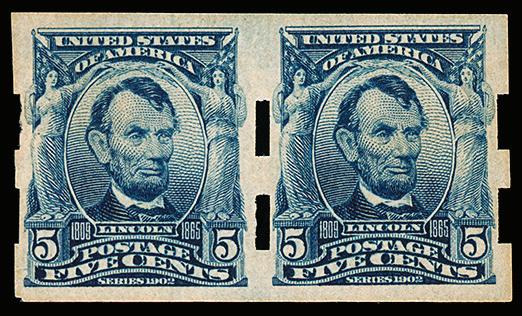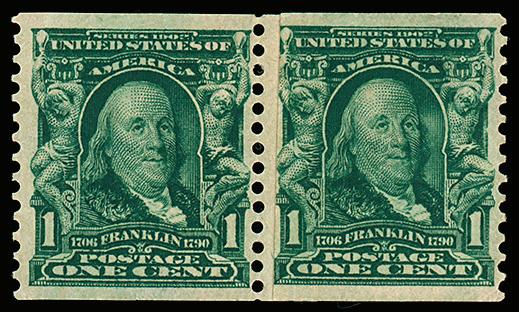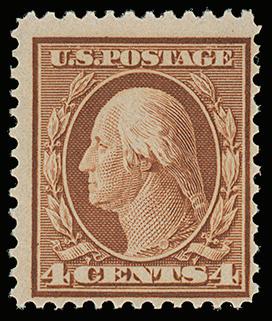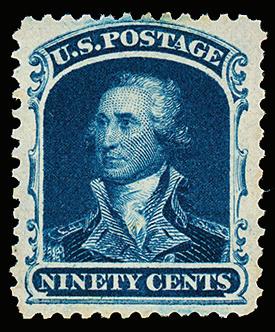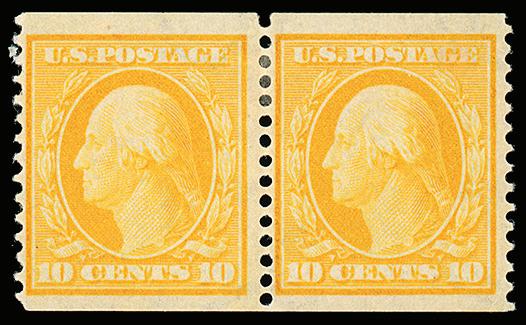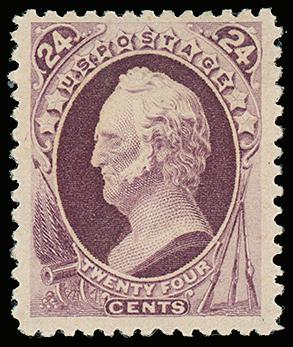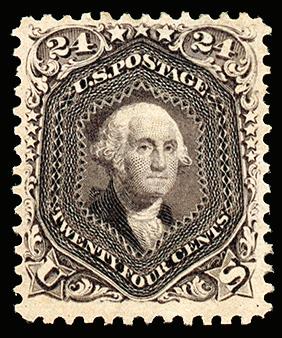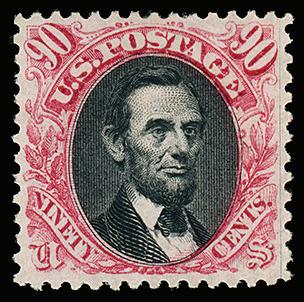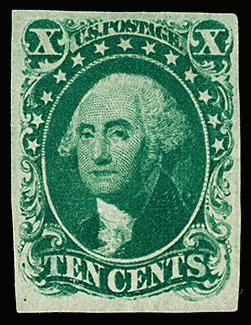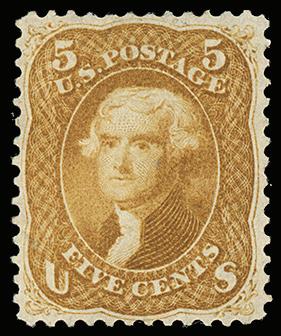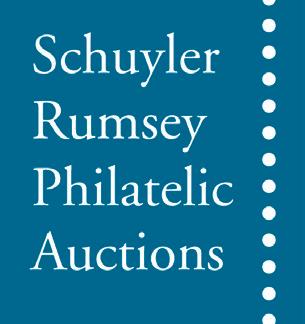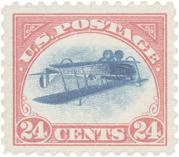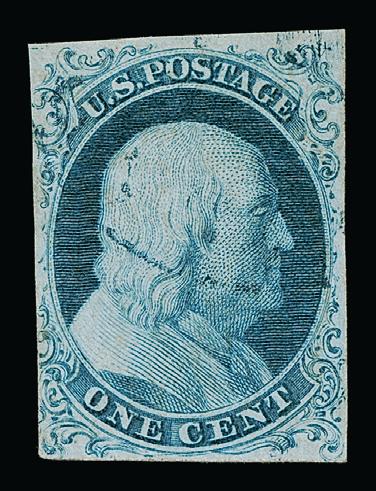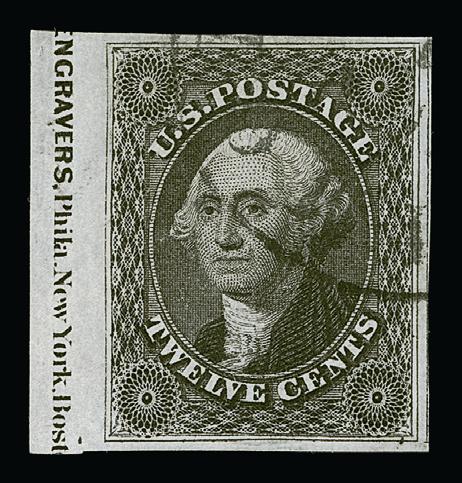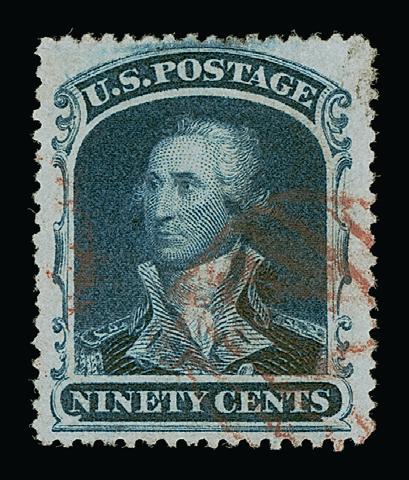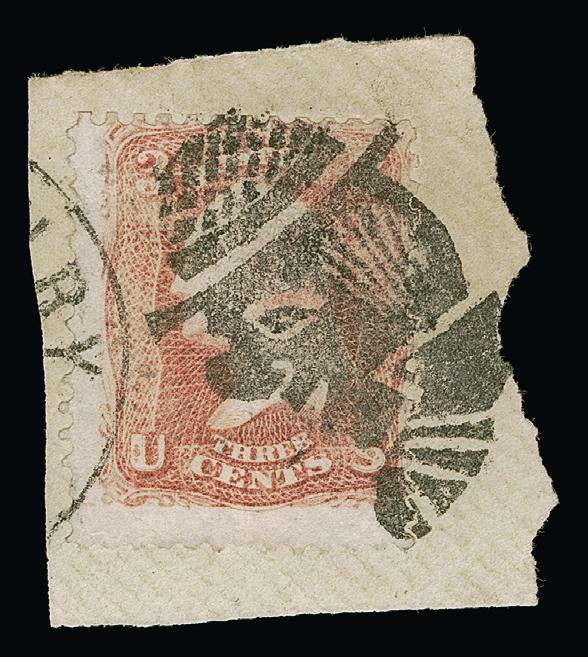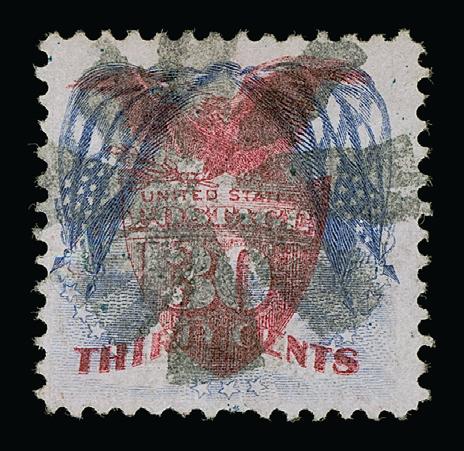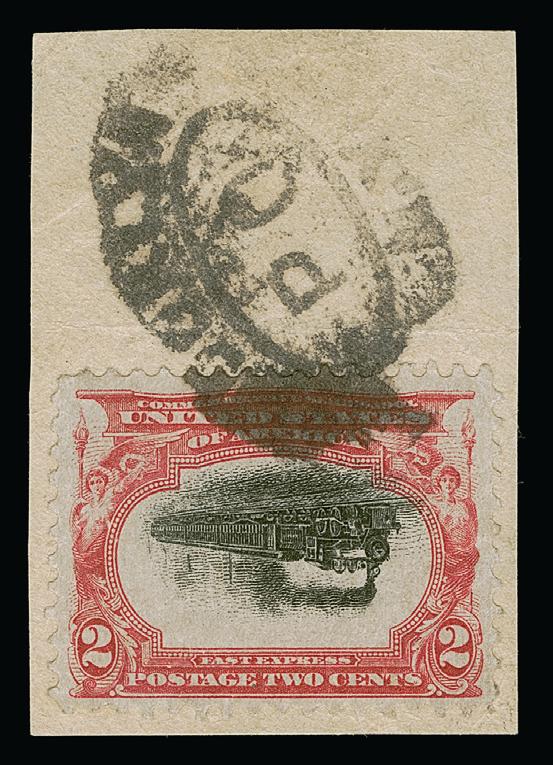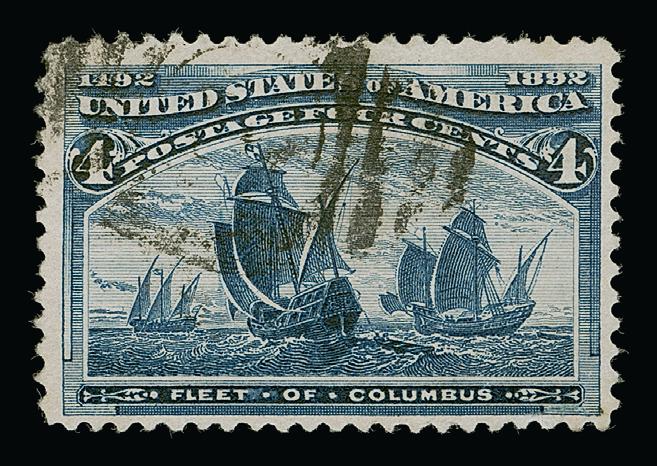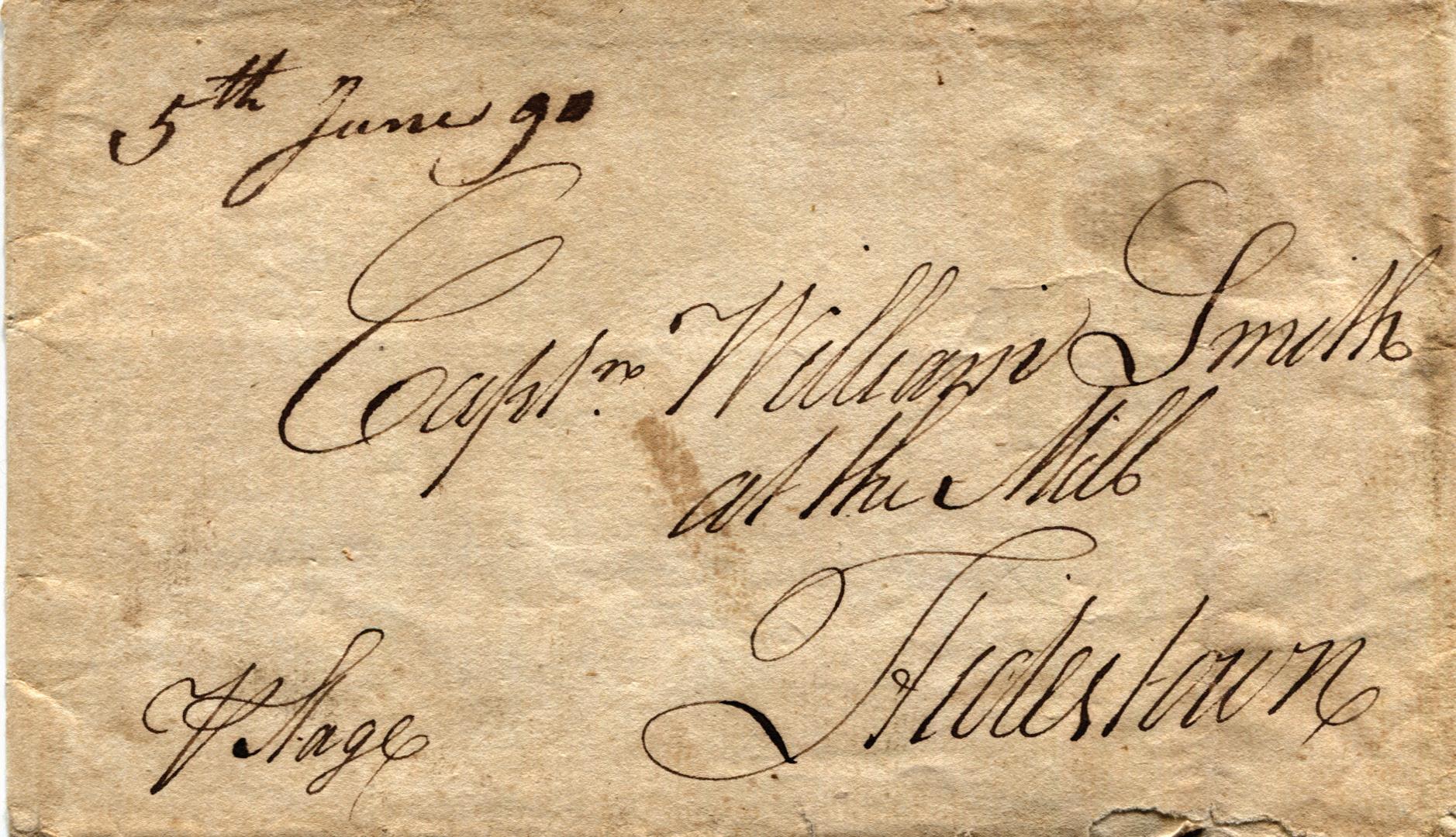

Harmer Stamp Stories
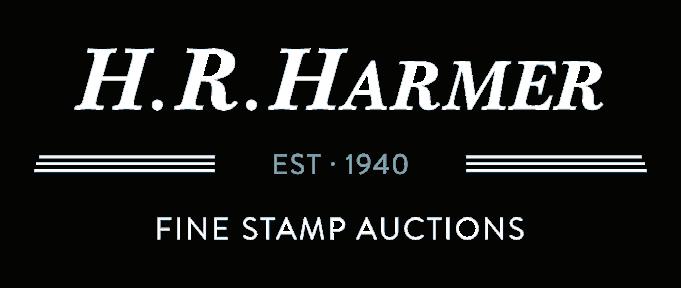
A Closer Look at Past Realizations and Future Offerings
During late March of 1898, the post office in Wadhams Mills, New York (a hamlet in the Adirondacks) ran out of 1c and 2c stamps. While waiting for new stock to arrive, Postmaster G.H. Pierce bisected 4c stamps which were then pressed into service as lower denominations. Each cover was signed by Pierce, with a note that they were “out of 2s and 1s” where the other half of the stamp would have been. As few as 35 such covers were mailed over the course of several days, with the number of surviving examples being much smaller. The example pictured below will be included in our forthcoming June auction.
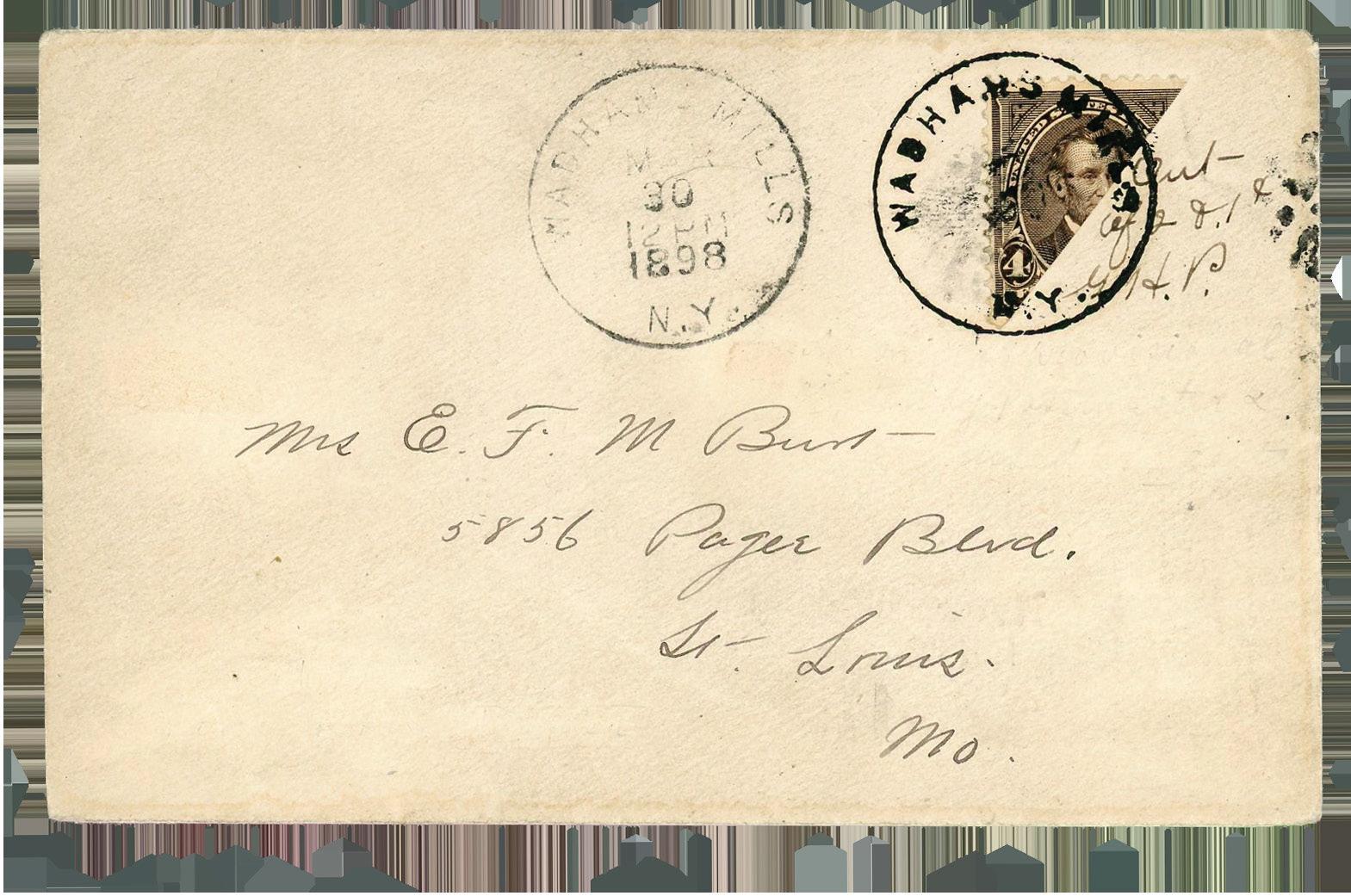
The Collectors Club Philatelist
Editor: Wayne L. Youngblood wystamps@gmail.com
Layout and Design: Jason E. Youngblood jyoungblood@gmail.com
Publications Committee” John Barwis, RDP Robert Gray James Grimwood-Taylor, RDP Matthew Healey Daniel M. Knowles, MD Robert P. Odenweller, RDP (member emeritus) Essential Elements (featuring items of interest) by Daniel M. Knowles 134 by Bob Coradi 136 London 2022 by Wade E. Saadi 140
Advertising Manager: Robert Gray robertgray@me.com
Book Review Editor: Dr. Luca Lavagnino, Europe
Editorial Correspondence: wystamps@gmail.com
Business Correspondence: 22 E 35th St New York NY 10016-3806 Tel. (212) 683-0559 Fax (212) 481-1269 email: info@collectorsclub.org
website: www.collectorsclub.org
Librarian: Andrea Matura readingroom@collectorsclub.org
Authors’ Guidelines for the CCP are available from the editor.
Impressions of London 2022 by Mark Banchik 146
Mail by Stage Coach: The Carriage of Mail by Eastern Stage Lines Before 1860 by Steven Roth 150
Noted in Passing on the Auction Block by Matthew Healey 178
Irene Orysia (Zajac) Bromberg, Ph.D. by Joan Harmer and friends 187 Departments
President’s Message 131 Programs
All Collectors Club meetings (including in-person) currently are held online, via ZOOM, and begin at 5:30 p.m. (Eastern). Although there is no cost, pre-registration is necessary.
The Collectors Club Philatelist (ISSN 0010-0838) is published bimonthly in January, March, May, July, September and November by The Collectors Club, 22 East 35th St, New York NY 10016–3806. A subscription to The Collectors Club Philatelist is included with dues paid by members of The Collectors Club. Subscription price for nonmembers in the United States is $70. Prices for foreign addresses and/or other classes of mail are higher depending on actual cost; consult publisher. Subscriptions for outside the United States should be paid in U.S. funds drawn on a U.S. bank. Back issues $9, including postage. For a complete list, write the publisher. Claims for undelivered issues will be honored only within six months of the date of publication. Beyond that, replacements will be provided at the single copy price. Periodicals class postage paid at New York, New York 10001 and additional offices. Office of Publication: The Collectors Club, 22 East 35th St, New York NY 10016–3806. Copyright@ 2022 by The Collectors Club. All rights reserved. We do not give implied or other consent for copying for more than personal use. Indexed in PhiLindx by E.E. Fricks and included in the article index of the American Philatelic Research Library and the Global Philatelic Library. The opinions and statements contained in the articles are those of the authors and not necessarily those of The Collectors Club, its officers or staff.
POSTMASTER: Send change of address to: The Collectors Club Philatelist, 22 East 35th St, New York NY 10016–3806.
129 Volume 101, Number 3 Collectors Club Philatelist
THE COLLECTORS CLUB
22 East 35th Street, New York, NY 10016 (212) 683-0559
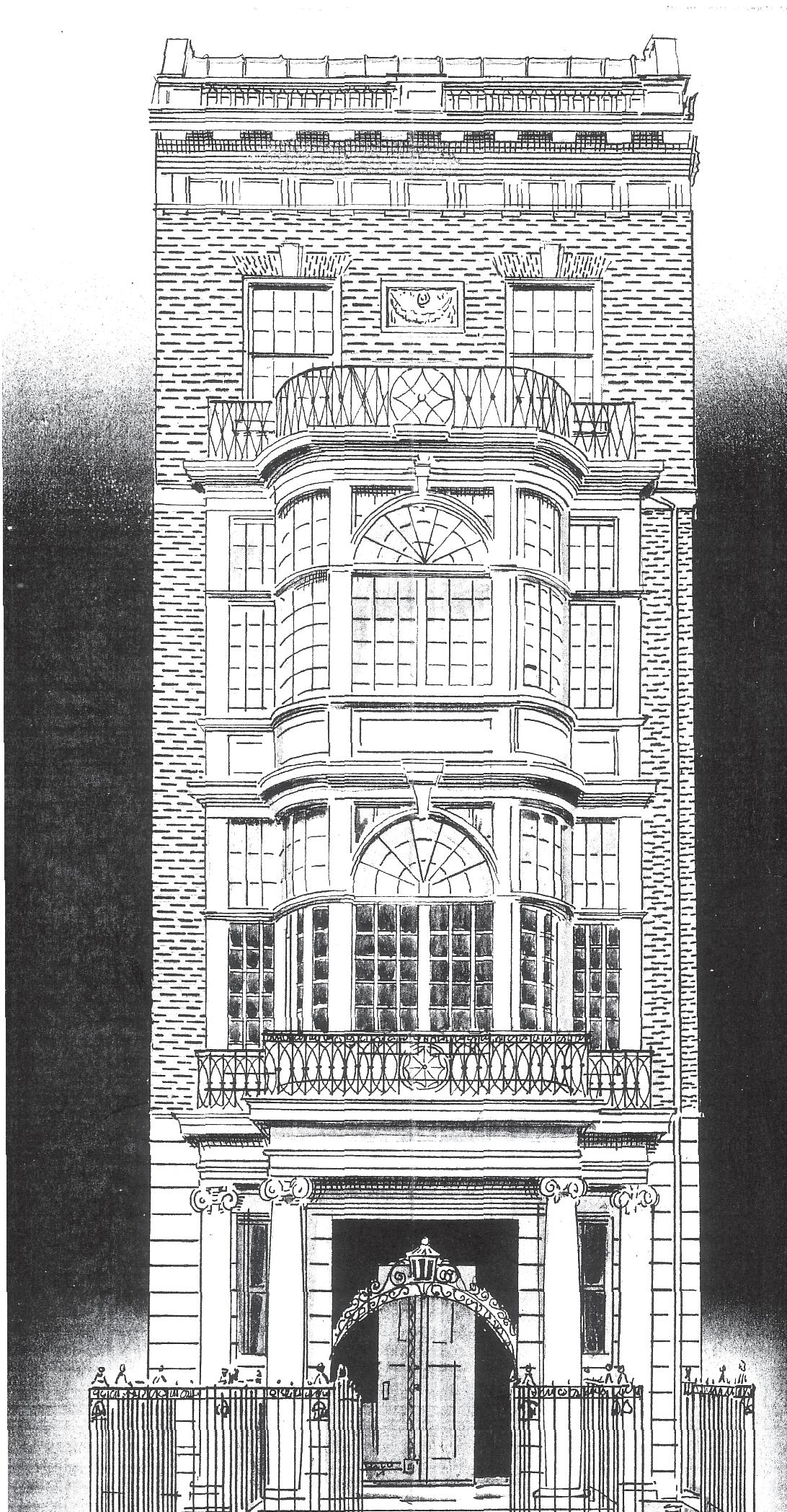
The Collectors Club is open Monday through Friday, 10 a.m. to 5 p.m. Please call ahead if intending to visit. On meeting nights the Library is open until 6:30 p.m., the beginning of the lecture program.
President
Lawrence Haber Vice President
Robert Gray Secretary Matthew Healey Treasurer Roger S. Brody, RDP Chief Technology Officer Joan Harmer
Class of 2022
Robert Gray Lawrence Haber Matthew Healey Daniel J. Ryterband Wade E. Saadi, RDP
Officers Governors
Class of 2023
Roger S. Brody, RDP Vincent Cosenza Joan Harmer Kathryn Johnson
Class of 2024 Ozan Gurel Mark E. Banchik Lawrence J. Hunt Stephen Reinhard Robert G. Rose
The Collectors Club Philatelist is an international specialty journal serving the needs of hundreds of collectors worldwide. It serves as the journal of record for the Collectors Club as well as publishing stimulating and helpful articles for collectors of many levels and specialties. The Collectors Club Philatelist strives to publish accurate philatelic information and serves as a forum for communication among members of The Collectors Club.
President’s Message
By Lawrence HaberIn the last issue of this journal, due to timing constraints, we inserted only a brief mention on the passing of our executive secretary, Irene Bromberg. There wasn’t much time to think and ponder. Now it is different. It is so hard to write about this – about our loss and the emptiness we feel without descending into cliches and prepackaged sentiments. The usual cliches don’t do Irene proper justice.
Irene served this Club for 20 years. She was a right arm to the last two decades of my predecessors and we are all diminished by her loss. I go into the Club now and I think I can see her out of the corner of my eye, or I think I can hear her laugh, but I am mistaken. The Clubhouse feels empty and is very quiet. It does serve to bring home the tragedy of this horrible pandemic. None of us can now say we were not touched. One of ours was taken from us. Too early and all too cruelly.
Let us now take a short pause before moving on to some business.
Real estate matters are proceeding. We signed a contract to sell the 22 East 35th Street Clubhouse. We are exchanging contracts on the sale of the air rights associated with the building. We have toured two possible new locations with our architects and they are working on conceptual drawings of floor plans.
But there is more than real estate that is on this issue’s agenda for my update. The topic now turns to this journal, the Collectors Club Philatelist. This journal is so important to us and to the hobby. In an effort to make the journal more reflective of this Club, we are introducing some structural changes that you may notice as the months pass.
To better assist our editor in obtaining quality articles, we have appointed a publication committee composed of James Grimwood-Taylor, RDP; John Barwis, RDP; Daniel Knowles; Robert Gray and Matthew Healey. Their role is to serve as a resource for the editor and potential writers. You may have noticed their appearance in the masthead of the last issue of this journal.
When I encounter potential authors for this journal, I am occasionally asked what type of article we look to publish. Frequently, the question is a variation on “why should I publish this in the CCP when it might better go to the XYZ Specialist Society Journal?” Briefly summarized: Articles appearing here need not be tightly focused on “pure” postal history or the technical aspects of stamps, but may be broadly based by injecting social, historical or environmental material that would make a philatelic article more interesting. We are a generalist society and our membership spans the complete range of philatelic interests. You may wish to reach a broader audience, especially philatelic judges, if you exhibit. It is important that our articles engage more than just specialists.
We have also selected some section heads who will focus on sourcing articles that address specific areas of interest, including Dan Knowles for exhibiting. We would be seeking articles by exhibitors on the story behind their exhibit, such as how it emerged, how it subsequently evolved and the challenges faced during its creation. We hope to include – on a regular basis – articles by exhibitors on their
personal stories and the issues they grappled with in mounting their material in the frames.
Matthew Healey will be providing insights on the auction scene and hopefully providing us all with a perspective that will not only be new but may improve of understanding of what is going on. And, Bob Gray will be heading a reinvigorated book review section. This only makes sense, since he is the head of our library committee. There are additional section heads, and these will be shared with you as they step forward.
By the time you read this, our first program from the Clubhouse will be behind us and our Lichtenstein Awards Celebration would have taken place. We can now look forward to a dinner at the Great American Stamp Show in Sacramento, Calif. It will be held on Wednesday, Aug. 24 at 7 p.m., immediately following the Tiffany reception. We are especially delighted to be holding this dinner in coordination with Boston 2026 and the Royal. You will doubtless be seeing publicity of this event and we urge you to attend. It will be a superlative event, and a perfect place and time to catch up with old and and new friends. Many people still remark about the dinner we held in Rosemont, Ill., in August 2021, as part of Great American Stamp Show 2022. The gathering in Sacramento is certain to be a very special evening. We hope to see you there.
Collectors Club Programs 2022
June 1* 1932 Washington Bicentennial Issue, Daniel Ryterband, Chappaqua, N.Y. June 8** United States Mails: The First 80 Years Without Stamps Robert Rose, Mendham, N.J.
June 15* Boston 2026 Presentation, Yamil Kouri
Sept. 7* The North Borneo Chartered Company Through Their Stamps and Postal History, Peter Cockburn, West Sussex, U.K.
Sept. 15* Spellman Museum Postal History Symposium 8-10 p.m. EDT (a virtual event), register at info@spellman.org, or go to www.spellmanmuseum.org
Ron Cipolla – The Earliest Known Letter From the Future United States Norma Nielson – Lloyds of London
Ron Cipolla – Harnden’s Express Ken Stach- Western Expresses
Sept. 21* Our Hobby’s Future - Dealer Panel
Chris Green, Andrew Titley. Charles Epting, Matt Kewriga
Oct. 12** Indian Military Mail During the WWI Era, Robert Gray, Livingston, N.J.
Oct. 19* Victoria Postal History, John Barwis, Holland, Mich.
Nov. 2* Evolution of a Thematic Exhibit - Blood: a Modern Medicine, Jean Wang
Nov. 9** Single Frame Exhibition, (Register Online)
Nov. 16* Virginia Dare, Mark Schwartz, Philadelphia, Pa.
More Details as they become available, www.collectorsclub.org
* Denotes meeting or presentation via Zoom only
** Denotes meeting or presentation at clubhouse and via Zoom.
132 www.collectorsclub.org May-June 2022
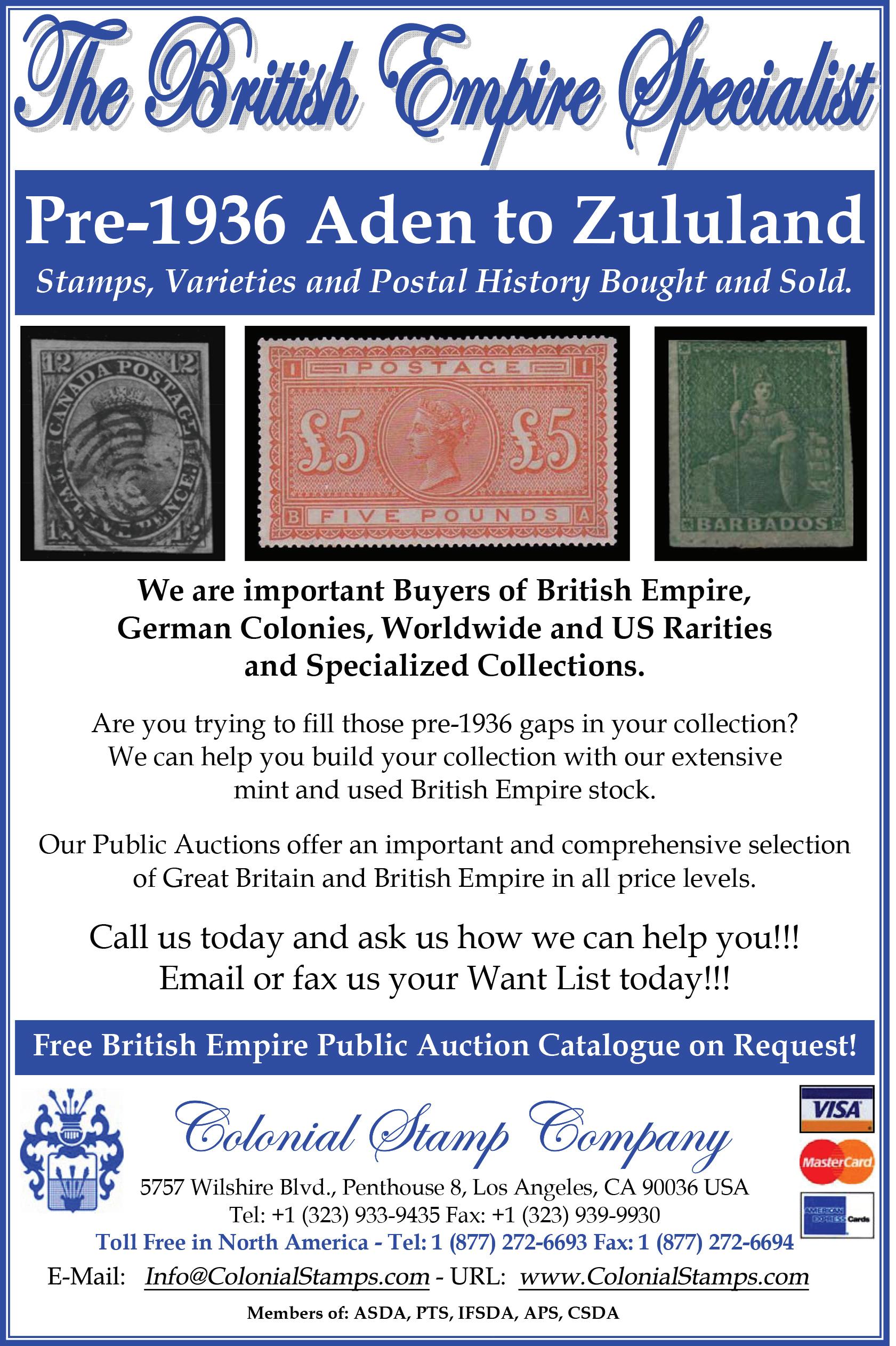
Essential Elements
This month we continue featuring member-submitted short features that spotlight favorite items from member collections. The criteria by which you choose these items is immaterial. It could be rare, an original discovery, a keystone to an exhibit, an early item from your collection or some philatelic object that simply amuses you.
The goal of this feature is to simply highlight short, interesting editorial nuggets that allow our members to share “special” items and get to know each other and their interests a little bit better. We continue this month with contributions by Daniel Knowles and Bob Coradi.
Response so far has been great. We’ve received several submissions, and response to those published in the last three issues has been overwhelmingly positive! Please consider submitting an occasional item for this ongoing feature.
Uncle Tom’s Cabin by Harriet Beecher Stowe
Daniel M. Knowles, M.D.Illustrated envelopes were increasingly being used as advertising vehicles during the early to mid-1850s. They were employed to advertise everything from agricultural implements to politicians seeking the United States presidency. These illustrated envelopes provide us with snapshots of the culture of the period. However, perhaps none of these illustrated envelopes had a greater cultural and political impact on American history than the envelope advertising Harriet Beecher Stowe’s novel Uncle Tom’s Cabin or Life Among the Lowly.
www.collectorsclub.org
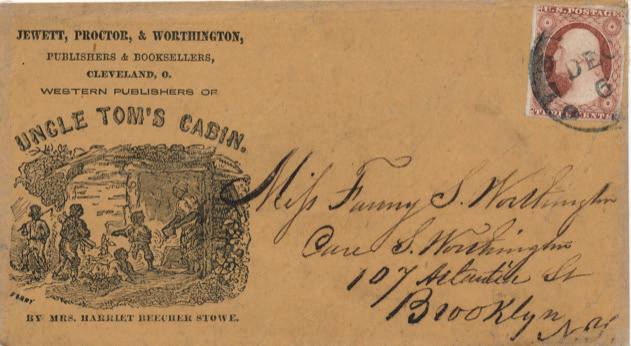
Shown nearby is the better of the only two known examples of the illustrated envelope advertising Stowe’s seminal novel. It is postmarked Dec. 6 (1852), Cleveland, Ohio. The other cover bears an identical design and is also postmarked in Cleveland (www.rumseyauctions.com Sale 88, Lot 662). The design is taken directly from the novel’s front cover illustration, which shows a Black family against the backdrop of a log cabin. This illustrated cover possesses great historical significance and as such holds a cherished place in my American Civil War-related collection.
Harriet Beecher Stowe, coming from a deeply religious Connecticut family, became a teacher and an active abolitionist. It is believed that she wrote Uncle Tom’s Cabin in response to the passage of the Fugitive Slave Act of 1850. That act prohibited assistance to fugitive slaves and strengthened sanctions – even in the free states. Stowe had become very familiar with slavery. Her grandmother kept African American servants who likely had been previously enslaved. Her father had preached in favor of the colonization movement –the creation of Liberia as a settling destination for freed Blac ks. As a young wife and mother living in Cincinnati, Ohio, Harriet Beecher Sto we met and heard stories about slavery from former and fugitive enslaved African Americans. She witnessed slavery firsthand while visiting the adjacent slave state of Kentucky. In addition, she employed and housed fugitive slaves in her own home, helping more than one of her own servants, who were runaway slaves, escape to Canada.
The first installment of Uncle Tom’s Cabin, initially titled Life Among the Lowly, appeared in serial form in the anti-slavery newspaper The National Era. Installments were published weekly from June 5, 1851, to April 1, 1852. The serial was published as a two-volume book by Jewett, Proctor & Worthington (noted above the illustration on the cover) on March 20, 1852. It sold an astounding 300,000 copies in the United States in its first year. In Great Britain, 1 million copies of the book were sold. It became the most popular novel of the day and was translated into more than 60 languages.


Uncle Tom’s Cabin achieved widespread popularity among White readers in the American North. It changed Americans’ views toward African Americans and slavery, galvanized the abolitionist movement in the North and provoked widespread anger in the slave-owning South, contributing significantly to the outbreak of the Civil War. Upon meeting her, it was said that Abraham Lincoln greeted her by saying, “So this is the little lady who started this great war.”
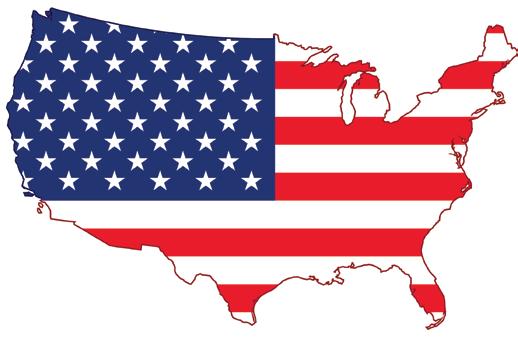
$5 Hamilton – Solo Use
by Bob CoradiOne of my favorite philatelic items is a solo use of the $5 Alexander Hamilton stamp (Scott 1053) on a business reply mail (BRM) cover. There are only four known solo uses of this $5 stamp: two on covers franked with the stamp, one on a parcel post mailing card (in my collection), and the example shown nearby. An apt description of this BRM service is quoted as follows.1
“Businesses will often send out large mailings to customers, hoping to get a response from a percentage of them. These same businesses find that they get better response if they enclose a postage paid card or envelope in their mailing, addressed back to the business. On the other hand they may send out 10,000 mailings yet receive less than 10% of the postage paid cards or envelopes in return. The BRM service allows mailers to do this, yet they pay only for the items returned to them. To do this the permit holder guarantees payment of the appropriate first-class postage plus a handling charge per piece on all returned BRM cards and envelopes distributed under the permit holder’s permit number.
These cards and envelopes would be returned in large numbers to the returning post office. This PO would take a stack of such cards or envelopes, determine the total cost of the stack (first-class postage plus BRM fee) and place postage due stamps on the top item of the stack to indicate the amount due by the mailer.”
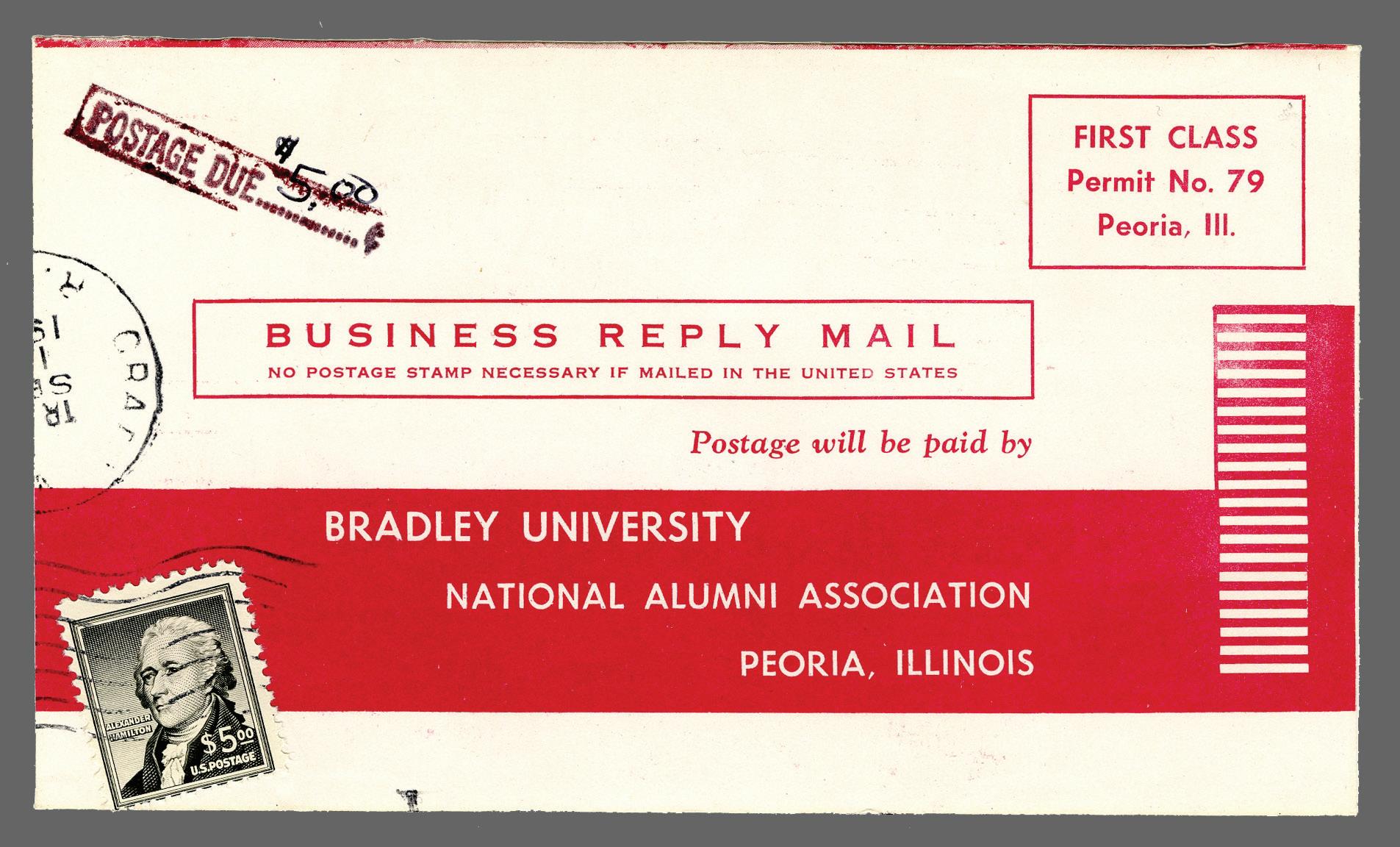
The first-class rate in the Liberty series period until Aug. 1, 1958, was 3¢. The BRM fee was 2¢ each; hence 5¢ was due per piece. Logic would dictate that there were 100 pieces picked up that day.
1. U.S. Domestic Postal Rates, 1872-2011 Third Edition, Henry W. Beecher and Anthony S. Wawrukiewicz, 2011, American Philatelic Society, page 133.
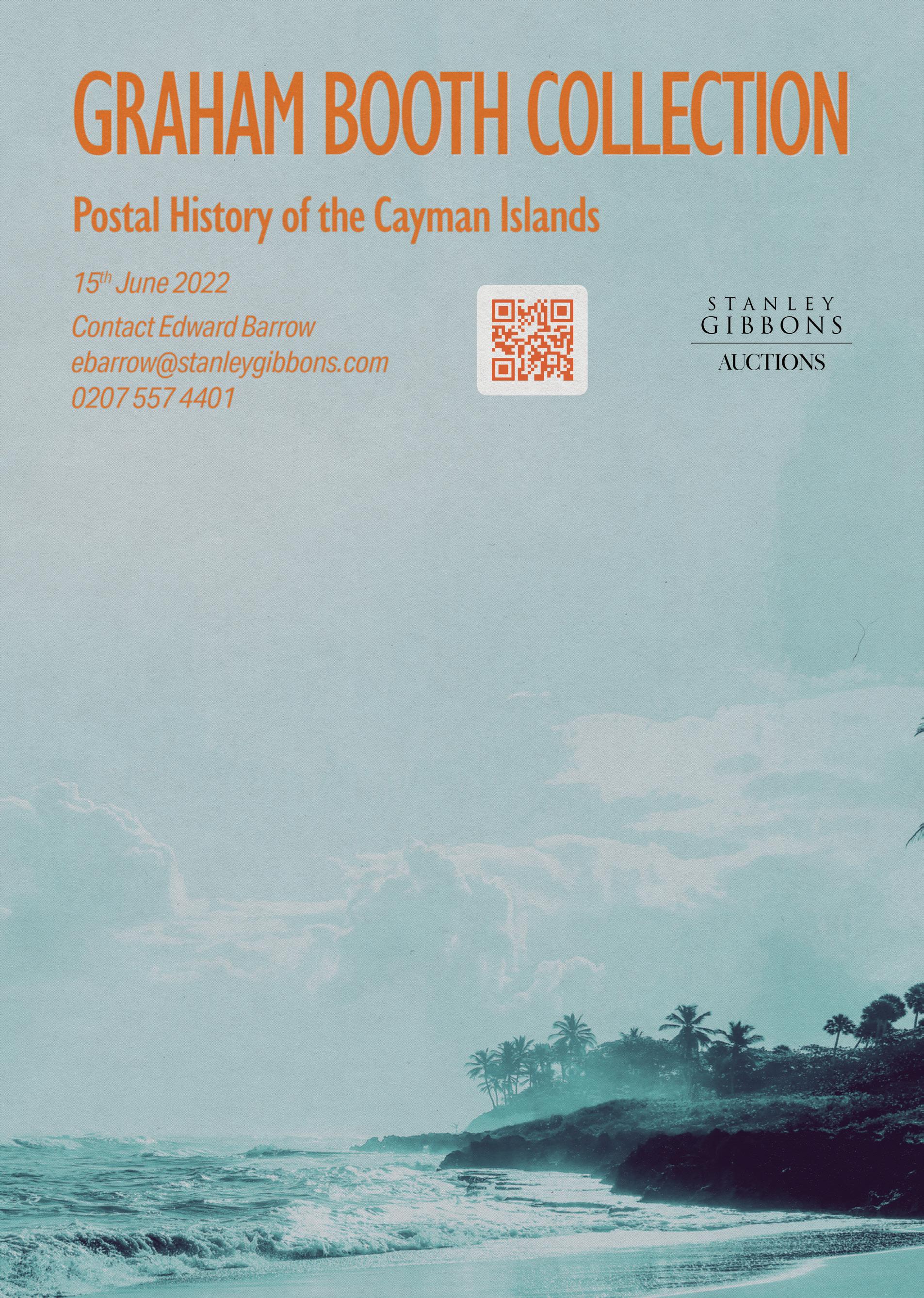
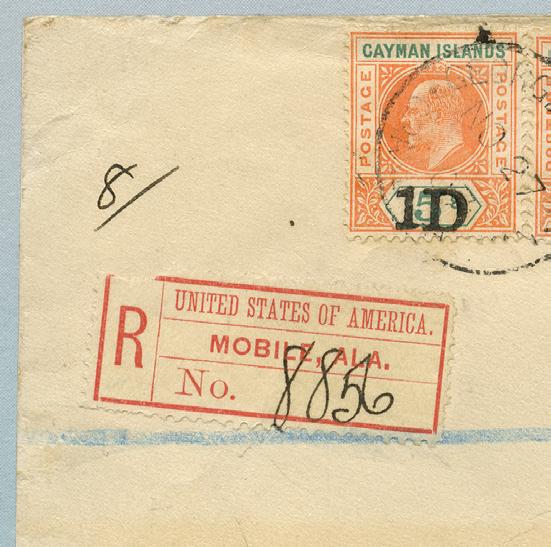
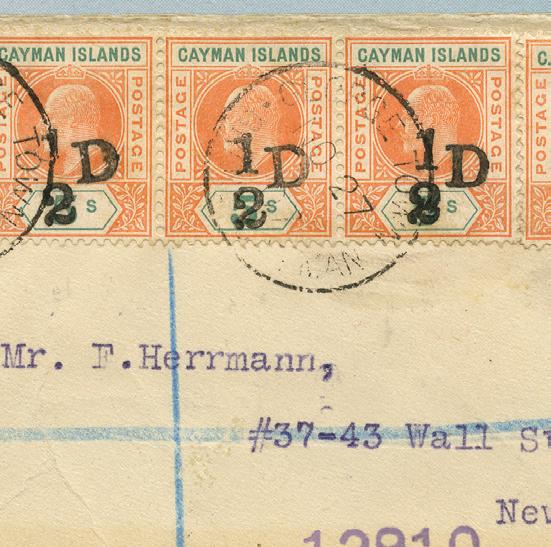
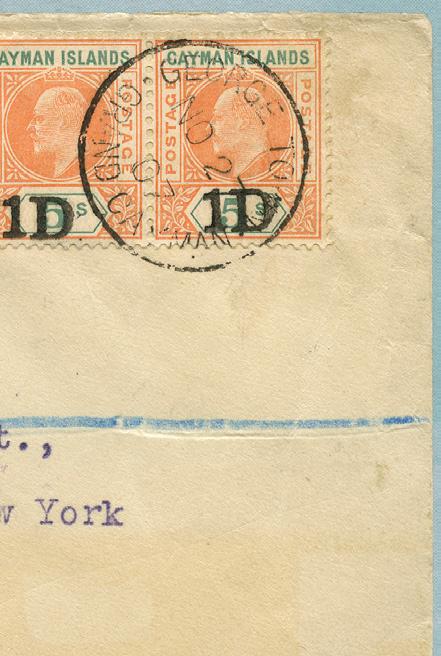

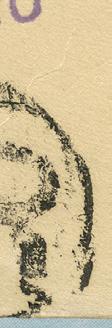

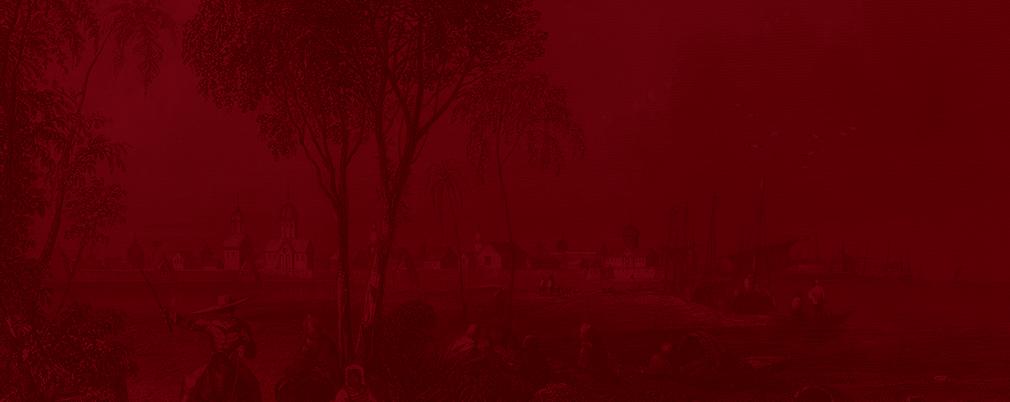



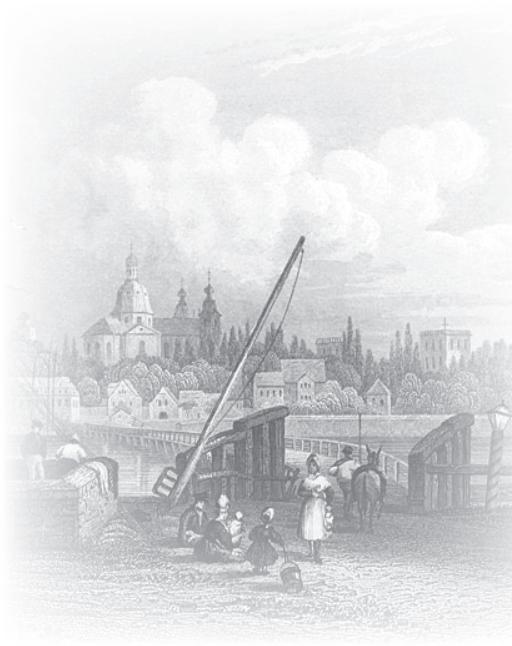
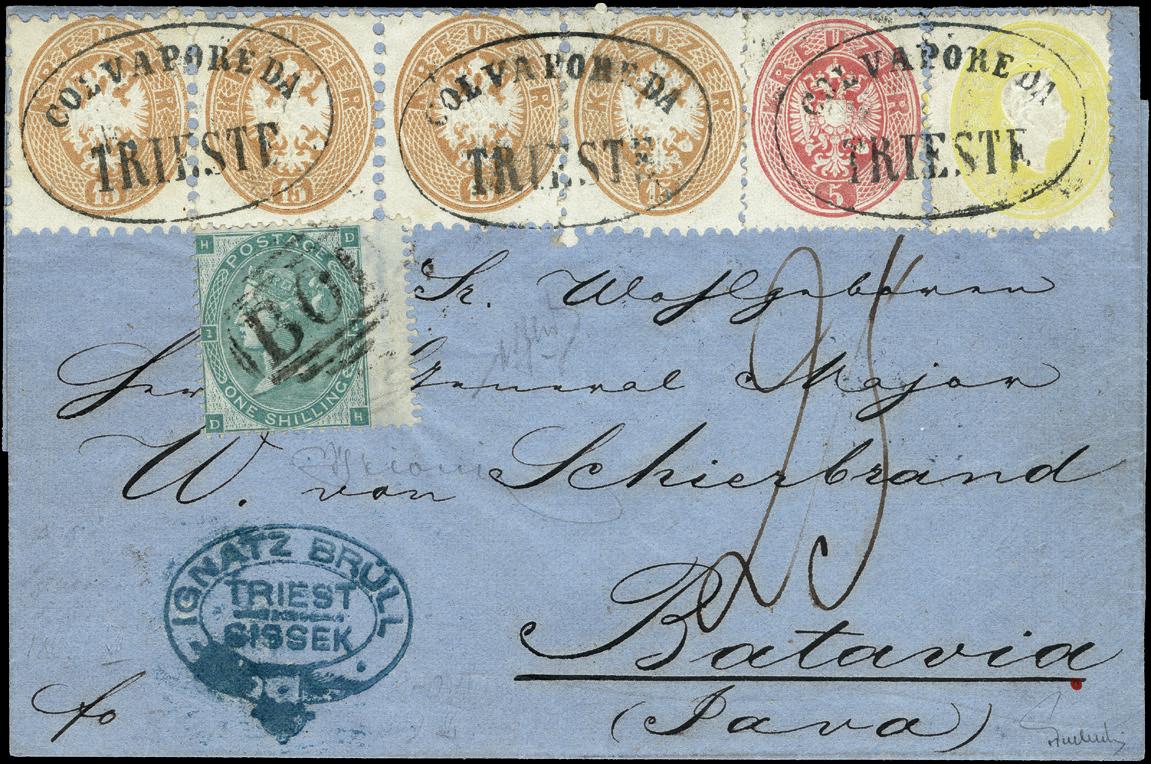


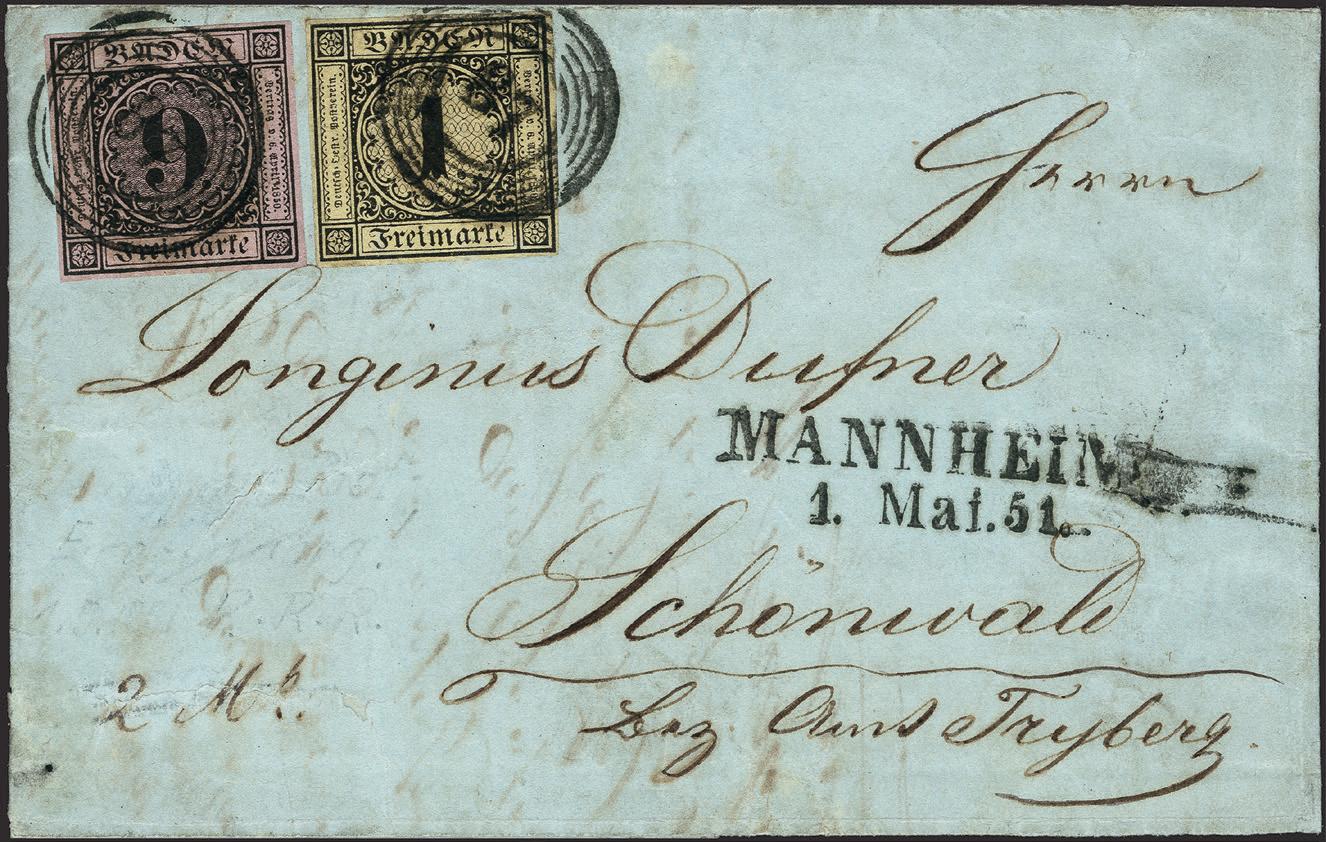 Germany’s Oldest Stamp Auction House
Germany’s Oldest Stamp Auction House
(1985)

Provenance: 17th Müller Auction (1958) Dr. Jerger (2004)



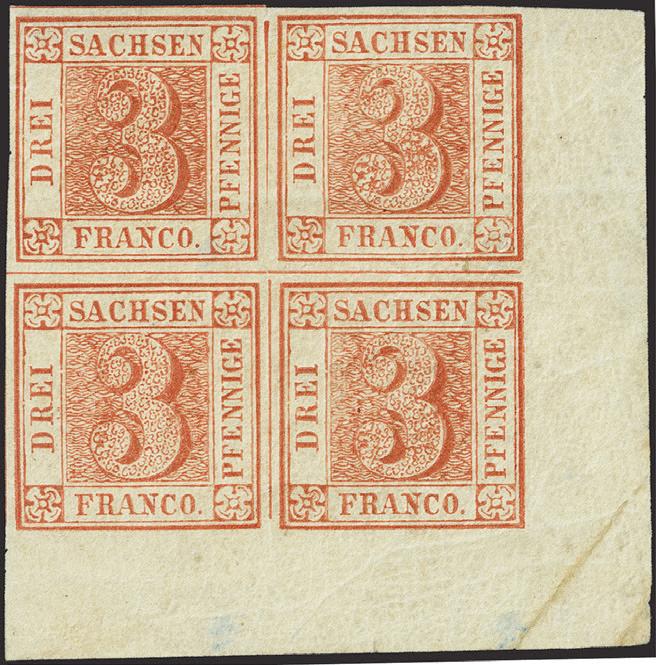


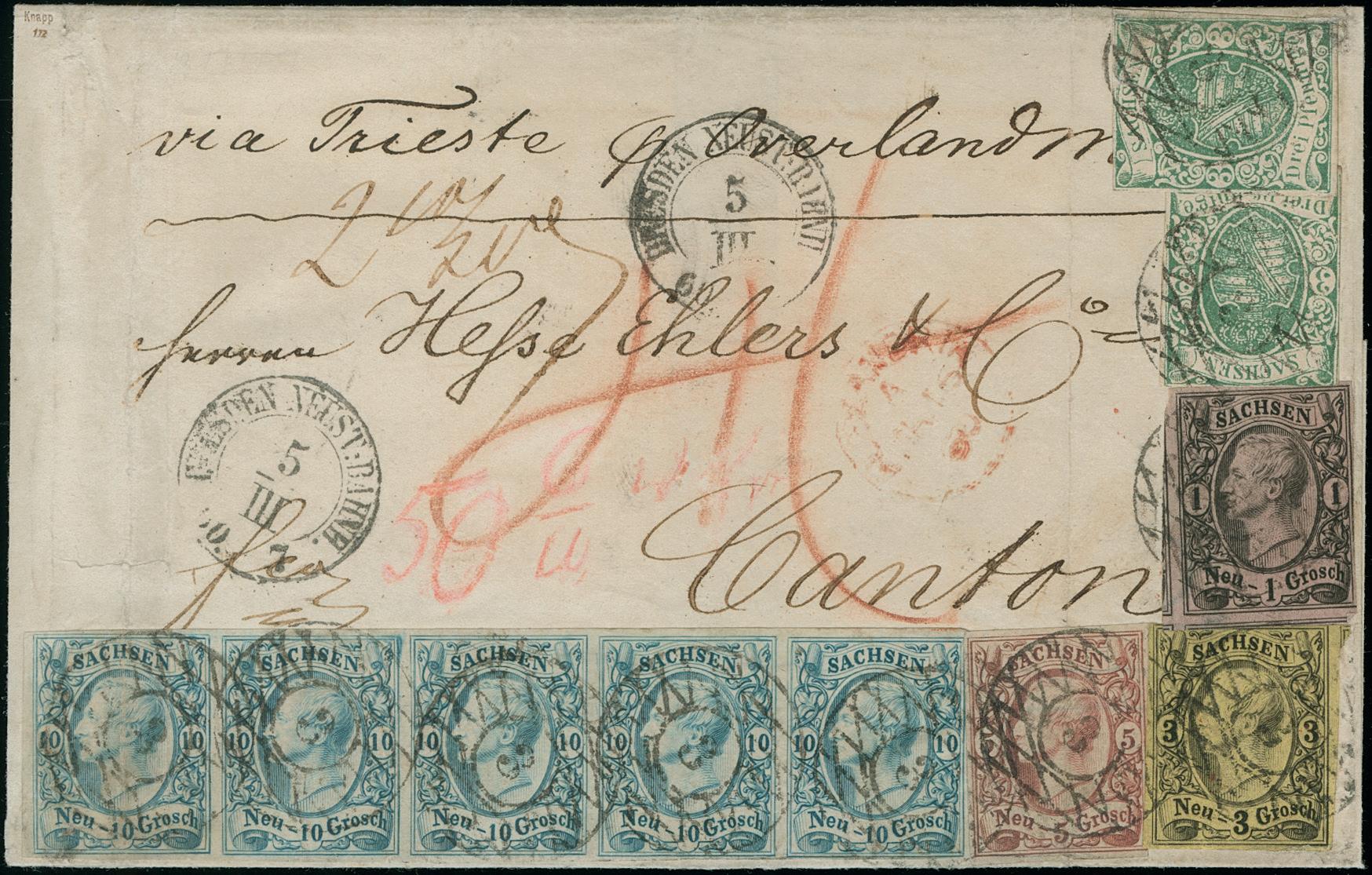







London 2022
Wade SaadiI just returned from the London 2022 International Stamp Exhibition with my wife; we had a splendid time in the United Kingdom, as we always do. It was our first international exhibition since the onset of the god-forsaken virus, and it out performed our expectations by a wide margin. Yes, traffic at the show was lighter than usual, as it has been at the several exhibitions that I have attended intra-pandemic here in the United States, but it was more than compensated by the fact we were in one of the world’s greatest cities, and kind people surrounded us everywhere. Whether wait staff, taxi driver or hotelier, there were smiles and conversation that make us feel welcome.

The exhibits were of an amazing caliber; the list of top awards follows. I have not seen such a display of blockbusters since Stockholmia 2019.
Grand Prix National Howard Hughes United Kingdom The Maltese Cross Grand Prix International Vittorio Morani Italy UPU and its Impact on Global Postal Services
World Stamp Championships James Peter Gough United States UPU and its Impact on Global Postal Services
Best in Class - Postal History Vittorio Morani Italy
Tuscany 1836 to UPU: Letter mail in, from and to Tuscany: routes, rates and charges
Best in Class - Traditional Joseph Hackmey United Kingdom The half lengths of Victoria
Best in Class - Postal Stationery Behruz Nassre-Esfahani United States Persia, Qajar Postal Stationery 1876-1925
Best in Class - Revenue Michael Mahler United States U.S. Civil War Fiscal History Panorama
Best in Class - Aerophilately Bjorn A. Schoyen Norway
First United Kingdom aerial post 1911 - First Sustained Air Mail Service in the world
Best in Class - Thematic David Griffiths United Kingdom Here be Dragons
Best in Class - Youth Dinda Alisha Rahima Indonesia The Feather Friends
Best in Class- Literature Printed James Peter Gough United States
The Postal History Of The UPU: The Postal Card
Best in Class - Literature Digital Maurice Buxton United Kingdom GBPS Website
Best in Class - Postcards Jennifer Long New Zealand A study of New Zealand Picture Postcards
Best in Class - Open Iva Mouritsen Denmark
Best in Class - Modern Guy Heyblom Belgium
A Royal Ménage À Trois And Its Historical Consequences
STUDY Belgium’s Royal Portrait King Baudouin, Type “VELGHE”
www.collectorsclub.org
The show was held at the usual locale for the London internationals and Stampex, the Business Design Centre in Islington, and the exhibition opened on Saturday February 19. The first day had an attendance fee of £10, the other days were free. There were dozens of meetings held during the eight days for clubs and societies.
During these days we were either at the exhibition, or at a museum or gallery. We visited the British Library and the Victoria and Albert museums again; they are outstanding. The evenings were filled with events, some private, and others through the organized philately. Alex Haimann arraigned several activities for some evenings, including dinners at the chef’s table at Fortnum & Mason, the Traveller’s Club on the Pall Mall and a dinner at the Museum of Brands, hosted by Cherrystone Auctions vice president and co-owner Josh Buchsbayew, with some 100+ in attendance.
There were two of the many events that took place at 15 Abchurch Lane, the home of Royal Philatelic Society London (RPSL), which I will mention next.
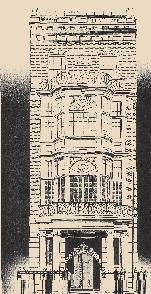
The first took place on Monday afternoon, and was the signing for The Roll of Distinguished Philatelists (RDP). As the pandemic had prevented some recipients from signing the Roll in the year of their election, there were eight who signed that day, placing their signatures on a scroll first signed by King George V in 1921. The new signatories all showed material from their collections in the frames. The presentations were “Zoomed,” and open to anyone with internet.
Keep up to date with what’s happening in your club: www.collectorsclub.org

The second took place on Thursday, sort of a “Members Day.” Forty frames of material were shown by overseas members. Three overseas attendees included Cheryl Ganz RDP, FRPSL, receiving the Lee Medal for the best digital presentation, namely “Zeppelin LZ-129 Hindenburg On Board Post Office”; Keith R. Klugman FRPSL received the Tapling Medal for his article in The London Philatelist on “Natal: Use of 1857 Embossed Stamps”; and James P. Gough RDP, FRPSL was awarded the Crawford Medal for his work, “The Postal History of the Universal Postal Union: The Postal Card (Worldwide) 1869-1974.” One of the highlights of Thursday was the initial dedication of RPSL Members’ Lounge sponsored by the United States Members & Fellows. The final name of the lounge will be announced at a later date.
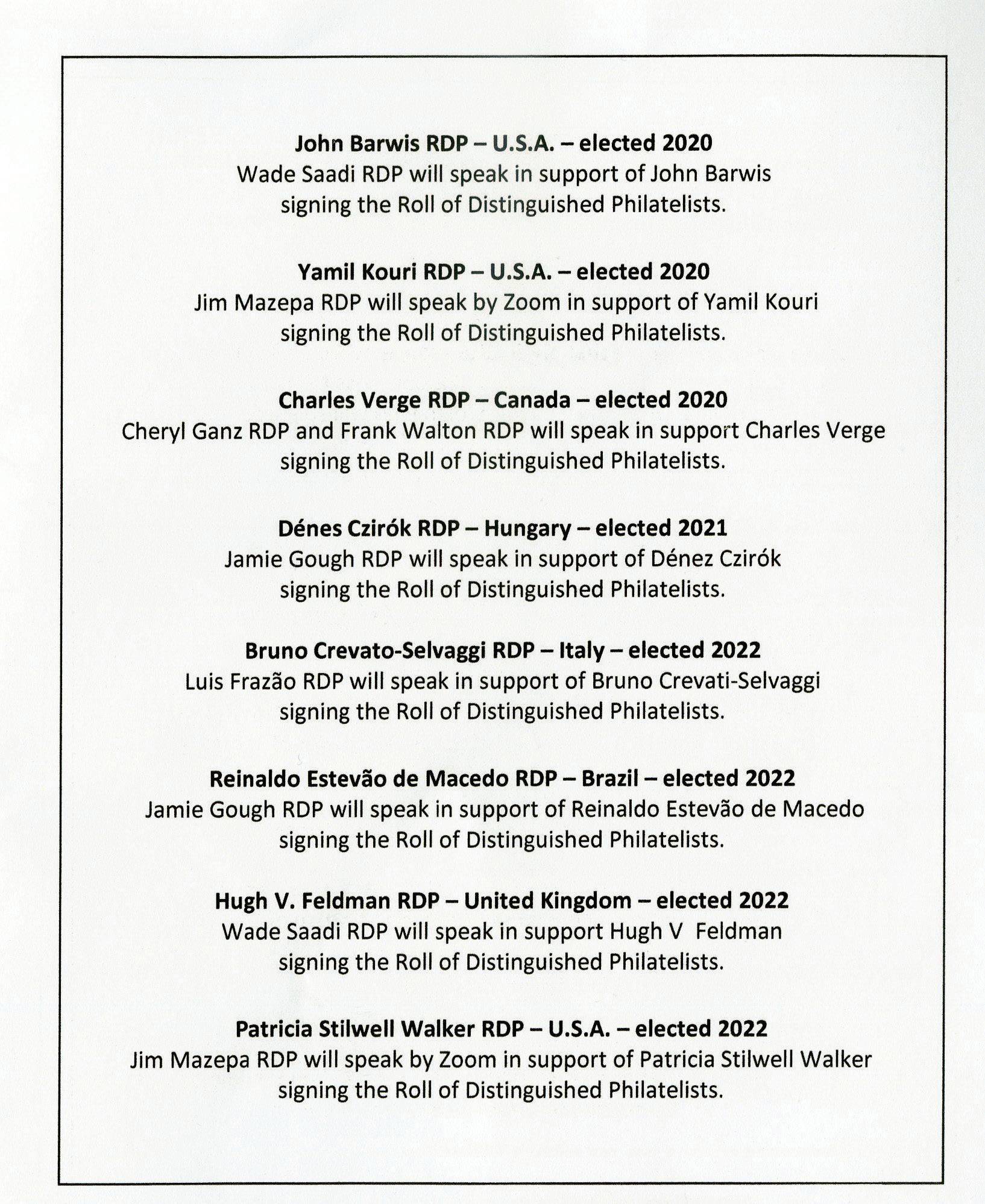
Capping off the exhibition on Friday night was the President’s Dinner, which was a banquet at the Great Hall in Guildhall. The Royal Philatelic Society London president addressed the evening’s guests and then introduced Constanze Dennis, Vince King and Jonas Hallstrom to speak a few words. The building dates back to 1411 and is imbued with pomp and circumstance; it is a regal example of a time before.
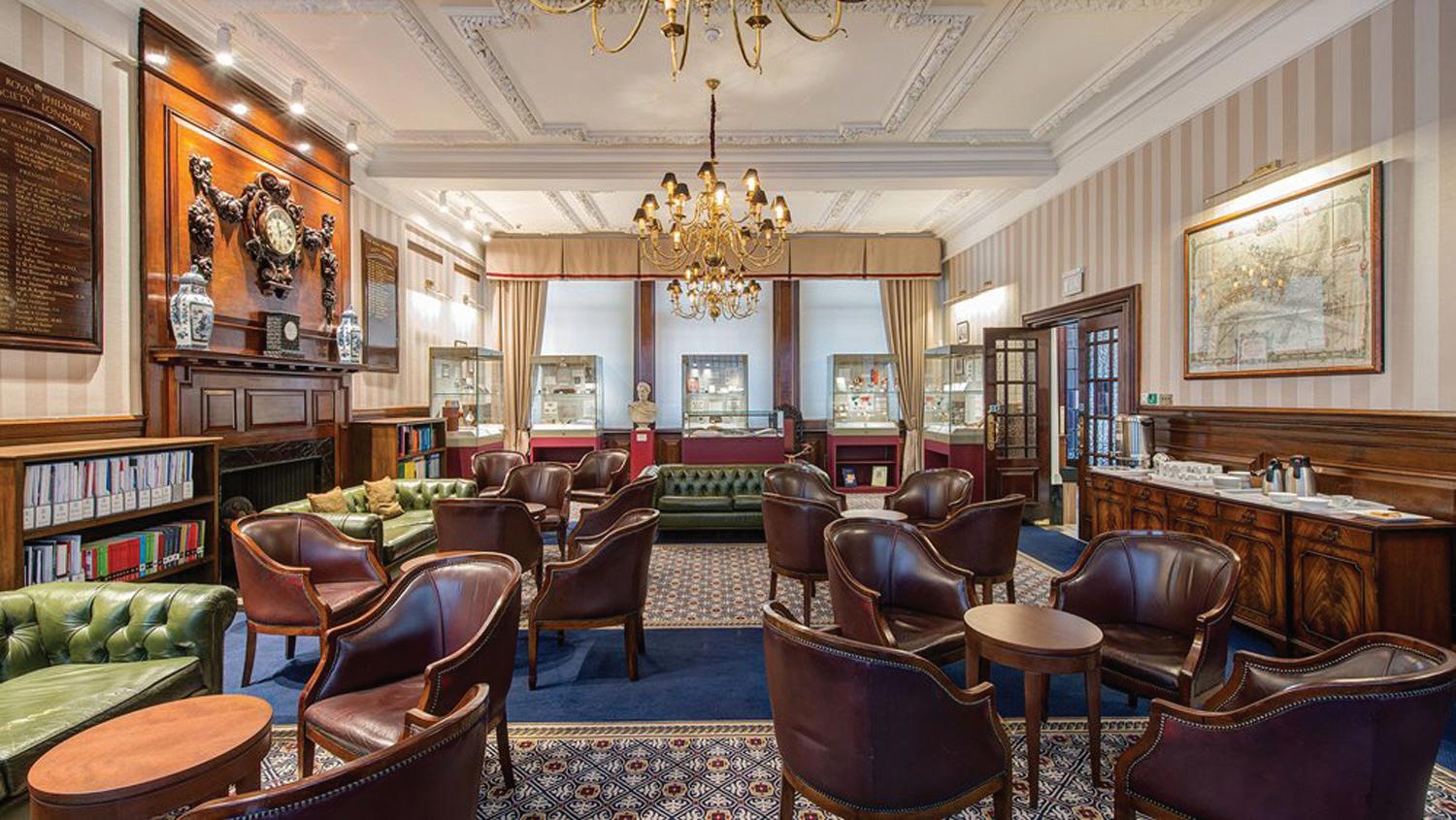
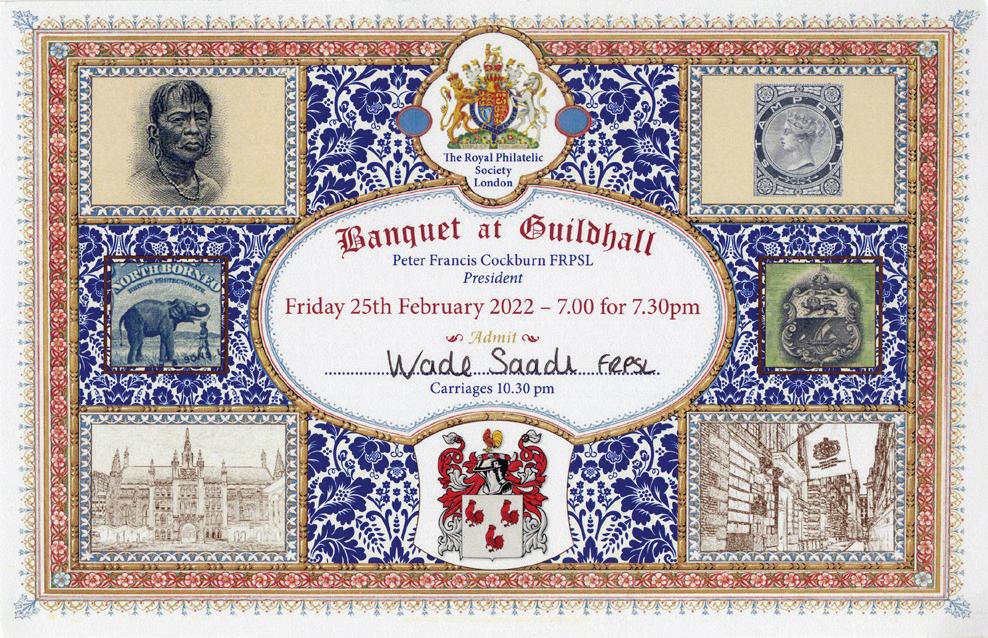
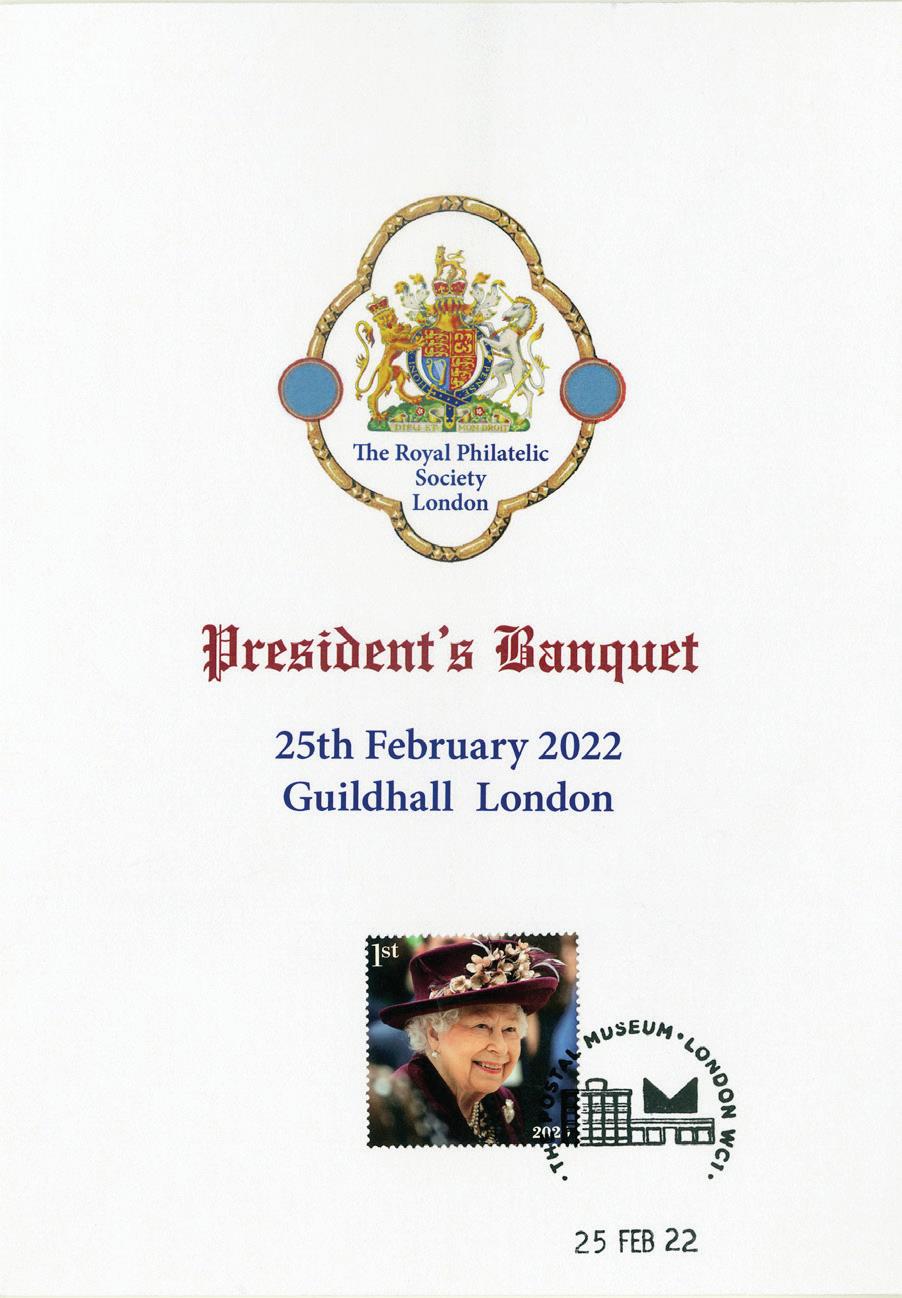

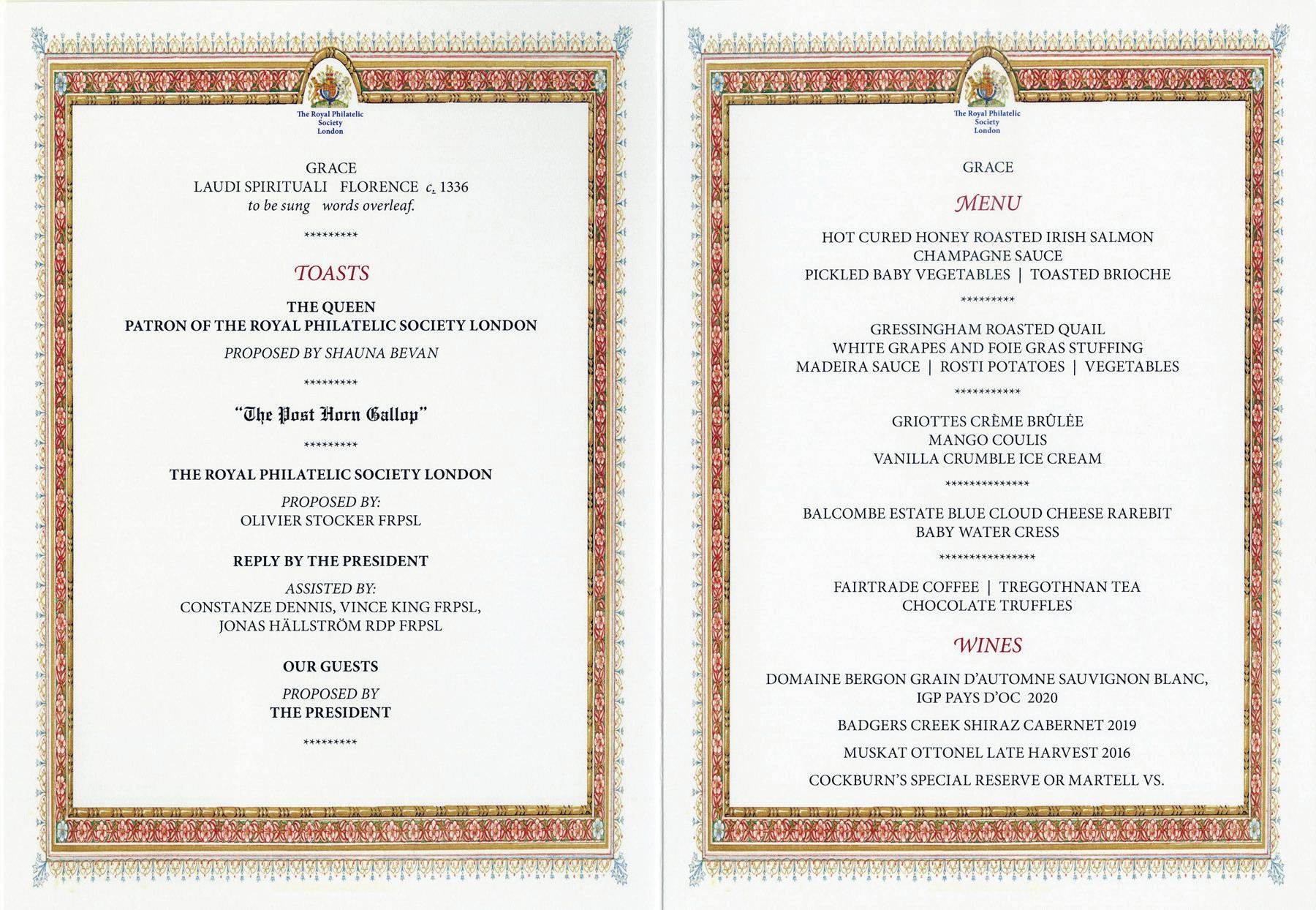
Spring General Auction Series
Geneva - June 13th-17th, 2022
GB. 1840 1d black mint block of four.
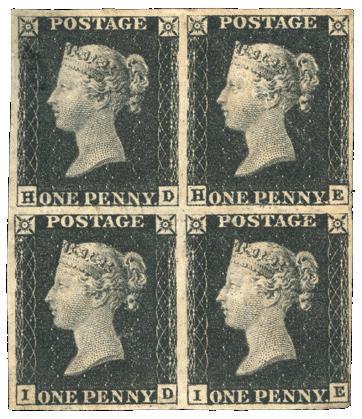
Greece. 1896 Original 20l artist’s handpainted essay; ex Dr. Caruso
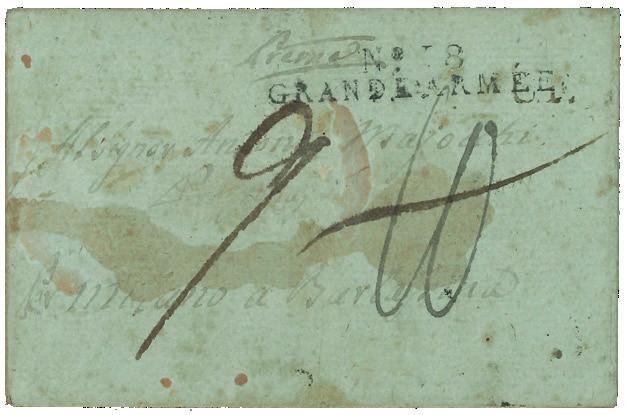
1812. One of just two letters recorded from Moscow sent by an Italian soldier in the “Grand Armée”.
Puerto Príncipe. One of two covers recorded with 10c on 1c; ex Dr. Kouri
1900. Boxer War, unique usage of an Italian value accepted by the German P.O. in China to forward Italian military mail.
� Egypt. VI The Third Issue and Officials
�
David Feldman
International Auctioneers
Office 1-800-470-0457
info@davidfeldman.com davidfeldman.com
The Valter Astolfi Collection of Italian Postal History Used Abroad
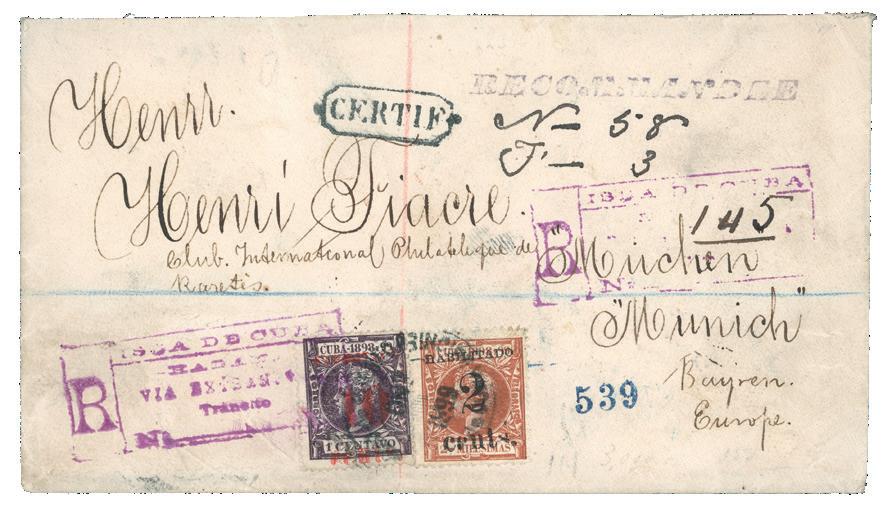
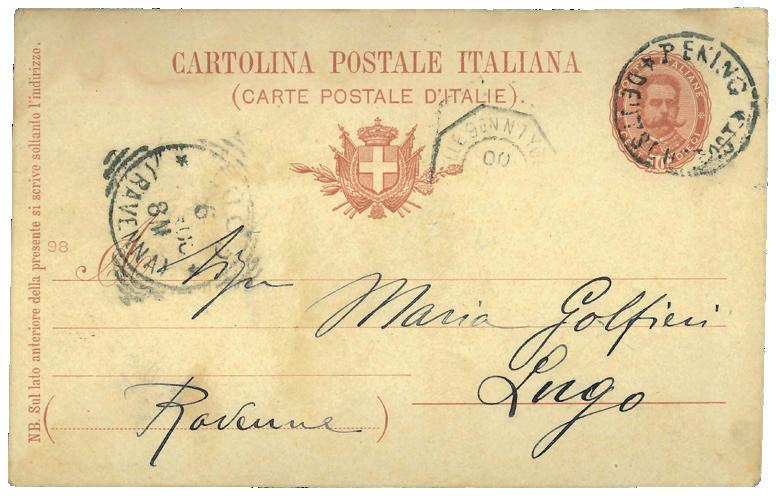
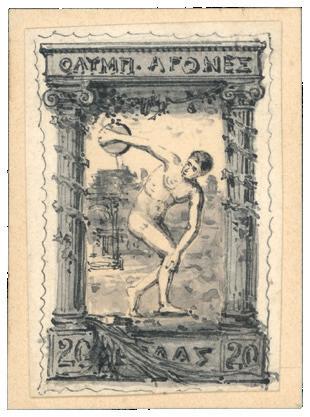

� France and Colonies
� Great Britain and British Empire
�
The Jack Thompson Collection of Puerto Príncipe
� Olympic Games and Football
� All World Collections and Lots
Impressions of London 2022, an International Philatelic event
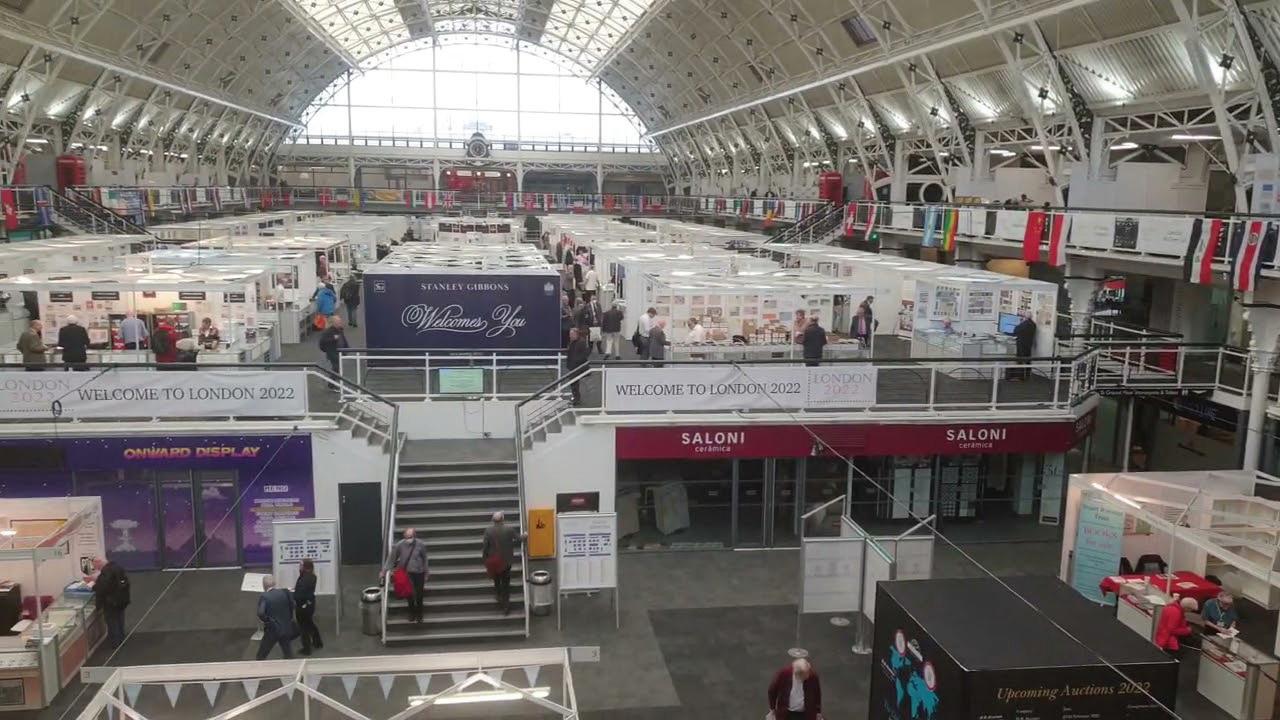 Mark Banchik
Mark Banchik
These thoughts are a personal impression of the recent event, as filtered through experiences at many prior FIP level international exhibitions. They are not recaps of awards, show events, or exhibit results, which can be found on the official show website www.london2022.co
Initial arrival at Heathrow was unlike pre-pandemic years. Yes, there was a “vibe,” yet crowds were much less of a factor than in recent past experiences. Passport control was completed in a matter of minutes, as compared with longer waits during past visits.
That helped set the tone for the week-plus visit: overall numbers of people were smaller, yet there was more “access control” of “flow control” to limit numbers physically present in specific locations. Many cultural institutions requested visitors book a spot ahead of time, or wait on entry for others to leave. As examples, both the British Museum and Tate sites asked visitors to book timed entry ahead of a planned visit, yet were very accommodating for “walk-ups.” Several galleries asked patrons to wait on a short line pending admission to better control crowding or allow greater spacing. Sir John Soane’s Museum, a gem of a townhouse located at Lincoln’s Inn Fields, instituted a one-way traffic flow scheme to help maintain visitor distancing.
Due to a confluence of weather events unrelated to Covid, Saturday and Sunday exhibition attendance was much lighter than similar events in past years. Though there were fewer visitors, many dealers reported better than expected trade results. The upside for trade and visitors was the opportunity to have longer chats with fewer distractions. I personally caught up with several longstanding acquaintances who savored the visits.
Islington has evolved over the years to encompass many smaller, localized
shops and services, which give it more of a flavor of a small village. Yes, there were the usual chain outlets closer to Angel Tube, yet within a few short blocks towards Camden Passage, Upper Street or Camden Market, one felt the difference. There were more shuttered storefronts than recent visits; however, those that were open were very accommodating. Local dining options were quite varied with availability from early morning through late evening.
Heading into the West End/Theatreland was like experiencing a time warp dating back a few years. Crowds in the areas of Covent Garden, Leicester Square and Trafalgar Square were younger and more vibrant. Compared with other areas where foot traffic was lighter with more spacing, these meccas were crowded and frenetic. This was in the context of many shuttered storefronts with others providing more limited services and/or hours.
Over several days exploring different neighborhoods, the differences and accommodations to them were manifest. The overall pace was slower, with more time for interaction. While there were some foci of crowding, people tended to be a bit more patient, or accommodating to adjusted circumstance than we have become accustomed to in the past.
Overall, the visit began with uncertain expectations. Most adapted to ongoing challenges in creating a positive vibe, or adjusting current circumstance. The experience was different than past visits, yet had a richness unique to the circumstance. There was more time for personal interactions.
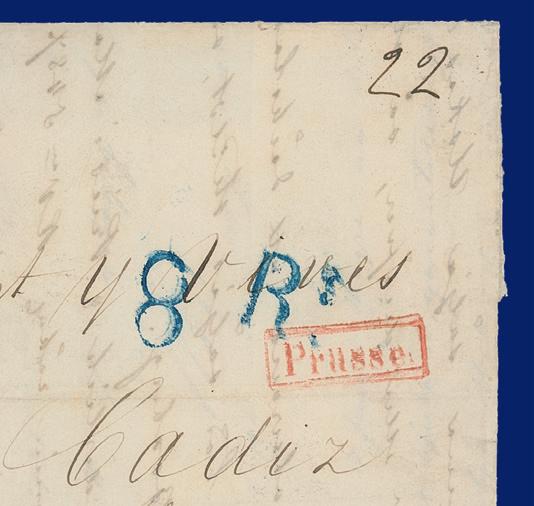
The London 2022 Organizing Committee and RPSL leadership deserve kudos for having the fortitude and foresight to achieve the successes that they did. London, as any area, is changed, and the opportunity for enriching experiences continues. We will see how this evolves over the course of time.
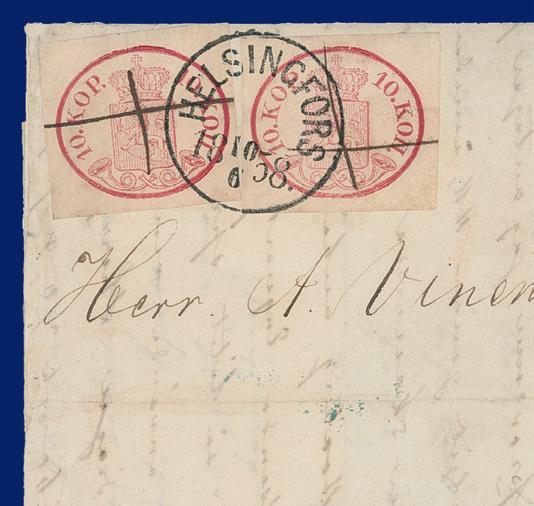

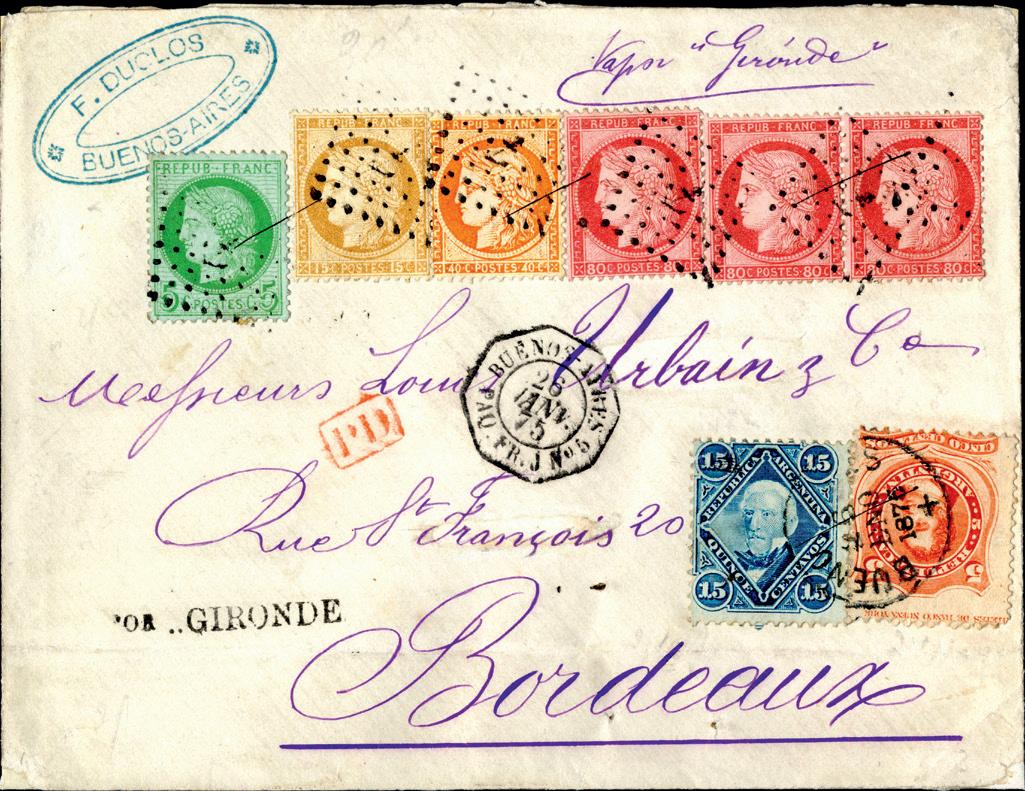



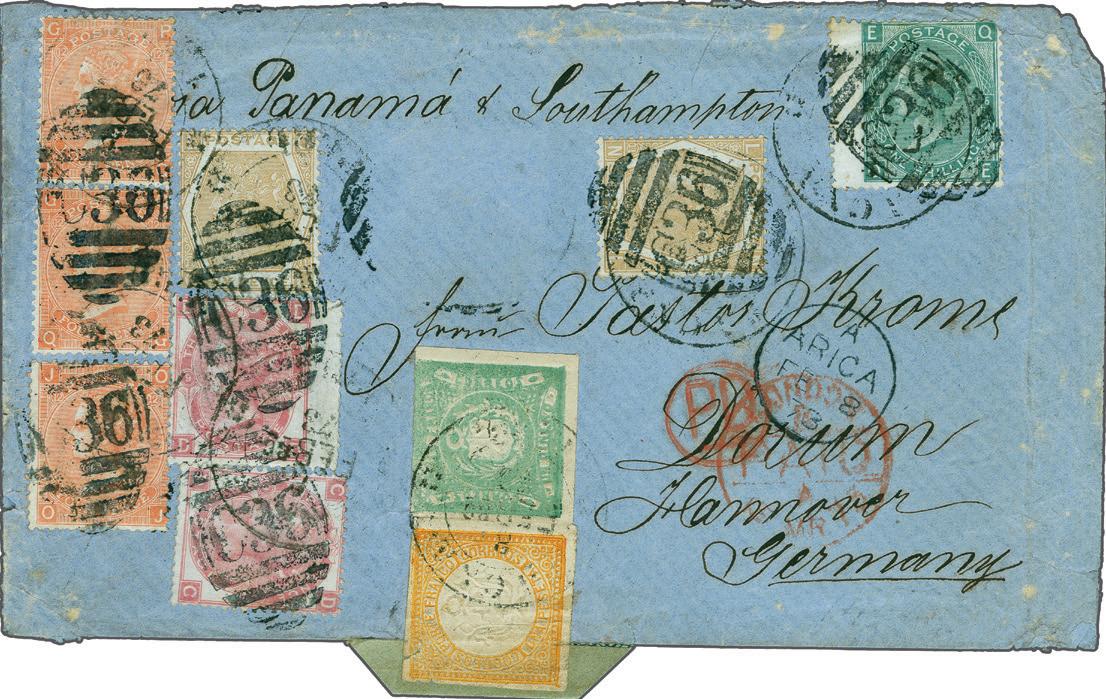

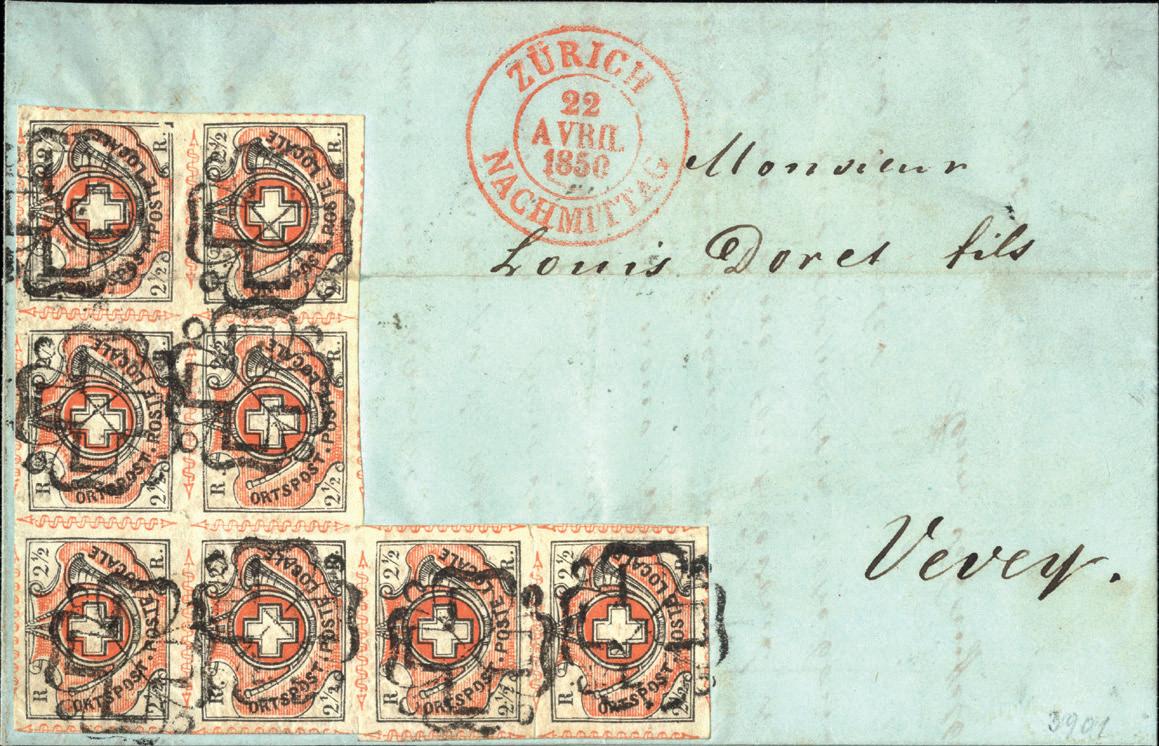

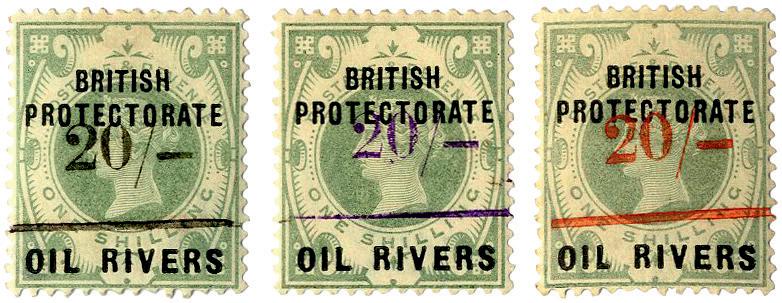


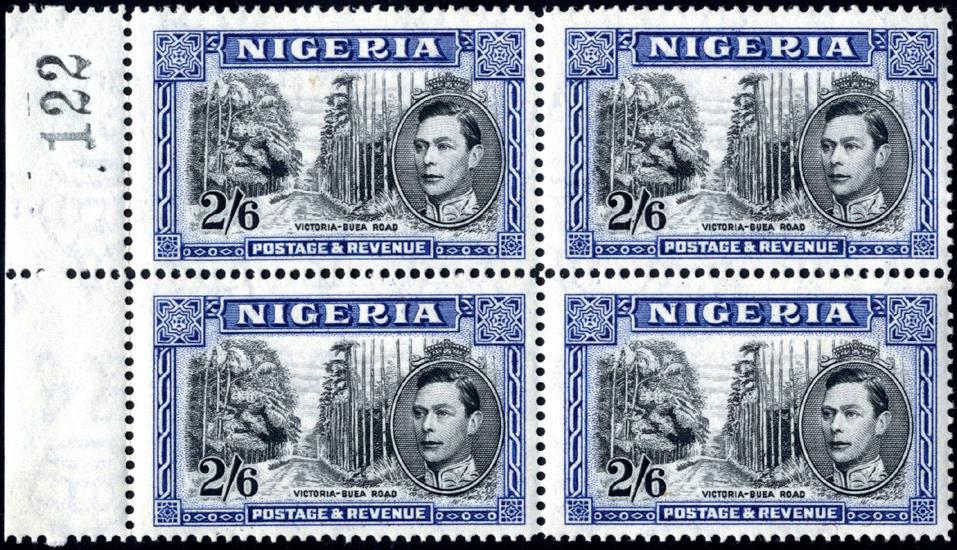

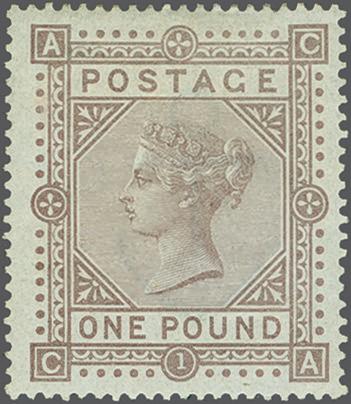


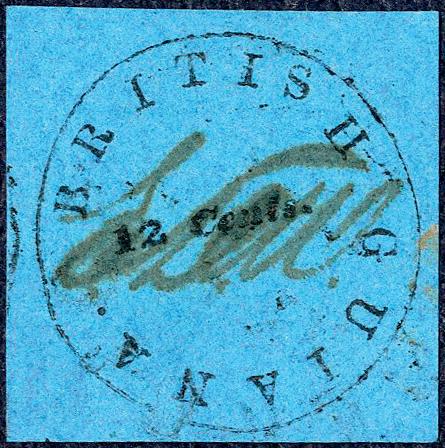







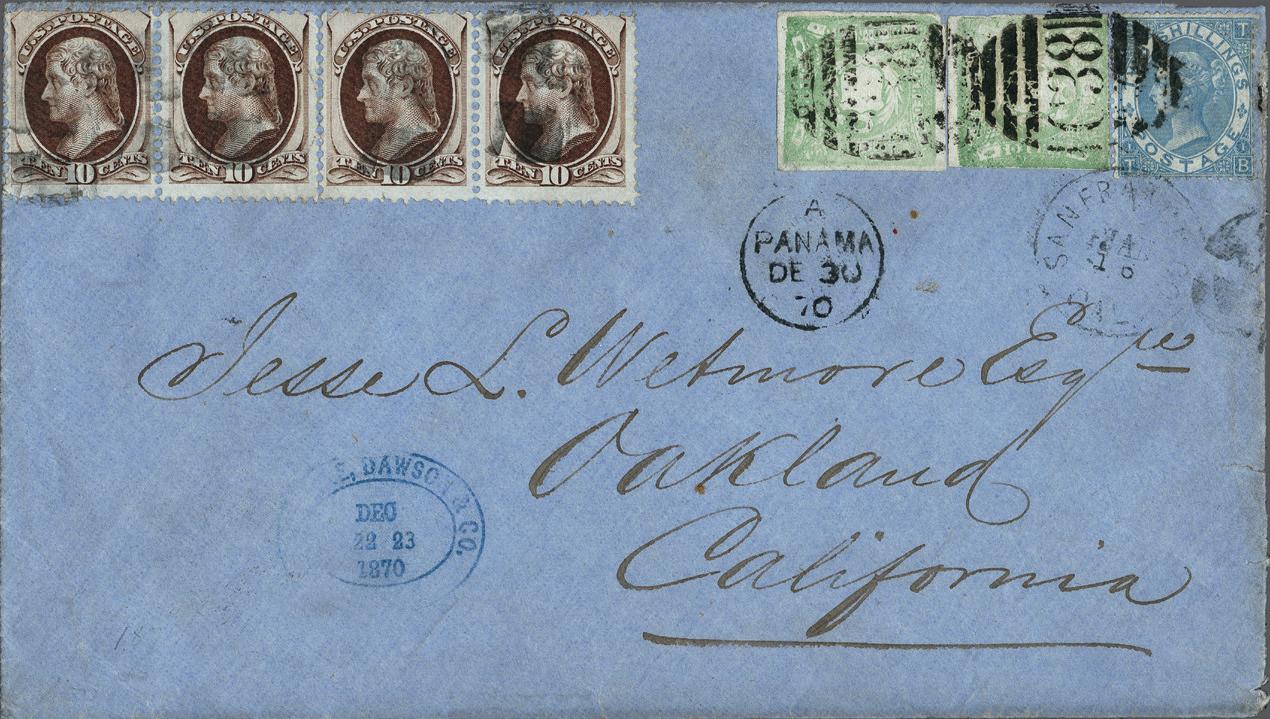



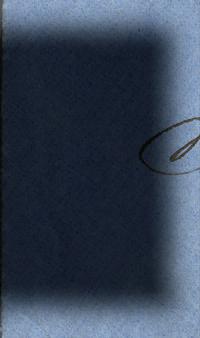

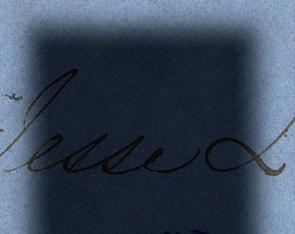

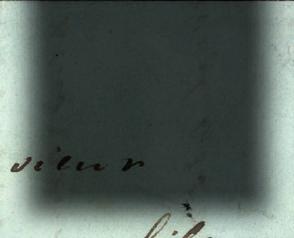
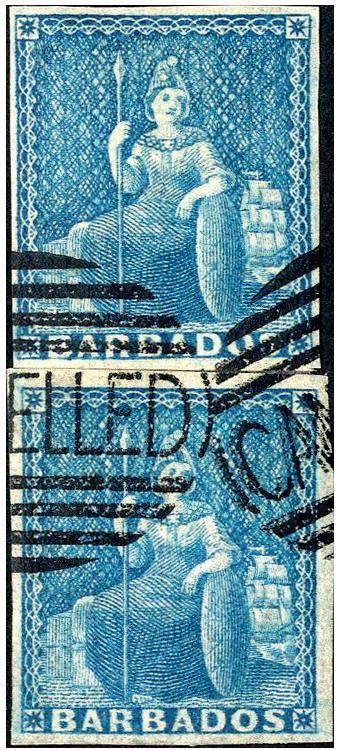



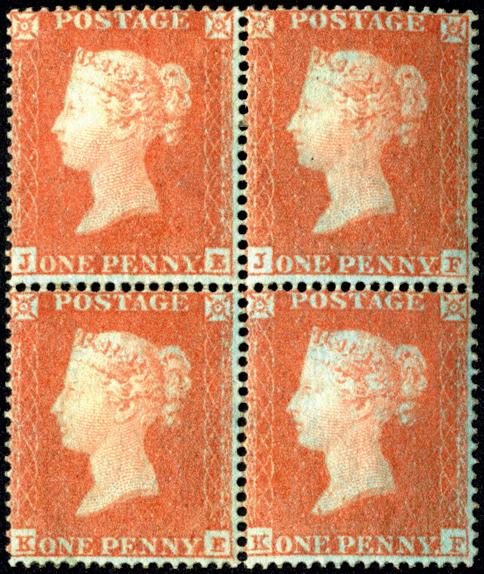

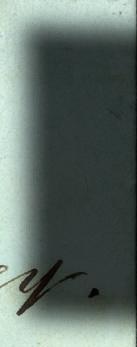
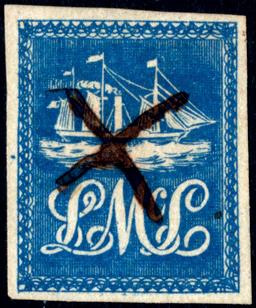
[
Mail by Stage Coach: The Carriage of Mail By Eastern Stage Lines
Before 18601
Steven RothEditor’s Note: Due to the length of this fascinating piece, it will be presented in more than one part. Part I appears in this issue; Part II will be found in the July-August CCP.]
General Organization and Scope of Article
This article is organized, as follows:
• Introduction to staging
• Staging in New Jersey and Delaware (together with ancillary comments concerning Baltimore, Philadelphia and New York City)
• Staging in New York State (other than New York City)
When I set out my following discussion of stage lines among various geographic areas of the East, I do so using New Jersey staging as my model. I have done this for two reasons: First, before I undertook my research for this article, I had already researched and briefly documented staging in New Jersey in an article I published in 2013 in the New Jersey Postal History Society Journal2 (NJPH). It made sense for me, therefore, to update and enlarge that research and to expand that article as the basis for this one. Second, staging in New Jersey reflects — albeit with different routes and different stage lines — the basic elements of staging in other locales in the East.
In this article, I do not name all the stage lines in the various geographic areas I cover. Nor do I name all the identified routes. That would be impossible. Furthermore, this is not a catalog.
There were too many stage lines to be able to identify them all and too many actual or potential routes to identify – and often – with respect to associating a particular cover with a specific stage line or stage route, too little identifying evidence. Instead, I have selected stage lines and staging routes that (i) describe the way staging operated, or (ii) illustrate some of the problems sometimes encountered by the collector of stage-carried covers and the student of staging operations.
I have not dealt in detail with the stage lines operating from Baltimore, Philadelphia or New York City. These cities are referenced when appropriate in the course of mentioning stage lines from other cities. The stage lines originating in Baltimore, New York and Philadelphia will each be the subject of a separate article in the future. I also have not covered staging in New England or in the South. These, too, in due course, will each be the subject of a separate article.
Because my 2013 staging article provided the framework for this piece, I spent much time in the National Archives and in the Library of Congress, in Washington, D.C., to update and expand my original research. I took time off from that effort during the Covid-19 lockdown in 2020-22, when those institutions were closed to the public. I used the lockdown time to organize and consolidate my additional research and, to a lesser extent, to research online some areas where I felt I needed to fill in gaps.
Unless otherwise noted, all covers illustrated in this article are in my collection.
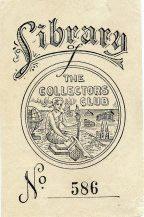
Introduction to staging
Prior to the War of Independence, major travel in the colonies was restricted for the most part to the waterways surrounding and flowing through the colonies. The Atlantic Ocean and major rivers served the colonies well for intracolonial and inter-colonial travel and communications for as long as settlements remained along the eastern seaboard.3
When travel in the colonial period was not on water, it tended to be on horseback. Goods often were transported by packhorse so that the limitations with respect to how much weight or bulk a horse could carry became an issue for merchants. Gradually, carts and wagons replaced packhorses for the carriage of freight. To effectuate this, roads were widened and smoothed out, and plank surfaces added. Eventually, the wagons began to carry passengers as well as freight.
Figure 1. Dateline: Elk July 12th, 1770. Sender wrote to addressee, “Sir, Please to send ans. per Stage.” This folded letter originated at Head of Elk, Md. (which is 21 miles south of Wilmington, Del.).
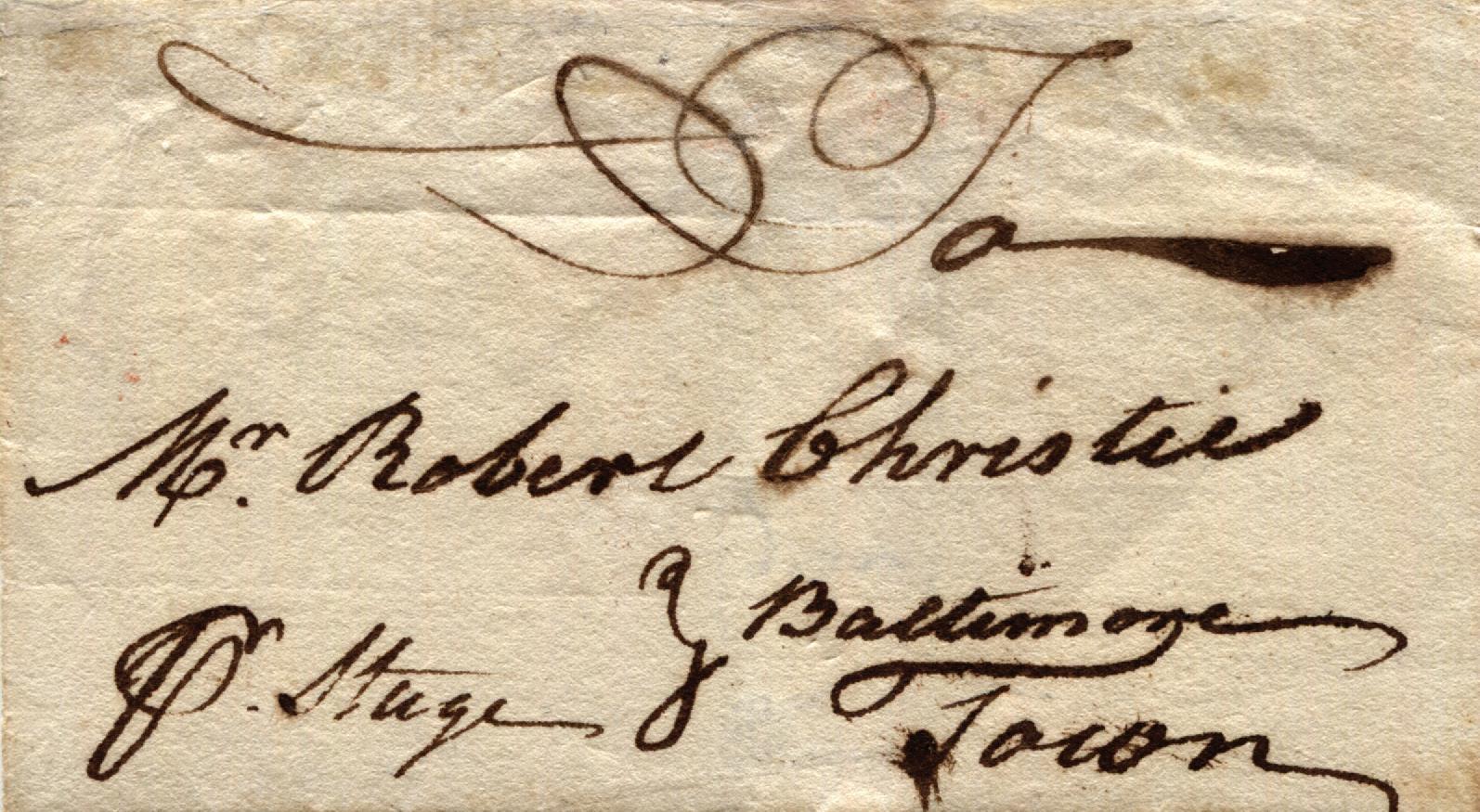
Figure 1 shows a colonial-period cover, endorsed “Pr Stage,” that originated in 1770 at Head of Elk, Md. (which is 21 miles south of Wilmington, Del.). Head of Elk (renamed Elkton) is located on the Elk River. The folded letter was carried out-of-the-mail to Baltimore Town. In 1770, Head of Elk’s population was 95 people. The town opened its first post office in 1776.
As the number of passengers increased, staging freed itself from the freighting business and fell into the hands of inn and tavern keepers who catered to the needs of passengers, thereby providing themselves with a steady source of income for their inns and taverns. Gradually innkeepers banded together to form
stage lines, with scheduled staging stops for meals and overnight lodging at the stage-owners’ inns. This became the pattern for future staging operations.
Figure 2 is datelined Oct. 8, 1773. This folded letter was carried by stage out-of-the-mail from Allentown, N.J., either by the Burlington Stage or by the Bordentown stage. It is impossible to tell which because these two stage lines competed over the same routes, except for their respective terminals at Burlington and Bordentown.
Staging During the War of Independence
Figure 3 is datelined English Town, Sept. 26, 1775. Stage mail during the War of Independence is scarce since most stage lines ceased operations once combat commenced in April 1775. Those few that remained in business closed down by the end of December as the war moved from New England to the Middle Atlantic colonies.
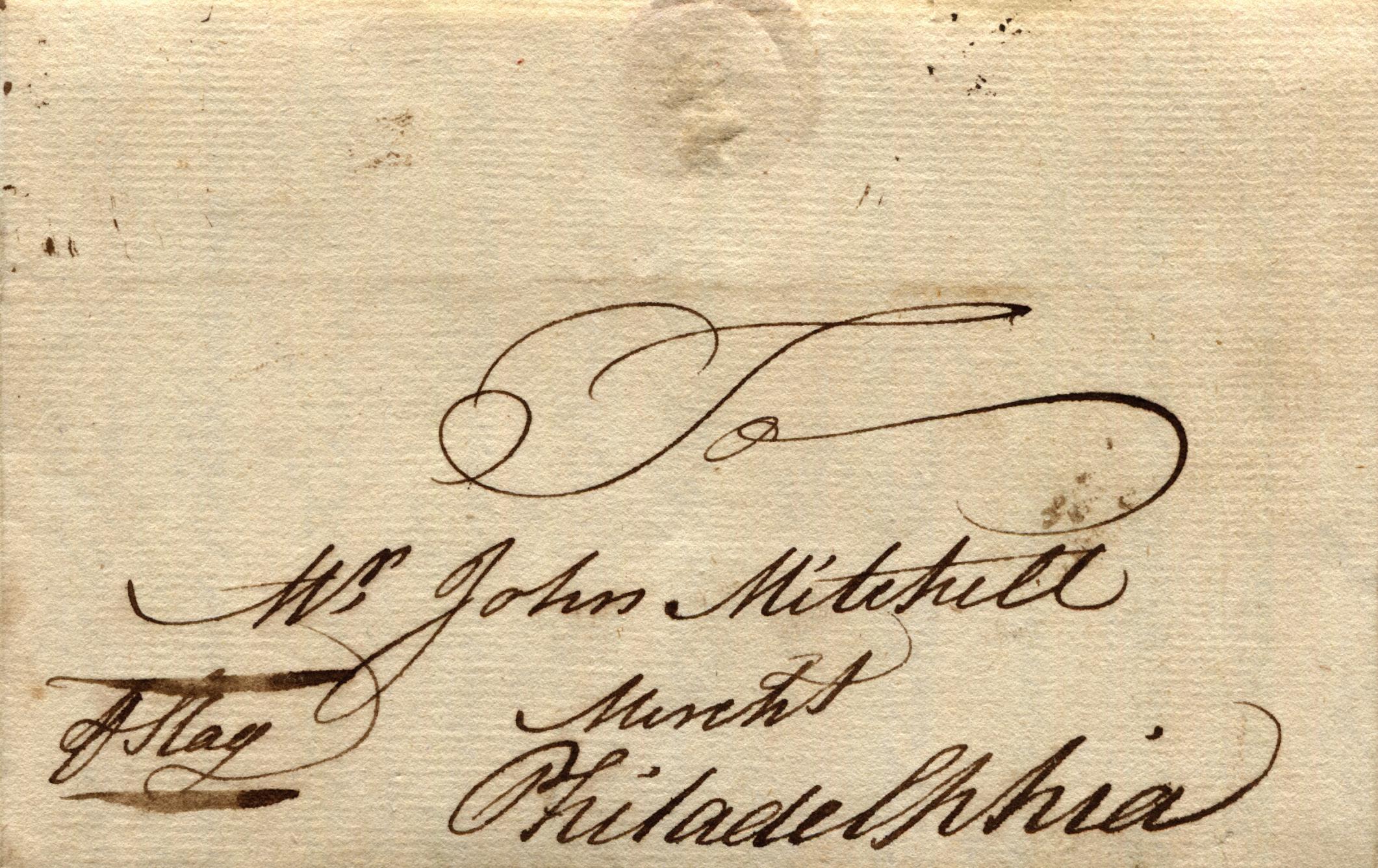
There is no documented stage route from English Town (present-day Englishtown in Monmouth County), N.J., to Philadelphia. It is likely, however, that there were one or more accommodation lines that serviced English Town and other small New Jersey towns nearby. These accommodation lines carried mail privately among the small towns they serviced or to and from one of the established through lines that carried mail between Philadelphia and New York (in both directions), acting as feeders for the through lines, bringing them passengers, mail (if the accommodation-line and the through-line had contracts to carry mail) and some freight from the interiors of the states.
Not only is it impossible to identify the accommodation line that carried Figure 3 on part of its trip to Philadelphia, it also is not possible to tell which through line carried the folded letter to Philadelphia after receiving it from the accommodation stage line. The likely choices are the Bordentown & New York stage, the Burlington stage, or the Trenton-Brunswick stage.
Figure 3. Dateline: English Town, Sept. 26, 1775. Stage mail during the War for Independence is scarce, since most stage lines ceased operations once combat commenced in April 1775. Those few that remained in business closed by the end of December as the War for Independence moved from New England to the Middle Atlantic colonies.
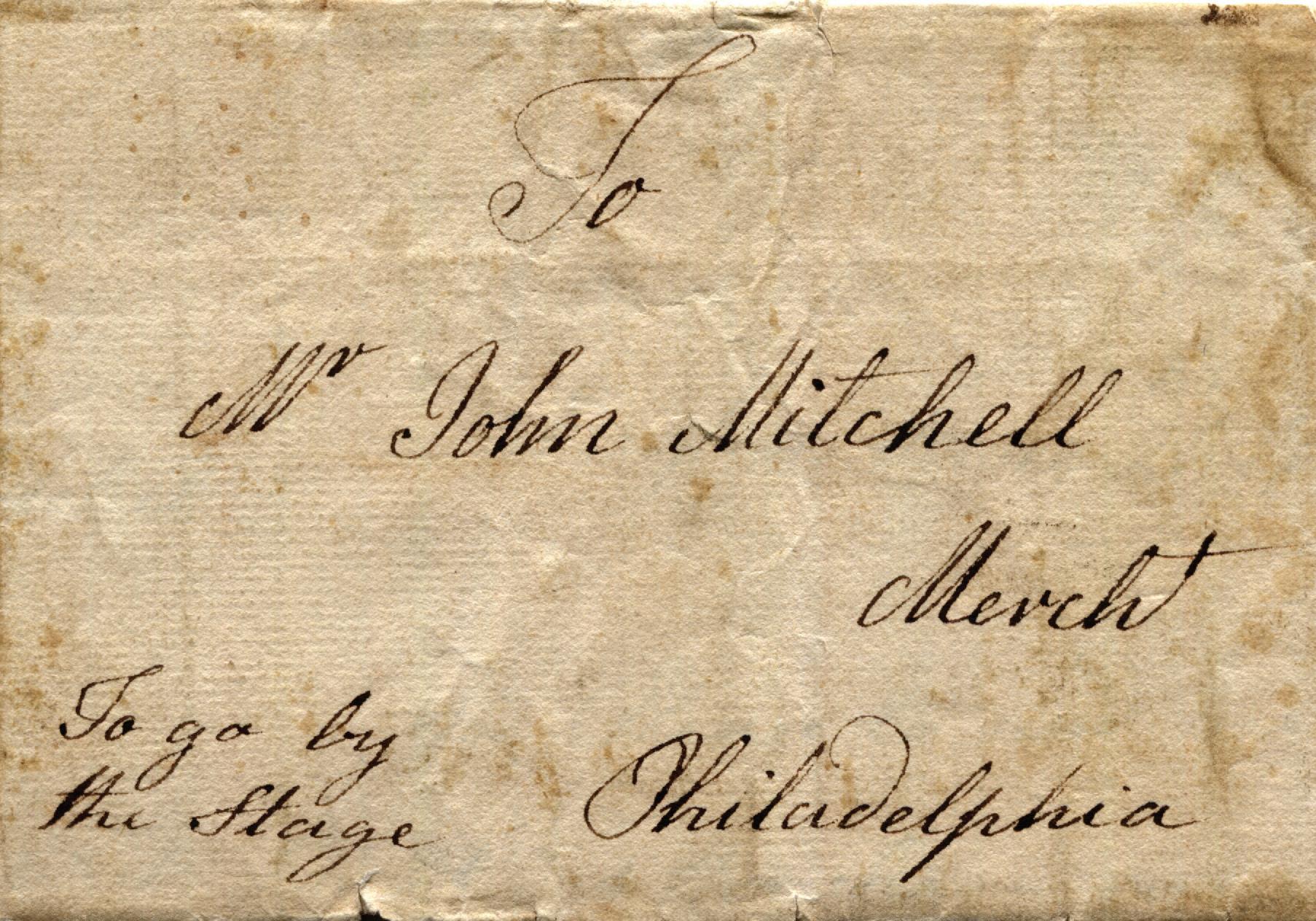
Each of these through stage lines met the Philadelphia stage boat (which was a barge) southwest of English Town (at Bordentown, Burlington and Trenton, respectively) along the Delaware River. The most likely hookup for Figure 3, based on the distance of the headquarters for the through-line from English Town, would, first, have been at Trenton, which was closest to English Town; then at Bordentown; and last, at Burlington. This, however, is speculative, not dispositive.
When the Figure 3 letter was mailed, the colonies had recently fought the British at Lexington and Concord, at Breed’s Hill and Bunker Hill, and were laying siege to Boston, which still was occupied by the British. Gen. Washington had recently taken command of the Boston siege as one of his first acts after being appointed commander-in-chief of the Continental Army on June 15.
The Importance of Staging
The carriage of newspapers (see, “Staging and the Carriage of Newspapers,” following) and the transport of mail became important sources of reliable income for stage lines. For the 45 years between 1785 and 1830, the stagecoach reigned supreme as the carrier of newspapers and mail on the nation’s leading post roads.4 Indeed, prior to 1800, there were few stages that did not carry newspapers and letters, albeit, sometimes on an informal and erratic basis. Increasingly, after 1800, as turnpikes and other roads were constructed and improved, and as the mail coaches were speeded up and the hours of travel by them were extended far into the night (so that passengers got little rest), the mail coach proprietors were forced to establish accommodation lines that, in turn, devoted their main attention to the comfort, convenience and safety of their passengers.
From Stage Wagons to Stage Coaches
When staging started, the first vehicles in the 18th century were heavy wagons whose main purpose was to carry freight. These eventually gave way to the lighter, so-called Jersey wagon produced primarily in Newark. The Jersey wagon passed through successive modifications for the comfort and convenience of passengers until it was replaced by the oval Jersey stagecoach, which was distinctive in style, and was often seen in newspaper advertisements for the carriage of mail. Such coaches, if the stage line had a contract to carry mail, were informally referred to as post coaches or mail coaches.
The Jersey wagon was the direct ancestor of the Albany and Troy coaches that, in the 1830s and 1840s, dominated the highways, and was the ancestor of the Concord coach that came into prominence in the 1850s on the American frontier.
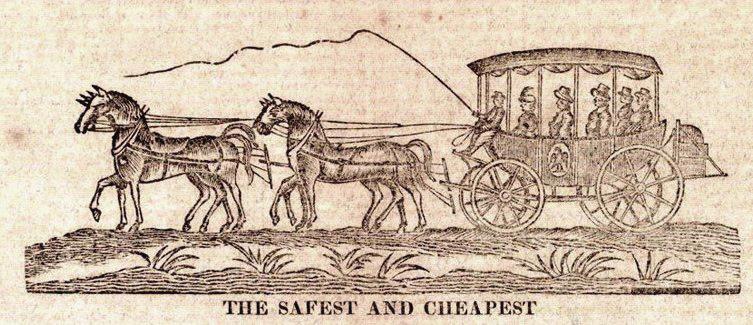
Staging as Reflected in Some City Directories and Traveler’s Guides
City directories and traveler’s guides have proven to be a fruitful source of information for postal historians. They offer the student of staging (as well as students of private local posts and government mail carriers) information that was available to contemporary citizens concerning the names, addresses, routes, and terminal and way stops of stage lines.
A typical city directory entry for staging would have looked like this:
From Cape May by Stage
To Miles
Woodbury 9 Jonesboro 19 Malaga 29 Millville 42 Port Elizabeth 48 Dennis Creek 62 Goshen 66
This, of course, is useful to the postal historian because we can use the stated, interval way stops to reconstruct the route taken by a cover if we know where the cover originated and ended.
Because New Jersey, as the example I am using here, largely acted as a cross-road for the commerce of Philadelphia and New York City, it is in the city directories of these anchor cities that we must look for information concerning inter-state staging. For intra-state staging (local and accommodation lines), we look to the city directories and newspapers of the major New Jersey towns and cities. The same is true, of course, when researching states other than New Jersey.
The first Philadelphia city directory to address New Jersey staging, for example, was the 1785 edition of Francis White’s Philadelphia Directory. 5 White gave the following concerning stages setting out for New York City from Philadelphia:
“Stages: “Sets out every morning at 4 o’clock for New York from Mr. Francis Lee’s, at the Indian Queen, and from Mrs. Paul’s, at the Indian King; others return the same day.
154 www.collectorsclub.org May-June 2022
“A stage-boat leaves the Crooket Billet wharf for New York, at tide time, every Sunday and Wednesday morning; returns are made from Coemtie’s dock, “New-York, every Monday and Thursday.”6
The Philadelphia directory for 1793 also addressed staging from that city to New York: 7
“NEW-YORK STAGES.
“There are at present four stages that ply between this city and New York, two of which set off at three o’clock in the morning, and arrive at New-York that evening; the one, from James Thompson’s, at the Indian Queen, 15, So. Fourth St., the other, from the city tavern, 86 So. Second St. A stage sets off from the George tavern, corner of Second and Mulberry Sts. precisely at half past 8 o’clock in the morning, and on Saturday at 6 o’clock, and arrives at New-York the succeeding day by 1 o’clock.
“The mail stage sets off at 1 o’clock, P. M. from Mr. Anderson’s, at the sign of the sorrel horse, 39, No. Second St. carries only four passengers, and arrives at New-York in 21 hours, after its departure. The fare for each passenger in these stages, is four dollars, and four pence per mile for way passengers.
“A New-York packet-boat starts from McKean & Van Emburgh’s wharf, the first wharf below Mulberry St. on every Sunday, Tuesday, Wednesday, and Thursday, and proceeds to Bordentown or Burlington (each place alternately), from one of which places one or more good carriages start on the succeeding morning for South Amboy, from which port a convenient packet will sail for New-York immediately after their arrival. The fare for each passenger is two dollars.”
The directory for 1805 addresses land stages, water stages and stage boats leaving from Philadelphia for New York.8 A similar listing appeared in 1810 with the addition of two other stage lines: the Dover Stage and the New York Mail Pilot line:9
1805 LAND AND WATER STAGES 1810 LAND AND WATER STAGES
LAND STAGES:
Allentown Stage from Franklin & Camel Inns, Wednesdays & Saturdays, 5 a.m.
Boundbrook Stage, from 18 North Fourth, Every day, Sundays excepted, 6 a.m.
Coryell’s Ferry, Crooked Billet, Cross Road, Swift Sure Stage, from 18 North Fourth daily, Sundays excepted, 8 a.m.
Collectors Club Philatelist
LAND STAGES:
Allentown Stage from Camel Inn, Wednesdays & Saturdays, 5 a.m.
Bound-Brook Stage, from 50 North Fourth, daily, Sundays excepted, 8 a.m.
Coryells’ Ferry, Crooked Billet, Cross Road, Swift Sure Stage, from 50 North Fourth daily, Sundays excepted, 8 a.m.
155 Volume 101, Number 3
Brunswick Stage, from Arch St. ferry, Wednesdays and Saturdays.
New York Diligence, George Inn, every day, Sunday excepted, 8 a.m.
Brunswick Stage, from Mulberry-street Ferry, Wednesdays and Saturdays.
New York Diligence, George Inn, 18 South Third, daily, Sunday excepted, 8 a.m.
Dover Stage, George inn, Mondays, Wednesdays, and Thursdays, 5 a.m.
New York, U.S Mail, Hardy’s Inn, every day, Sundays excepted, at noon.
New York, U.S Mail, George inn, and 18 south Third, daily, noon.
New York Mail Pilot, 18 South Third, and 9 south Fourth, daily, noon.
New York Commercial Stage, George Inn, every day, Sundays excepted, 2 a.m.
New York Federal Line, Indian Queen, every day, Sundays excepted, 8 a.m.
New York New Line Industry, from 50 N. Fourth and George Inn,daily at 7 A.m. and George Inn, daily, at 7 a.m.
New York Swiftsure, 18 North Fourth, every day, Sunday excepted, 8 a.m.
New York Commercial Stage, George Inn, every day, Sundays excepted, 2 a.m.
New York Federal Line, Indian Queen, every day, Sundays excepted, 8 a.m.
New York Newline Industry, 9 south Fourth and George Inn, daily, Sundays excepted, at 8 a.m.
New York Swiftsure, 50 north Fourth, daily, Sunday excepted, 8 a.m.
Somerset, Scotch Plains, Springfield, Swiftsure Stage, from 18 N. Fourth, daily, Sundays excepted, 8 a.m.
Trenton Stage, 84 North Front, every day, Monday excepted, 7 a.m.
Somerset, Scotch Plains, Springfield, Swift Sure Stage, from 50 N. Fourth, daily, Sundays excepted, 8 a.m.
Trenton Stage, 45 North Third, daily, 7 a.m.
WATER STAGES AND PACKETS: WATER STAGES AND PACKETS:
Bordentown Packet, from Smith’s wharf, Sundays & Wednesdays, Tuesdays & Thursdays alter.
Burlington Packet, from Old Ferry, every day.
New York Packet, from Old Ferry, Sundays & Wednesdays, Tuesdays & Thursdays altern.
Trenton Packet, from Old Fery, Wednesdays & Satudays.
Bordentown Packet, from Smith’s wharf, Sundays and Wednesdays, Tuesdays and Thursdays alternately
Burlington Packet, from Old Ferry, daily
Trenton Packet, from Old Ferry, Wednesdays & Saturdays.
Amboy packet, Old Ferry, daily.
Amboy South Imlay’s wharf, Sundays, Tuesdays, Wednesdays and Fridays.
The Problem of Naming Stage Lines
There is no accepted uniform standard in postal history collecting or scholarship for referring to the names of stage lines. In some instances, where we know the points of origin and termination of a stage line, we refer to the line by those names (e.g., Bordenton & New York stage [see Figure 8] or the TrentonBrunswick stage).
Where we have less information, for example, if we do not know the place of origin of the folded letter, we sometimes refer to the stage line by the name of the town that appears on the folded cover as part of a dateline or in an external endorsement (e.g., the Millville stage, see Figure 27), based on the dateline, or based on its destination (e.g., the Camden stage, see Figure 25). In some cases, such as the contemporaries who sent their mail via stage when they referred to the stage lines in letters, we refer to the stage line by the name of its stage driver (e.g., MB Wills’ stage, see Figure 26).
Contract-Carried Mail vs. Non-Contract-Carried Mail
When we look at stage mail, we consider two types of such mail: mail carried by stages having a contract to carry mail (Contract Stage line) and mail carried by stages not having a contract to carry mail (Non-Contract Stage line). Mail carried
by a Contract Stage line was carried over designated post roads. Mail carried by Non-Contract Stage lines, under the Constitution beginning in 1827, was not permitted to be carried over post roads, subject to some exceptions relating to the carriage of mail without remuneration.10
Among the mail carried by a Contract Stage line, there are two types of contract mail to consider: (i) mail that was processed by a post office, placed in a locked box or bag and the locked box or bag given to the stage driver, and (ii) loose letters handed to the driver or to a passenger by senders, or by a third party, rather than taken by the sender or third party to the post office for processing and bagging. This latter group of letters often contained a redundant “instruction” (redundant because the sender or designated third party handed the letter to the stage driver or to a passenger, so no such instruction on the folded letter was necessary) such as “per stage,” “per stage driver” or their equivalent. Loose letters given to a stage driver who operated a Contract Stage line generally were marked “Way” when they were turned in to the post office by the driver under the regulations relating to Way mail.
Figure 4. Loose cover given to the driver of the mail stage. The driver turned the folded letter in to the post office where the folded letter was marked “WAY” and rated “due” for the distance between the place the stage driver received the cover and its destination.
The Figure 4 letter originated in Boston on Dec. 31, 1789, and was delivered to Stavers’ Portsmouth stage line as a loose letter. The content states that the sender will “give the letter to Stavers.” Stavers’ Portsmouth stage line held the contract to carry the mail between Boston and Portsmouth three times a week in summer and twice in winter.
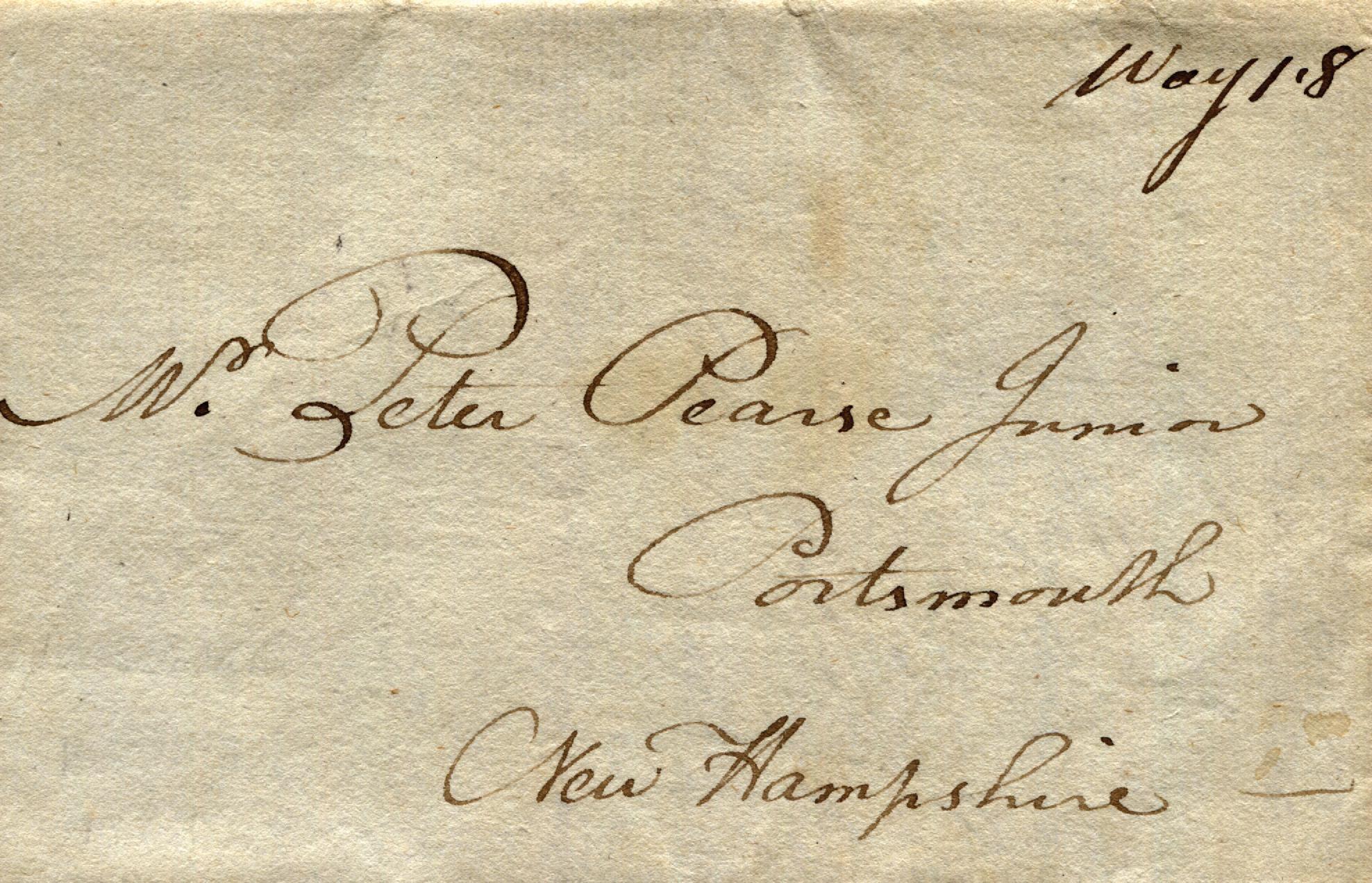
Stavers’ route between Boston and Portsmouth was: Boston → Cambridge → Salem → Ipswich → Newbury → Newburyport → Portsmouth.
When the Stavers driver reached Portsmouth he delivered the letter to the post office where it was marked “Way” and was rated 1.8 [1/8] for the distance 61-100 miles between Boston and Portsmouth. Before 1799, Way fees were not paid to the driver.11
158 www.collectorsclub.org May-June 2022
In the case of covers delivered to the post office for further transmission and placed by the postmaster in a locked box or bag [“(i)”previously mentioned], the covers in the box or bag generally did not receive any special post office notations or markings indicating carriage by stage (although some senders placed gratuitous “by stage,” etc., endorsements on the covers). These covers looked like all other covers, having only customary postmarks, rate statements and cancellations (if the covers bore a stamp). One can only determine stage carriage of such locked box or bag mail by ascertaining the post routes of such letters and by becoming familiar with the stage mail contracts for such routes.
Figure 5. This 1787 folded letter, carried on the stage in a locked box from Baltimore to Philadelphia, can only be assigned stage-carried status based on its route at the time there was a stage contract to carry the mail on that route. There were no special markings for such locked box or locked bag mail.
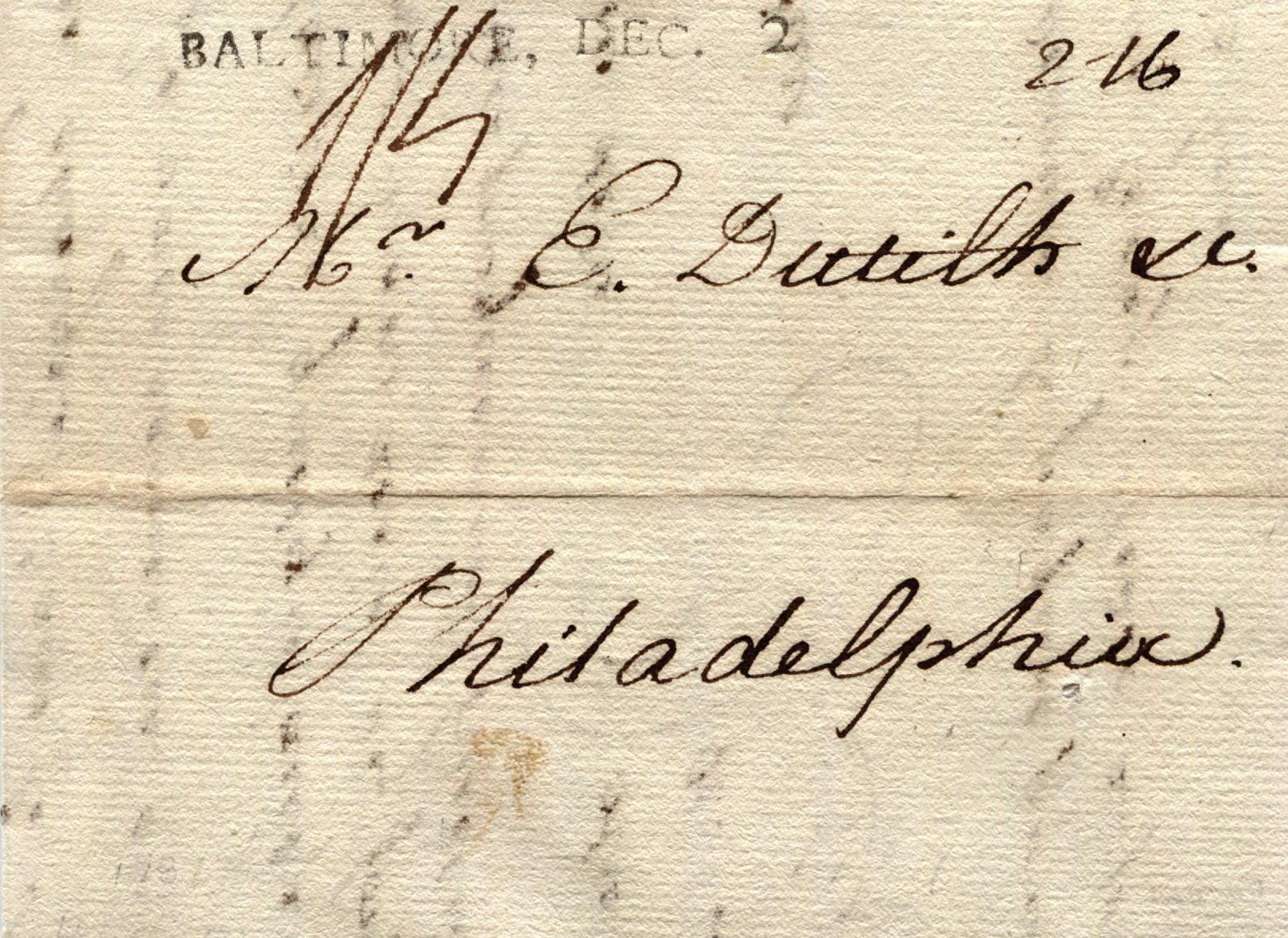
Figure 5 illustrates this. After a reluctant start, in 1787 Postmaster General (PMG) Hazard entered into contracts with stage lines to service both main post routes and many cross routes (see “Staging and the Carriage of Mail in the Confederation Period,” following). One such route covered the mail from Philadelphia to Baltimore, in both directions, and involved the use of a stage boat to cross the Delaware River. The Figure 5 letter was carried on one such route from Baltimore to Philadelphia.
The contract for this stage route was held by Messrs. Inslip & Cumming who, at this time, also held the contract to carry the mail between New York City and Philadelphia. Under the Philadelphia – Baltimore contract, Inslip & Cumming were required to make five trips per week in each direction.
Route: Baltimore → Chesapeake Bay → Frenchtown → New Castle → Delaware River → Philadelphia.
The Baltimore packet (a common term used for sloops having a contract to carry mail because they kept regular, published schedules) left Baltimore and sailed to Frenchtown. There, the mail bags were placed on a carriage and taken
to New Castle. At New Castle, the mail bags were placed aboard a stage, which, in turn, was driven aboard the stage boat and carried across the Delaware River to Philadelphia. Once at Philadelphia, the stage disembarked and headed for the Indian Queen Tavern at 15 South Fourth Street, where the mail was taken off the stage, placed on a wagon and carried to the Philadelphia post office.12
Letters carried by a Non-Contract stage were equivalent to (but were not) loose Way letters as previously discussed. These loose letters were carried either as an accommodation to the sender or for private remuneration given by the sender or a third party to the driver or to a passenger for such service. Such letters often were privately marked on their face to indicate stage carriage. These are not postal markings. As previously stated, such mail, beginning in 1827, could not, with a few exceptions, be lawfully carried over post roads, whether or not remuneration was paid to the driver or a passenger for such carriage.13
Stage Boats
Stage boats were barges (sometimes referred to as ferries) that were large enough to carry one or more stage wagons or stage coaches. These vessels were used in the west area of New Jersey to cross the Delaware River to and from Cooper’s Ferry (present day Camden) or to and from Trenton, Bordentown and Burlington, to go to and from Philadelphia. They were used in New Jersey in the east to and from Amboy to travel to and from Lower Manhattan.
The Role of Inns and Taverns in Staging
As previously noted, although the carriage of freight initially proved to be the impetus for developing staging, in due course the carriage of passengers, as a way of providing taverns and inns located along the stages’ travel routes with a steady stream of customers and income, proved to be the strongest motivating force for the development and operation of stage lines. Indeed, many of the first stage lines and ferries were created by consortiums of inn and tavern owners who scheduled the staging runs and ferry crossings to coincide with the eating of breakfast, lunch or dinner, or the lodging of passengers overnight at the stage-owners’ inns. The practice of inn and tavern owners having an ownership position in stage lines continued throughout the staging era.
Staging and the Carriage of Newspapers
A principal reason for the dependence of the Post Office Department (POD) on the country’s expanding staging facilities was the ever-increasing burden of newspaper carriage. Until 1792, newspapers had not been officially carried as part of the mail, but were carried by private or public post riders or by stage drivers who, with the silent acquiescence of the POD, made their own private arrangements with the printers for remuneration.14 Under such “off the book” arrangements, newspapers were carried along with the mail.
The informal practice of permitting printers of newspapers to exchange copies of their product with other printers became an increasing burden for the POD as the numbers of newspapers in print increased. Indeed, the practice was so prevalent, and so embedded in the printing industry, that Congress included a provision authorizing the practice in the Acts of 1792, 1794 and 1810.15 The Post Office Act of 1792 made the first codified reference to the free exchange of newspapers among printers.16
160 www.collectorsclub.org May-June 2022
The Act of 1792, provided:
“Sec. 21. And it be further enacted, That every printer of newspapers may send one paper to each and every other printer of newspapers within the United States, free of postage, under such regulations, as the Postmaster General shall provide.”
The Act of 1792 also provided the first rates to be charged for newspapers: 1¢ for one newspaper carried up to 100 miles; 1½¢ for one newspaper to be carried any distance further than that.17 The rates were somewhat modified in the Act of 1794, to also allow a 1¢ charge, regardless of distance, for any newspaper carried within the boundaries of the originating state.18
As the country became more populated and as the availability of news became more critical to commerce and politics, the burden of transporting newspapers in the mail via horseback and the burden of protecting the newspapers from loss or damage became impossible to cope with. This was recognized in the regulations promulgated under the Act of 1794 19
“27. Complaints of the failure of newspapers have been so frequent, it seems necessary to take some further precautions for their security.
“The papers are commonly so wet when packed, and the covers so slight, that the bundles get broken, the papers worn and defaced, and the names of the persons and offices addressed, are rendered illegible.
“To remedy these mischiefs, the printers are desired to dry their papers, at least to a certain degree, and to wrap them in strong covers, especially when the bundles are large, or they are addressed to distant places. —If a bundle should contain more than 20 or 30 papers, it will probably break, and suffer in the conveyance. As a further security, every large bundle should be tied. It is not necessary to leave these wrappers open at one end: on the contrary, let them entirely enclose the papers, and be fastened with paste as usual. But if within these outside wrappers, any of the papers enclosed are put under other covers, these inner covers must be open at one end, as the law directs. And if any papers arc to be delivered by the mail-carrier, between the office where they are first lodged and the next post-office, these also, if covered at all, must have their cover ;pen at one end. Without this degree of care in drying and packing of newspapers, the printers ,are not to depend on their reaching their subscribers and others for whom they are destined.
“Unless newspapers have their covers open at one end, the postmaster cannot tell what is enclosed; and with close covers, having the appearance of letters, letter-postage must be charged on them. Besides, unless newspapers were liable to the inspection of the postmaster, many impositions would be committed, by inclosing with them letters and papers for which letter-postage ought to be paid. This liability to inspection, and the penalties provided in the law, are intended to guard against such fraudulent practices.
“The number of papers in a bundle must be marked on the wrapper, and those for printers and subscribers distinguished by the letters P. and S.
Volume 101, Number 3 Collectors Club Philatelist
“When newspapers are sent to public officers entitled to receive them free, the number sent to them may be separately noted on the wrapper which encloses them with others.”20
This gave rise to the necessity of using stages (rather than post riders on horseback) not only to handle the weight of the many newspapers, but also to protect the physical condition of the newspapers while in transit.
Combined with the complaints from printers that they could not adequately dry the ink on their papers under the required shipping schedules, and other related complaints from printers, Hazard, and his three successor PMGs under George Washington’s administration, had their hands full.
This became clear in 1788 when, in the course of a contract-renewal dispute between Hazard and the Contract-Stage lines operating between Boston, New York City and Philadelphia, Hazard, unable to resolve the dispute to his satisfaction, put the mail back on horseback. He discovered, to his dismay, that the post riders could not service these routes using only one post horse each. There was too much mail (and non-mail newspapers); it was too heavy for one animal to carry. Thereupon, it became a common sight along these routes to see a post rider mounted on a lead horse, with a dozen or more horses following him, tethered together, as they slowly walked between cities.
The question whether stages should carry the mail, and whether the post office should officially carry and deliver newspapers, became hotbed topics for dispute during the Confederation period, and eventually ended Hazard’s career when he repeatedly offended George Washington, who was a great proponent of using stages to carry mail.
While the argument that newspapers informed the public and, therefore, their carriage should be subsidized by the post office eventually prevailed, the financial and operating burdens of this democratic philosophy upon the POD were substantial before the Act of 1792, when printers were first required to pay postage for their newspapers.
Staging and the Carriage of Mail During the Confederation Period
In researching and writing this article (and in defining the outer time limits of my collection of Confederation period postal history, a collection which overlaps with, but also is broader than my eastern stage mail collection), I have arbitrarily defined the dates of the Confederation period based on its postal history, not on historic events. My beginning date for the Confederation period starts with the traditional beginning date for this period – Nov. 15, 1777, the date the Articles of Confederation were ratified by the states. My ending date, however, extends beyond the traditional ending date – June 20, 1788, the day before the Constitution was ratified by nine states. For purposes of this article, and of my postal history collection of eastern stage covers and Confederation period postal history, I use June 30, 1792, as my ending date for the Confederation period, the day before the first postal law under the Constitution (Act of Feb. 20, 1792, effective July 1, 1792) became effective. Prior to this arbitrary ending date, early Constitution-period mail was still governed by Confederation period postal acts and ordinances.
162 www.collectorsclub.org May-June 2022
The natural increase in trade and travel after the cessation of hostilities during the War of Independence formed the incentive for the creation of most stage lines. In some cases, however, stage entrepreneurs had to be encouraged by the granting of monopolies for a fixed term of years. This occurred in New York state in 1785, when Isaac Van Wyck, John Kinney and Talmadge Hall were granted a 10-year monopoly for the stage run along the east bank of the Hudson River, between Albany (which was not yet a post office in the federal system, but was still a state post office) and New York City (which was part of the federal post office system).
This also occurred in 1784, in Virginia, with the grant of a three-year monopoly to Nathaniel Twining and John Hoomes for the stage route between Alexandria and Petersburg. And, again, by way of example, in 1785, in Maryland, when the state granted the privilege for three years to Gabriel Van Horne to run stages between the Susquehanna and Potomac Rivers. There are many other examples of such stage monopolies.
This practice was necessary in such geographic regions to encourage stage line investment and operations where the population was not yet sufficient to support competing stage lines. Such monopolies were not necessary (and did not occur) in New Jersey, for example, where the combination of the population, general business and trade and the existence of the commercially successful anchor cities of New York and Philadelphia made competition not only feasible, but also likely, so that rival stage lines repeatedly sprang up. Indeed, in 1786, New Jersey found its roads so busy with stage traffic that the state levied an annual tax in the amount of 150£ on each stage line that crossed the state between New York and Philadelphia. The tariff was hotly protested by the federal government,21 and the amount was lowered the following year to 100£.22 To appease the stage line operators, the New Jersey legislature agreed that one-half the collected tax would be used each year to improve stage roads. Finally, in 1799, the New Jersey legislature exempted all stage lines from the need to purchase an operating license and to pay the tax.23
The greatest incentive to the development of staging came in 1785, when the federal government decided to contract with stage lines to carry mail. This not only resulted in steady income for the stage lines, but offered them the imprimatur of the fledgling government in the form of semi-official status. This placed the power and authority of the government and the greater interest of the citizenry behind the stage lines, especially during the period of the ratification debates involving the federal Constitution, when the consumption of newspapers increased dramatically. Now, people who rarely or never traveled by stage became interested in their success because stages became the means by which news (in the form of mail and newspapers) was received and forwarded. Members of Congress became sufficiently invested in the expansion and welfare of the stage lines which vitally affected the interests of, and received so much attention from, their constituents, that Congress granted mail stages special privileges, such as rights of way at ferry crossings.
Yet it was not at all clear that stages should be involved in the carriage of mail. The practice became a significant and heated controversy of the Confederation period, encountering opposition from PMG Hazard. Eventually, stiff pressure on Congress from commercial interests, as well as Congress’ desire
Collectors Club Philatelist
163 Volume 101, Number 3
to increase POD revenues by eliminating the clandestine private carriage of letters by stage drivers and passengers, won the day. After significant debate, Congress in 1785 ordered Hazard to employ stages in the carriage of mail.
The practice of stage drivers secretly carrying mail for pay was a significant economic factor for stage lines – if an unstated one – in the debate over using stages to transport mail. The practice had given rise to the first stage-mail contract in North America in 1773, with the British efforts to capture the lettercarrying business from a stage driver named Stavers, who operated between Boston and Portsmouth. As Hugh Finlay reported in his journal, it was cheaper for the British Post Office to hire Stavers and to pay him more than the 10£ he annually made from secretly carrying mail (and, thereby, to recoup his salary and any profit) than it would be to compete with Stavers.24
Other stage drivers, of course, including those in New Jersey, also secretly carried mail and benefitted from the remuneration paid them by senders. This practice resumed with the restoration of stage service after the War of Independence, into the Confederation period, notwithstanding the Ordinance of 1782, which specified that the PMG, his deputies and agents, “and ... no other person whatsoever shall have the receiving, taking up, ordering, despatching, sending post or with speed, carrying and delivering of any letters, packets or other despatches from any place within these United States for hire, reward, or other profit or advantage.” 25
Time proven Showgard®
Mounts...
–Showgard Mounts are the choice and recommendation of experienced collectors. –For over 25 years Showgard Mounts have proven perfectly safe for stamps under every climatic condition in all parts of the world.
–It is a philatelic fact that collectors switch to Showgard Mounts as they gain in experience. It’s a sensible idea to start and save with Showgard Mounts. At dealers everywhere. Available with Dark Display or clear see-through background. For Free Sample and Size Gauge

Showgard House 115 North Route 9W Congers, NY 10920
To enforce this law and end the illicit practice among stage lines, in December 1784, Hazard successfully brought suit against Gershom Johnson of Philadelphia, and obtained an injunction that required that Johnson cease carrying mail and that he pay damages for past practices. It is likely that Johnson had been selected by Hazard as a demonstration case to serve as a warning to other stage operators because Johnson operated on the busy route across New Jersey, between New York City and Philadelphia where, according to Hazard, the evasion of the law was most pronounced. The lawsuit was a highly visible, in terrorem, test case and warning.26
But the illicit carriage of letters was only one consideration for Congress to address when it debated the question whether
stages should carry mail. There were practical problems, too. One such issue was the increased weight of the mail on the main routes, resulting from the increased volume of letters and newspapers, which weighed down the post horses and which overflowed the saddle bags, rendering the letters, packages and newspapers (the latter of which were not yet officially part of the mail) susceptible to damage.
When Hazard first considered the contracts he would enter into with stage lines, he assumed that because the stage operations were already sustained by their package and passenger business, that the stage line operators would take this into account so that their bids and the resulting contract costs to the government for adding mail carriage would be low. He was sorely mistaken. Hazard had failed to consider that he was eliminating the substantial revenue the stage lines received as private, unlawful carriers of mail, and that the bidders would likely take this lost revenue into consideration in rendering their bids for mail contracts.
Another problem Hazard encountered – one that particularly plagued the New Jersey lines operating on the New York City-Philadelphia route – concerned the operating hours of the mail stages.27
When setting their hours of departure and arrival, the stage operators thought first of the convenience of their passengers, since passengers represented their most significant source of income. The PMG, however, thought only of the safety and expeditious transmittal of the mail and of the merchants it serviced. This required a different set of operating hours by the stages. While the longestablished practice of the stage lines was to depart early in the morning and arrive late at night, this did not suit the POD. It would be required to keep post office clerks working late into the night to keep the mail flowing smoothly or to appease merchants, who closed their businesses before the late arrival of the stages (and who did not open their businesses before the departure of the morning stages). This problem was not resolved during Hazard’s tenure as PMG.
Although Hazard remained a skeptic with respect to the suitability of stages for transporting mail, he was a good government employee. When Congress took action on Sept. 7, 1785, and ordered Hazard to enter into contracts with stage lines, he did so, but in an incredibly stupid manner. Rather than enter into a separate contract with each stage line for each route, Hazard entered into one blanket agreement that covered all stage/mail operations among all the contractors from Portsmouth, N.H., to Petersburg, Va. This meant that the viability of the entire contract depended upon the successful operations of each stage line.
Furthermore, Hazard omitted in this generic document a basic clause that required that if a contractor entered into a subcontract, the subcontractor would agree that he would be subject to the control and direction of the PMG. Under Hazard’s blanket contract, subcontractors could ignore the POD and answer only to their prime contractor. This became an issue along the New York City → New Jersey → Philadelphia route, when the prime contractor, Matthias Ogden, sold his interest in his prime contract, but reserved to himself, under the terms of sale, the revenue (postage) generated by his subcontractors.28
Collectors Club Philatelist
165 Volume 101, Number 3
Hazard had concern for the safety of the mail. He felt that adding another stage rider along the New Jersey route, one who would be charged with the care and custody of the mail on the stages, was necessary. He even corresponded with Alexander Hamilton on this subject, expressing his concern that the absence of such a custodial person along the busy New York City → New Jersey → Philadelphia route rendered the mail at risk. Hamilton, in his response, stated that he had concluded after careful study of the matter that no such extra person or guard was needed.29 But Hazard felt otherwise. When Hazard sought bids from stage lines for 1787, he required that each proposal include a sum for the engagement of an extra person to have custody of the mail. As a result, the bids for 1787 were so high that Hazard’s plan to include an extra employee as a custodian or guard had to be dropped from the reissued proposals.30
When Hazard examined the first set of 1787 bid proposals, they were so high (for the previously stated reason) that he recommended to Congress that the mail be put back on horseback between Portland, Maine, and New York City, and, perhaps, between New York City and Philadelphia.31 Congress rejected the suggestion, and Hazard entered into contracts for one year with the bidding stage lines, but with all bids reduced to reflect the dropping of the extra stage employee as part of the proposal.32
As the time approached to seek bids for 1788, Hazard returned to Congress with his familiar litany of complaints and again requested that he be given the discretion to enter into contracts, either for the carriage of mail by stage or its carriage by horse. This time Congress agreed. Hazard’s request for discretionary power ultimately would bring about his downfall.
Using the discretionary power Congress gave him, in 1788 Hazard put much of the mail on the main routes between Boston → New York City → Philadelphia on horseback. The offended stage line operators promptly struck back. They advertised that they would carry letters free of charge, as they were permitted to do under the Ordinance of 1782. 33 The result was a financial disaster for the POD, and resulted in mail delays that infuriated George Washington, as he awaited reports on the state ratification proceedings concerning the federal Constitution To that end, Washington wrote to John Jay on July 18, 1788, that,
“It is extremely to be lamented that a new arrangement in the Post Office unfavorable to the circulation of intelligence should have taken place at the instant when the momentous question of a general government was to have come before the people.” 34
Washington went on to censure Hazard for substituting horseback for the stage transportation of the mail.35
Hazard eventually responded to the stage operators’ carriage of letters for free by surrendering and entering into contracts with the stage lines for the balance of 1788. This did not appease George Washington, however. When Washington set up his first cabinet under the Constitution, he exercised his displeasure with Hazard, and did not bring him along with him as PMG. Hazard’s federal career was over.
Staging and the Carriage of Mail During
the Early Constitutional Period
As a corollary to my definition of the Confederation period, the Constitutional period for me does not start when nine states ratified the
166 www.collectorsclub.org May-June 2022
Constitution, as it did in ordinary history. It started, as a postal history matter, on June 1, 1792, when the first postal act was adopted under the Constitution. Prior to that date, the post office operated under the postal laws and instructions/ regulations previously enacted during the Confederation period.
Once Washington became president and Samuel Osgood became his postmaster general, Hazard’s negative influence over the role of stages in carrying mail disappeared. Both Washington and Osgood favored stages over post riders, where such lines would support themselves. Even Congress responded positively and, in the second major postal act under the Constitution , provided,
“It shall be lawful for the Postmaster General to provide, by contract, for the carriage of a mail on any road on which a stage wagon or other stage carriage shall be established, on condition that the expense thereof shall not exceed the revenue thence arising.” 36
After this, there never was any question about the role of stages in carrying the mail, except to the extent technology later interceded in the form of steamboats and railroads.
The Symbiotic Role of and Competition with Steamboats and Railroads
Just as stage coaches replaced the individual horse for travel and for carrying freight and mail, the steamboat replaced the stage, and forced stage lines to adjust their business models. Thereafter, the steamboat, too, was superseded, in part, by the railroad. Yet neither the steamboat nor the railroad could do everything a stage could do. The steamboat could not travel inland away from navigable waters to pick up and drop off passengers, mail and freight; the railroad could not travel anywhere tracks had not been laid down.
Savvy steamboat and railroad operators realized this and entered into arrangements with stage lines to service the interior of the states to bring passengers, mail and cargo to the landings and depots, and to take them back again to the interior. Hence was born the concept of the accommodation line, such as the Swift Sure stage, the Union stage and others. This relationship is demonstrated by the notice shown in Figure 32, and by several covers illustrated in this article.
Steamboats, at least initially, were slower than stages. They were dirtier from the smoke, they were subject to blocked or delayed passage from ice in the water and, too often – at least in the early days – they were subject to fire and explosion of their boilers. But they had one significant advantage over stage travel: they were more comfortable for passengers who could stroll around the deck rather than be restricted to hard, bone-jarring bench seats and often poor road conditions.
The Swift Sure stage line, discussed shortly, was one of the earliest examples of the symbiotic relationship between stages and steamboats. This stage line not only was fortified with a mail contract that helped keep it in business when other stage lines were sinking, but it also profited from its flexibility and willingness to focus on both through line an d local and accommodation line travel.
Collectors Club Philatelist
167 Volume 101, Number 3
The New York Evening Post for Aug. 8, 1832, contained an ad that stated: “The Swift Sure stage line is the pleasantest line now running between New York and Philadelphia. Fare reduced to $2.75. Passengers by this line start from New York every Monday, Wednesday and Friday morning at 10 o’clock from Pier No. 1, Washington Street, corner of the Battery, in the splendid new steamboat “Cinderella” for Elizabethtown, Westfield, Scotch Plains, Plainfield, Bound Brook, Somerville, Centerville, and lodge at Flemington. Start next morning via Ringoes, Lambertville, New Hope, Buckingham, Willow Grove and Jenkingtown, and arrive at Philadelphia to dine...”
Staging in New Jersey (with ancillary comments concerning Philadelphia, Baltimore and New York City)
New Jersey’s Principal Stage Roads
There were three principal stage roads that ran across New Jersey.37 There was the Lower Road (also called Lawrie’s Road), which ran through Burlington, Bordentown, Walnford, Hightstown and Cranberry to Amboy. There was the Upper Road which ran through Trenton, Princeton, Brunswick and Elizabethtown to Amboy. And there was the Old York Road, to the northwest of the Upper Road, which ran from Philadelphia and then New Hope to Coryell’s Ferry (present day Lambertville) and to Flemington, Somerville, Plainfield, Scotch Plains and Newark.
There were, of course, many stage routes that branched from – or intersected with – these main stage roads. These branch roads serviced accommodation lines that remained intra-state/local, and did not leave New Jersey. In essence, they were feeder lines for the inter-state stage lines, feeding them passengers and some freight. Some of these accommodation lines had mail contracts and would exchange pouched mail with the interstate or other feeder lines, creating a web of inter-connecting mail routes.
The division between stages that served more than one state and those that ran only within New Jersey often was blurred. In some advertisements, only one service or the other was mentioned. In categorizing such service and listing the stage lines for discussion purposes in this article, I have categorized the stage lines according to the service I am most familiar with from my reading of city directories, traveler’s guides and advertisements. It is an arrangement of convenience only, done to avoid reader confusion.
When examining covers that originated in New Jersey, crossed New Jersey or ended their trips in New Jersey, it is important to remember that the interstate stage lines (and therefore covers carried by them) often, but not always, crossed state boundaries into or from Philadelphia, Delaware, New Jersey and/or New York City. Thus, a cover carried by the Burlington stage, for example, might have originated in Philadelphia, but ended up in Hightstown, N.J., carried by the Burlington stage and Burlington stage boat . See, for example, Figure 6.
Keep up to date with what’s happening in your club: www.collectorsclub.org
168 www.collectorsclub.org May-June 2022
Early Staging in New Jersey
The most important lane of land travel in Colonial times was across New Jersey, connecting New York and Philadelphia. As elsewhere in the colonies, the first stage service in New Jersey was provided by waggoners whose chief business was to convey freight back and forth between the two anchor cities. In the Colonial period, this meant conveying goods between the depots at Brunswick or Perth Amboy on the eastern side of the state, and Trenton, Bordentown or Burlington on the Delaware River.38

The road between Perth Amboy and Burlington opened in 1684, and likely was the first land route upon which provision was made for public transportation.39 A man named Dell received from Governor Andrew Hamilton the exclusive privilege of driving a wagon between these towns to convey public goods.40 Dell thereafter proceeded to inaugurate carriage between New York and Philadelphia.41 Later, Lord Cornbury, who succeeded Hamilton in 1702 as governor, gave Hugh Hardy, a merchant in Burlington, the exclusive right to convey goods on this route.42 Not until 1729, however, do we find the first public solicitation over this route for passengers. A newspaper advertisement for Redford’s Ferry over the Raritan River at Perth Amboy stated, “... a Stage Wagon kept at the said Ferry, for Transporting of Passengers and Goods from thence to Burlington, whenever freight presents.”43
The first stage on a more northerly route, between Trenton and Brunswick, was established in 1738. It ran twice each week44 and it, too, directed its advertisements toward passengers: “... the wagon will be fitted up with Benches, and Cover’d over so that Passengers may sit Easy and Dry.” The service was suspended in 1739, but was renewed in 1740.45
The year 1740 also saw the creation of the Bordentown & New York stage line, started by Joseph Borden Sr. This through stage line operated until the late 1790s. Borden’s goal was to establish a stage line from Amboy Ferry to Bordentown so that he might head off Burlington and Trenton as depots on the Delaware River, and capture the New York to Philadelphia trade.46
Borden, in an advertisement that appeared in 1750, offered his clientele a through trip from New York to Philadelphia, declaring in his advertisements that his line would operate on a set schedule at both ends of the land route, running stage wagons in both directions and connecting with a stage boat to cross the Delaware River to and from Crooked Billet Wharf in Philadelphia, as well as a ferry between South Amboy and lower Manhattan.47
Although the Bordentown line expected its chief competition to come from the Trenton-Brunswick stage line, it actually came from the Amboy-Burlington stage.48 All three stage lines used Amboy Ferry, located near South Amboy, as their stopping place. The Trenton-Brunswick line stopped at the tavern operated by Obadiah Ayers; the Bordentown line stopped at the rival tavern operated by John Cluck. It is not reported which tavern serviced the Burlington line.49 In the end, the Bordentown and Burlington lines prospered and survived, while the Trenton-Brunswick line, which required a much longer water passage than its two rivals, foundered.50
In 1756, and for several years thereafter, the Trenton-Brunswick line resuscitated itself and again became competitive as it advertised that its stages would follow a new route between Philadelphia and Trenton that would, it claimed, reduce the water part of the passage and increase the land portion of the travel.51 Soon thereafter, the Trenton-Brunswick line advertised additional improvements at the northeastern part of the trip from Brunswick through Woodbridge to the Blazing Star Ferry on Arthur Kill.52
In the next decade the Trenton-Brunswick line again advertised a land extension between Trenton and Philadelphia to replace the slow passage up the Delaware River, and demonstrated the symbiotic, cooperative nature between the coaches and the boats.
“PHILADELPHIA STAGE-WAGGON AND NEW YORK STAGE BOAT, perform their Stages Twice a Week, -- John Butler, with his Waggon, sets out on Tuesdays, from his House at the Sign of the Death of the Fox, in Strawberry Alley, and drives the same Day to Trenton Ferry, when Francis Holman meets him, and proceeds on Wednesdays to Brunswick, and the Passengers and Goods being shifted into the Waggon of Isaac Fitz Randolph, he takes them to the New Blazing Star to Jacob Fitz Randolph’s, the same Day, where Reuben Fitz Randolph, with a boat well fitted, will receive them and take them to New York that night. John Butler returning to Philadelphia on Wednesdays, with the Passengers and Goods delivered to him by Francis Holman, will again set out for Trenton Ferry on Fridays, and Francis Holman, &c, will carry his Passengers and Goods with the same expedition as above to New York.” 53
The trip between New York and Philadelphia across New Jersey was now made, for the first time, in two days.54
170 www.collectorsclub.org May-June 2022
From this time on, competition among New Jersey stage lines was confined mostly to the northern land routes, while the southern routes and lines that combined land and water travel found their share of business diminished. The Burlington-Amboy line was dropped for a time, but was revived by Joseph Haight, a Burlington innkeeper, in 1770.55
In the spring of 1773, two new lines left Philadelphia for New York four times a week – the Flying Machine line and the New Philadelphia & New York stage line. Both left Philadelphia for Princeton, then headed to Paulus Hook (presentday Jersey City). From there they took the stage boat for New York City. The return trip also was made four days each week on alternate days.56 I have not identified any covers carried by these stage lines.
By 1790, stages carried mail between New York and Philadelphia five days a week. Few stages left these cities on Saturday because to do so would require that they also run on Sunday to complete the trip. In 1791, however, one stage line extended service to six days each week. To accommodate the Sabbath, the so-called Saturday stage actually left each city on Friday afternoon to go through before Sunday.57 The entire trip normally took one and one-half days, with the passengers spending one night at a roadside inn.
In 1799, a new stage line emerged that used a different route. The stage set out from Philadelphia from the inn known as the Sign of the Bunch of Grapes, kept by Joseph Davenport – one of the owners of the stage line – and went to Coryell’s Ferry, 15 miles above Trenton, where the crossing of the Delaware River was made by stage boat. From there the stage crossed New Jersey via Flemington, Somerville, Bound Brook, Plainfield and Newark to Paulus Hook. This was the first stage line from Philadelphia to go by way of Newark and to use the new causeway across the Passaic and Hackensack marshes.58 The route was known as the Old York Road route. The stage line was known as the Swift Sure stage line (see discussion of this complicated stage line following).
New York City, unlike Philadelphia, had little reason for either local or intercolony stage lines to spring up because of its first-class port facilities, which gave the city excellent water transportation – including easy access to the Hudson River – to nearly every neighboring settlement. Yet when the river froze in winter, New York, too, needed land transportation in and out of the city.
Philadelphia, however, although also a port city, always played secondfiddle to New York City as a port, but was second only to Boston in the number of locally based stage lines during the late Colonial period. For example, Aaron Silver, in 1767, started a weekly stage that ran from Salem (N.J.) to Cooper’s Ferry, then to Philadelphia.59 William Shute ran a weekly stage from his inn near Roadstown to Cooper’s Ferry, then to Philadelphia (1771).60 Similar lines opened in Bridgeton (1771)61 and Greenwich (1772).62
Staging in New Jersey ended during the War of Independence with the occupation of New York and Philadelphia by the British and the frequent military battles within the state. But this was merely an interruption. Shortly after the British evacuated Philadelphia, stage lines again commenced operations across New Jersey as far north as Brunswick. In November 1778, Joseph Borden advertised renewed service by his stage boat to Bordentown and then by wagon to Brunswick.63 In February 1779, John Wills announced that he had re-established
Collectors Club Philatelist
171 Volume 101, Number 3
his line running from Burlington to Brunswick.64 In 1780, a stage line commenced running again from Brunswick to Elizabethtown, thereby extending the route to a point where water communication with New York City was again possible.65 Also in 1780, Gershom Johnson of Philadelphia and James Drake66 of New Jersey, renewed the land route from Philadelphia through Trenton and Princeton to Elizabethtown, extending service to twice each week.67 Another stage line opened at about the same time to connect with this line at Princeton for Morristown.68
New Jersey Stage Lines and the Problem of Interpreting Some Covers
Among the many local and inter-state stage lines that operated in New Jersey, the principal lines were the Bordentown & New York stage, the Burlington stage, the Trenton-Brunswick stage and the enigmatic Swift Sure stage.
Bordentown & New York Stage69
This stage line was founded in 1740 by Joseph Borden. It serviced passengers and freight traveling between Philadelphia and New York. Northbound passengers would board a stage boat in Philadelphia and would travel up the Delaware River to Bordentown. There, they would leave the barge and would board a stage wagon to Perth Amboy. From there, they would be ferried to lower Manhattan.
The foremost student of this stage line is Robert G. Rose. Rose has recorded seven folded letters in private hands having manuscript notations70 indicating the senders’ desire to have those letters carried by the Bordentown stage (folded letters, dated from Jan. 6, 1775 to (unstated month and day, 1792, see, for example, Figure 7) and has recorded eight folded letters (six in private hands) from Aug. 23, 1786, to Nov. 21, 1786, having the well-known private handstamp “Bordenton & New York Stage.”71 (See, for example, Figure 8). There have been no additional reports of covers held in private hands not already included in the Rose census since his publication of his data.
Figure 7 shows the only reported Bordentown manuscript cover that made the north-south journey over the entire route from New York to Philadelphia. The other six reported manuscript covers reported by Rose had origination or terminal points located within New Jersey.
The route of the Figure 7 cover was as follows: New York City → South Amboy [via stage boat] → Cranberry, N.J. → Hightstown, N.J. → Bordentown, N.J. → Delaware River [via Bordentown stage boat] → Philadelphia.
The letter was carried by ferry from Whitehall Slip on the Hudson River in lower Manhattan through New York Harbor and Upper New York Bay around the east side of Staten Island to South Amboy, then loaded onto a stage wagon for the trip to Bordentown. At Bordentown, the letter was carried by stage boat south down the Delaware River to Philadelphia.
All of the Rose-reported Figure 8-type handstamp covers originated in 1786, the same year the POD first entered into mail contracts with stage lines on a blanket basis.72 This fact gave rise to Rose’s as-yet unresolved inquiry concerning the private vs. government contract-carrier-status of the Bordentown & New York stage handstamp covers. In 1786, he asked, was the Bordentown stage line a Contract-Stage line or was it a Non-Contract Stage line? This question remains unresolved.
172 www.collectorsclub.org May-June 2022
Figure 7. This 1784 folded letter is datelined New York, and is endorsed “With a Box / Pr Borden Town / Stage —.” The letter refers to the contents of the box – samples of 22 Madeira wines. Collection of Clifford J. Alexander, one of seven reported in private hands.
The letter shown in Figure 8 was carried by stage boat from Philadelphia up the Delaware River to Bordentown. From there, the stage wagon carried the letter to Walnford, N.J., its destination. The stage continued (without the Figure 8 cover on board) on to Hightstown, Cranberry and then on to South Amboy. At South Amboy, the stage boarded a stage boat/ferry, which carried it around the east end of Staten Island, then through Upper New York Bay to Whitehall Slip on the Hudson River in lower Manhattan.
The Bordentown route, in part, looked like this: Philadelphia → Delaware River (Bordentown stage boat ) → Bordentown → Walnford, N.J., where the
Figure 8. Oct. 28, 1786. Marked “per Stage,” addressed to “Richard Waln/Walnford,” originated in Philadelphia. This is one of six reported covers in private hands. Two are reported in institutional archives. This handstamp was the first private mail handstamp used in the United States.
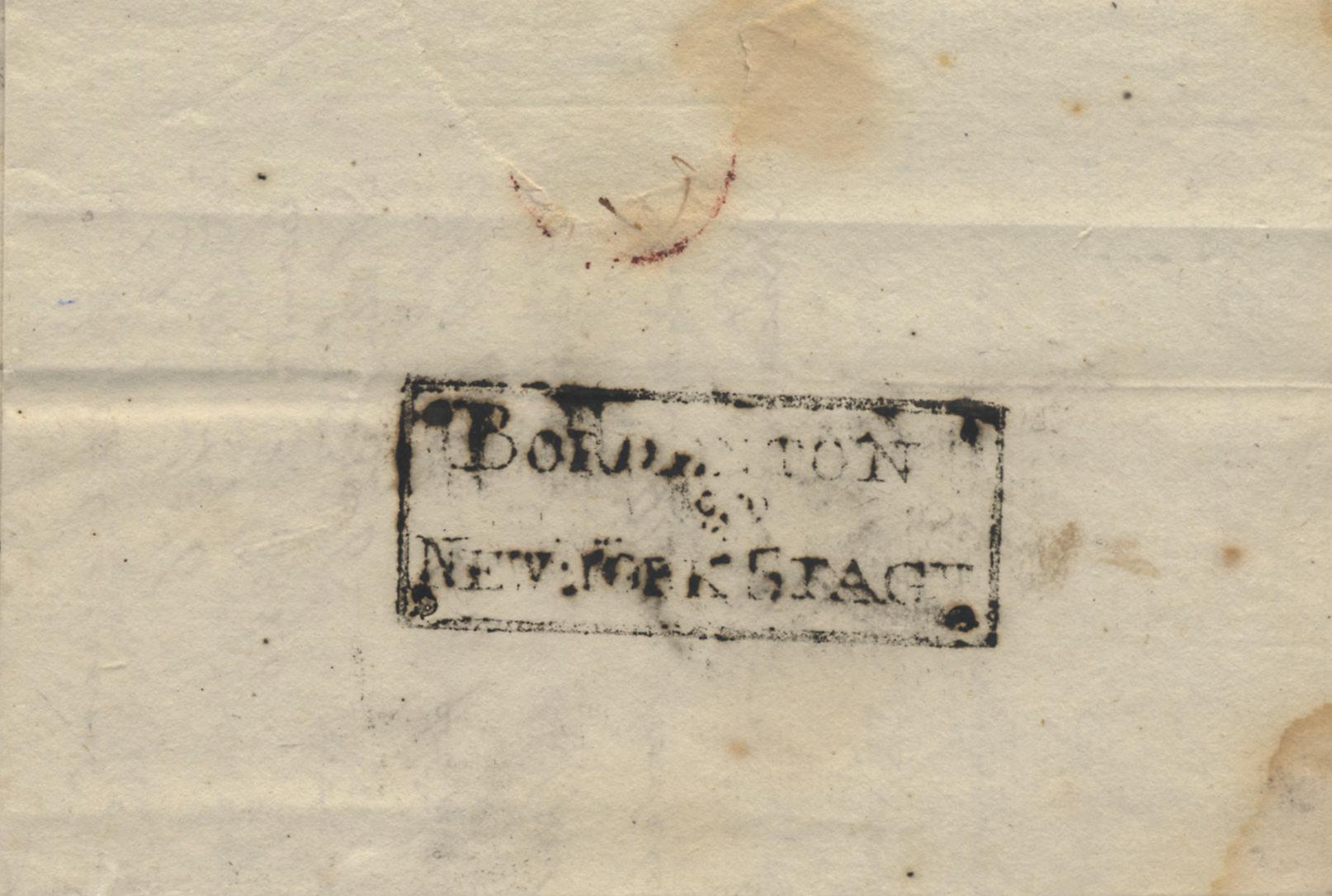
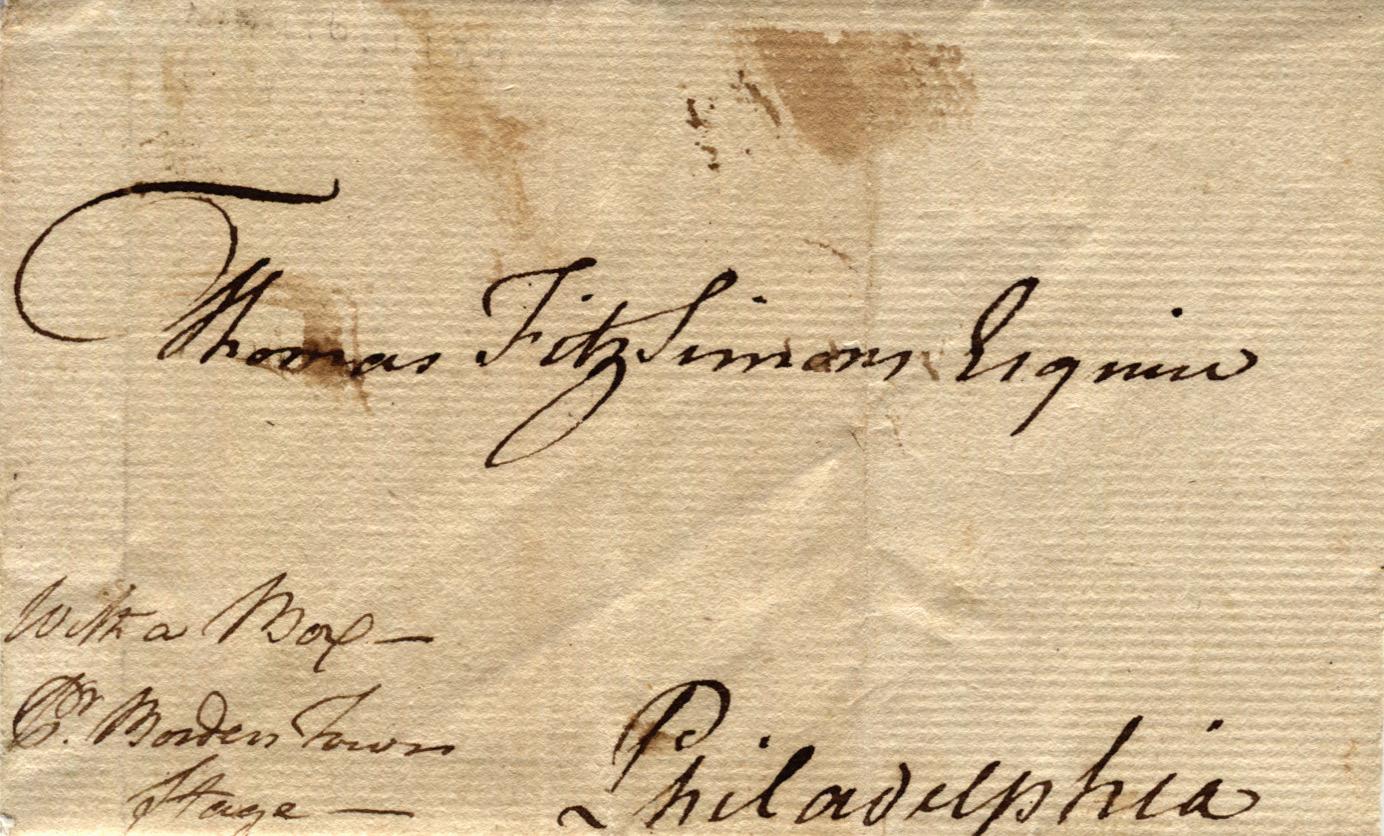
Figure 8 letter was dropped off. The stage then continued to Perth Amboy (by land), and was then ferried to Lower Manhattan.
The two stage lines providing the most competition for the Bordentown stage were the Trenton-Brunswick stage and the Burlington stage, both which operated rival stage boat legs of their journeys. The Trenton-Brunswick line operated a stage wagon from Brunswick to Trenton Ferry, where the stage was placed on a barge to Philadelphia. The Burlington line operated between New York and Philadelphia, covering the same route as the Bordentown line, but substituting Burlington for Bordentown as its main hub.
Figure 9. This folded letter, and others like it, demonstrate why some collectors and students experience frustration collecting and studying eastern stage mail. More often than not, it is impossible to tell the specific route traveled by a cover.
It is not always possible to tell if a cover was carried by the Bordentown stage or by one of these two rivals, specifically, if it was carried by the Burlington line. The Figure 9 letter is an example of the problem.
This letter might have been carried on the Burlington Stage, or perhaps on the Bordentown stage. The Burlington stage line and the Bordentown & New York stage line competed over the same route on their journeys to lower Manhattan. It is impossible to tell which line carried this folded letter because of the absence of some indicating notation on the cover or within its content.
While most of the Wm. Smith correspondence indicates letters were carried by the Bordentown Stage, there is one cover (dated April 6, 1788), written in the same hand as the balance of the Smith correspondence, that was carried from Philadelphia to Hidestown, but is endorsed “per Burlington Stage.” Other letters are endorsed “per Bordentown stage” or some variation of that phrase. Both stage lines fiercely competed over the same route known as the Lower Road.
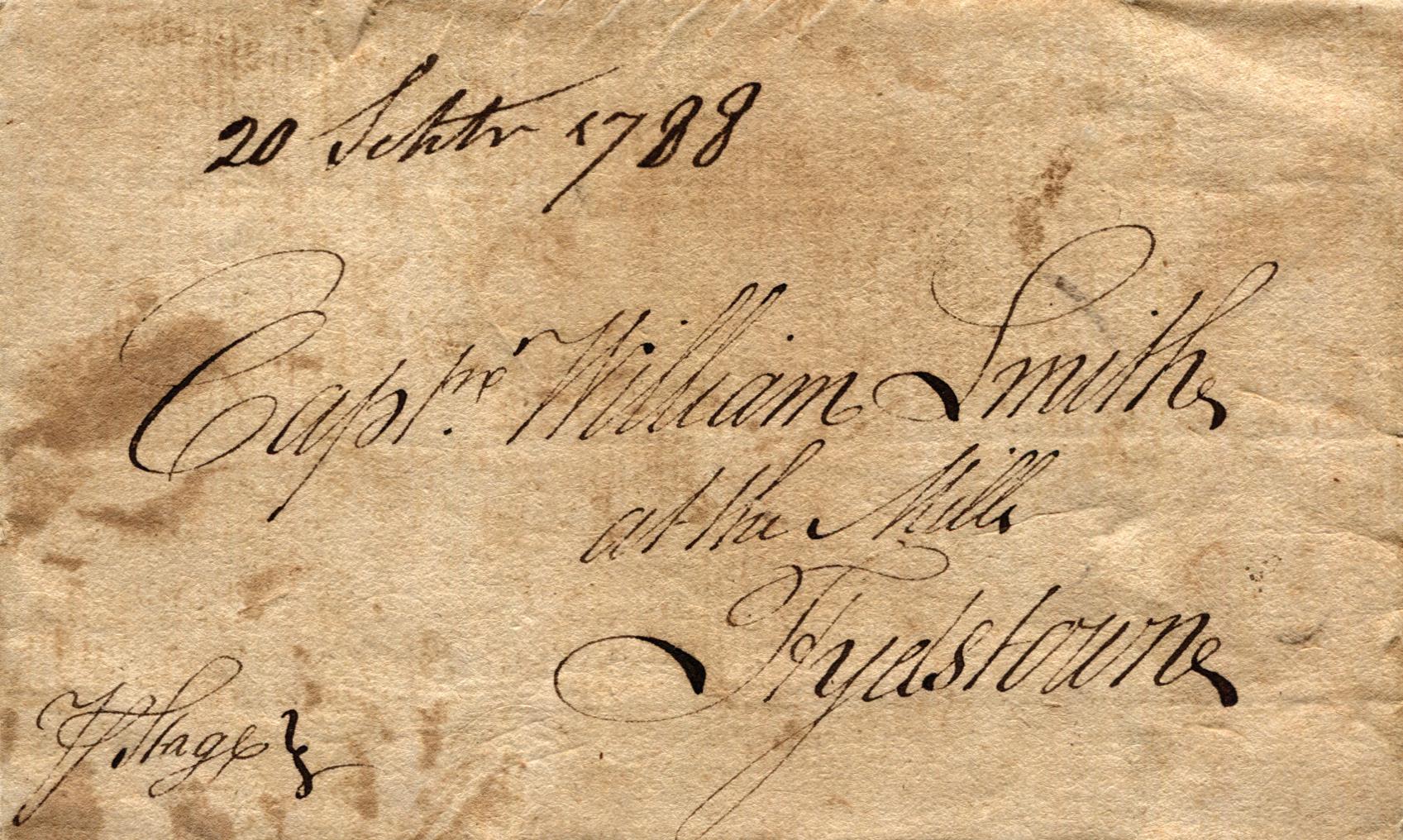
Without knowing which stage line carried the Figure 9 letter, it is impossible to know which route it traveled. The two possible routes were:
174 www.collectorsclub.org May-June 2022
Alternate Route 1: Philadelphia → Delaware River (Bordentown stage boat) → Bordentown → Walnford → Crosswicks → Hidestown
Alternate Route 2: Philadelphia → Delaware River (Burlington stage boat) → Burlington → Walnford → Crosswicks → Hidestown.
This problem arises, too, in stage-line advertising. In a 1797 advertisement, the stage line between New York and Philadelphia was described as a “Federal Line,” nothing more (Figure 10). Was this a reference to the Bordentown stage or the Burlington stage, or even a reference to some other stage line, such as a Contract-Stage line? This question remains unanswered.
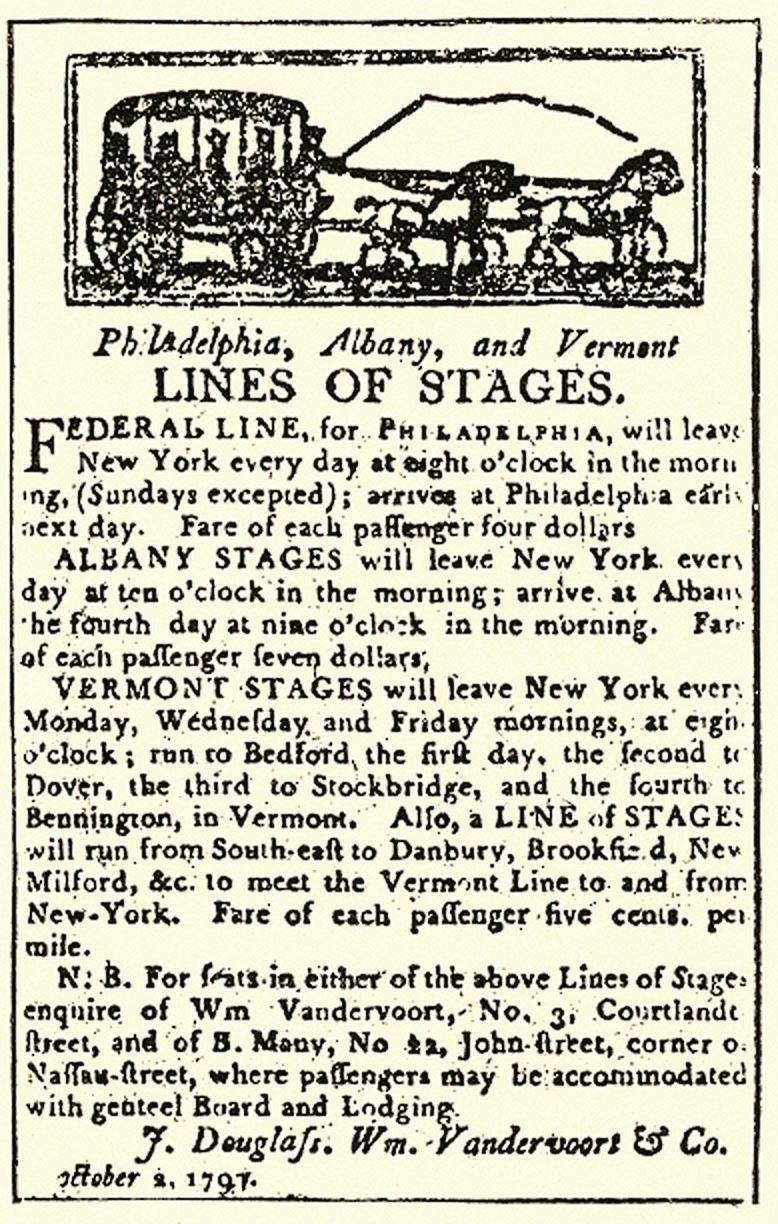
Bridgeton Stage
In their paragraph under Bridgeton, Cushing and Sheppard stated,
“STAGES – The first stage of which there is any account was run by Mr. Haskel who lived in Upper Hopewell, near the present Cohansey post-office. It ran from Greenwich through Roadstown and Cohansey Corners (now Shiloh), by Mr. Haskel’s house, to Cooper’s Ferry, as Camden was then called, and was in operation as early as 1771. Soon after the War of Independence a stage ran from Bridgeton to Philadelphia, by way of Roadstown, making two trips a week, which was afterwards changed to one trip that way and one by Deerfield. About 1806 or 1807 it went up one day and down the next, and in 1809 another line was started, which went up on the days the first line came down. These were afterwards united, and a daily stage was ever after run until West Jersey Railroad was opened in 1861.” 162
Figure 10. Based on the author’s research, to his knowledge there was no stage line known as the Federal Line. It is likely that this phrase was a shorthand statement indicating that the referenced stage line had a federal contract to carry the mail.
A rival stage line in opposition to Mr. Haskel’s stage did spring up, which made connections at Cohansey Bridge and then proceeded to Cape Island.73 Unlike Haskel’s stage line, this opposition stage appears to have been a local line only.
Staging in Bridgetown continued at least into 1841. I have a folded cover in my holdings that contains the following in its letter: “You had better forward papers by mail, a new district order having prohibited the stage drivers from carrying any letters sealed.”74
I have not recorded any covers carried on either previously described stage line. To be continued...
Collectors Club Philatelist
175 Volume 101, Number 3
Endnotes to Part
I
1 © 2013, 2022, Steven M. Roth, All rights reserved.
2 This article appeared previously in abbreviated form and content in NJPH, Vol.41, Nos. 1 & 2 (February and May 2013). This article reflects additional research and content development.
3 For an excellent overview of eastern staging, see, Holmes, Oliver W. & Rohrbach, Peter T., stagecoach east / Stagecoach Days In The East From The Colonial Period To The Civil War (Smithsonian Institution, Washington, D.C. 1983).
4 The earliest reported contract for a railroad to carry the mail, for example, was in 1835.
5 White, F., Philadelphia Directory (Philadelphia 1785), page 97.
6 Ibid., page 97.
7 Hardie, J., The Philadelphia Directory And Register, 1793, page 214.
8 Robinson, J., The Philadelphia Directory For 1805 (Philadelphia 1805), pages lxiv and lxv.
9 Robinson, J., The Philadelphia Directory For 1810 (Philadelphia 1810), unnumbered.
10 Act March 2, 1827, Section 19.
11 The first postal act to allow a Way fee to the post rider or stage driver was the Act of 1799. The Confederation statutes did not make provision for the payment of Way fees.
12 Philadelphia City Directory, 1787, page 97.
13 Act March 2, 1827, Section 19.
14 Holmes and Rohrbach, ibid., pp. 124-130.
15 Act of Feb. 20, 1792, Section 21; Act of May 8, 1794, Section 21; Act of 1810, Section 26.
16 Act of Feb. 20, 1792, Sections 21 & 22.
17 Act of 1792, Section 22.
18 Act of 1794, Section 22.
19 Regulations to be observed by the deputy postmasters in the united states, June 30, 1794, Section 27.
20 Regulations, 1794, Ibid.
21 American State Papers, Post Office Department, Class VII (Compiled 1833), page 21.
22 Patterson, Laws Of The State Of New Jersey (Newark 1800), page 451.
23 Ibid., page 451.
24 Journal Kept By Hugh Finlay 1773-1774, (Reprint Edition 1975), page 18.
25 Journals Of The Continental Congress (Washington 1904-37), pp. XXIII, 673.
26 Holmes and Rohrbach, page 24.
27 Ibid., page 24.
28 Ibid., LXI, fol. 263-265; Letter, Hazard to Alexander Hamilton, Aug. 1, 1786, ibid., fol. 272.
29 Hazard to Hamilton, ibid.; Hamilton to Hazard, ibid., fol. 271-273.
30 Ibid. Fol. 271-273.
31 Journals Of The Continental Congress, XXXI, 922-923.
32 Ibid., page 929.
33 For example, see, advertisements of the New Line of Stages in New York Journal, March 1 and April 17, 1788.
34 Quoted in Rich, W., The History Of The United States Post Office To The Year 1829 (Cambridge 1924), page 65.
35 Ibid., page 65.
36 Act of May 8, 1794, Section 2.
37 Lane, W., From Indian Trail To Iron Horse (Princeton 1939), pp. 50-51.
38 W.A. Whitehead, East Jersey Under The Proprietary Governments (1875), pp. 235-237, 419.
39 N.J. Archives, First Series, pp. III, 187.
40 Ibid., page 187.
41 Ibid., page 187.
42 N.J. Archives, First Series, pp. III, 176, 186-188, 250-251, 327; N.J. Archives, First Series, pp. IV, 129.
43 N.J. Archives, First Series, pp. XI, 162.
44 Ibid., pp. XI, 521.
45 Ibid. page 521.
46 N.J. Archives, First Series, pp. XII, 22, 29 and 94; N.J. Archives, First Series, pp. XIV, 654.
47 N.J. Archives, First Series, pp. XII, 681.
48 N.J. Archives, First Series, pp. IX, 86.
49 Ibid., page 86.
50 Ibid., page 86.
176 www.collectorsclub.org May-June 2022
51 N.J. Archives, First Series, pp. XX, 116; Pennsylvania Journal, June 16, 1757.
52 Ibid., page 116.
53 Pennsylvania Journal, June 16, 1857.
54 New York Weekly Post Boy, Jan. 8, 1758.
55 N.J. Archives, First Series, pp. XXVII, 137 and XXVIII, 286.
56 N.J. Archives, First Series, pp. XXVII, 477, 550; XXVIII, 92, 481, 466; XXIX, 186, 467; and XXXI, 11 and 46.
57 New York Journal and Weekly Register, Jan. 7, 1790, and Jan. 3, 1791.
58
N.J. Archives, First Series, pp. XXVI, 500, 513 and 545.
59 Philadelphia Gazette, Dec. 3, 1767.
60 Philadelphia Journal, April 11, 1771.
61 Ibid., Sept. 12, 1771.
62 Philadelphia Gazette, Aug. 19, 1772.
63 New Jersey Gazette, Nov. 25, 1778.
64 Pennsylvania Gazette, Feb. 17, 1779.
65
Advertisements of William Rider and John De Grove in New Jersey Journal (Chatham, N.J.), June 14, 1780.
66 Drake for many years was the keeper of the Indian Queen Inn at Brunswick and the proprietor of the ferry there that crossed the Raritan River.
67 New Jersey Journal, Oct. 11, 1780.
68 New Jersey Gazette, Oct. 4 and Oct. 28, 1780.
69 This stage line is referred to on its 1786 handstamp as the Bordenton & New York Stage, even though the town founded by Joseph Borden was known as Bordentown.
70 NJPH, Vol. 33, No.4 (Nov. 2005), page 181, n.10.
71 NJPH, Vol. 39, No.1 (Feb.2011), page 4, n.2.
72 The POD had entered into contracts with individual stage lines prior to 1786, but never on a geographic basis as it did in 1786.
73 Pennsylvania Packet, April 13, 1772.
74 Cover dated July 11, 1841, Bridgeton to Philadelphia, S.M. Roth collection.
In addition to face-to-face meetings that are now being held, all Collectors Club presentations are also held online, via ZOOM, beginning at 5:30 p.m. (Eastern).

Although there is no cost, pre-registration is necessary.

Noted in Passing on the Auction Block
Matthew HealeyNotable items featured here are from recent auctions that were advertised in the Collectors Club Philatelist. Members who do business with these firms should be sure to thank them for their support of the CCP. If you have spotted – or personally bought or sold – an item you feel is worthy of inclusion in the next round-up, no matter the price, please drop a note to secretary@collectorsclub.org
Eastern Auctions Ltd., Bathurst, N.B.: The Auchenbraith Collection of Canadian federal and provincial revenues, Mar. 26, 2022, Lot 1045. Further details at easternauctions.com
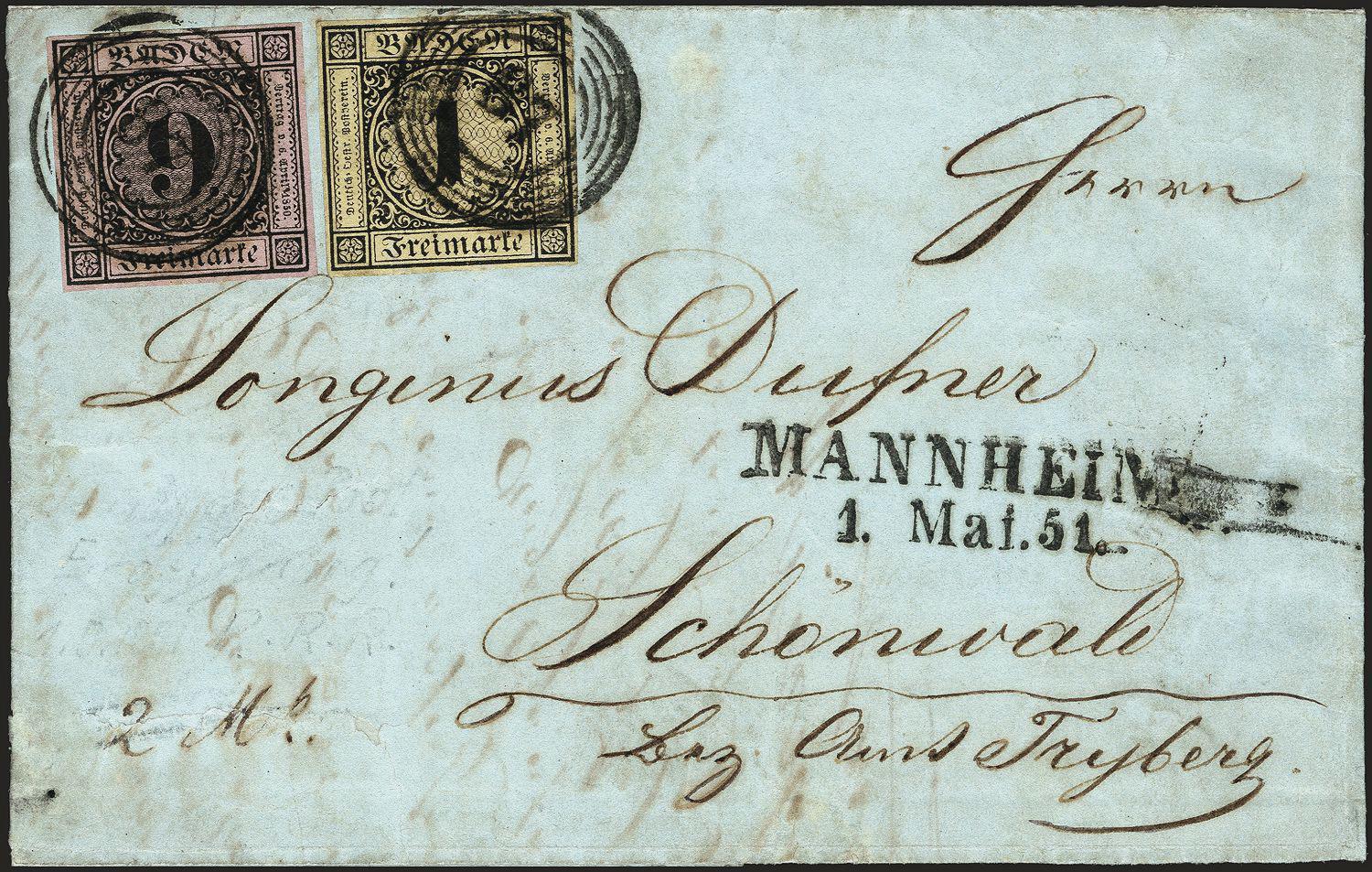
Canadian court-fee revenue stamps feature some of the most breathtakingly beautiful engravings anywhere, thanks to their large size and combination of intricate machine-turned backgrounds and exquisite portraiture. The 1916 legal document shown above bears five stamps totaling $2.45, each handstamped with the words “In Prize” twice, in red and purple. The confluence of beauty, rarity and condition helped drive this exceptional result for a fiscal use. (Realization includes 18.5% buyer’s premium.)
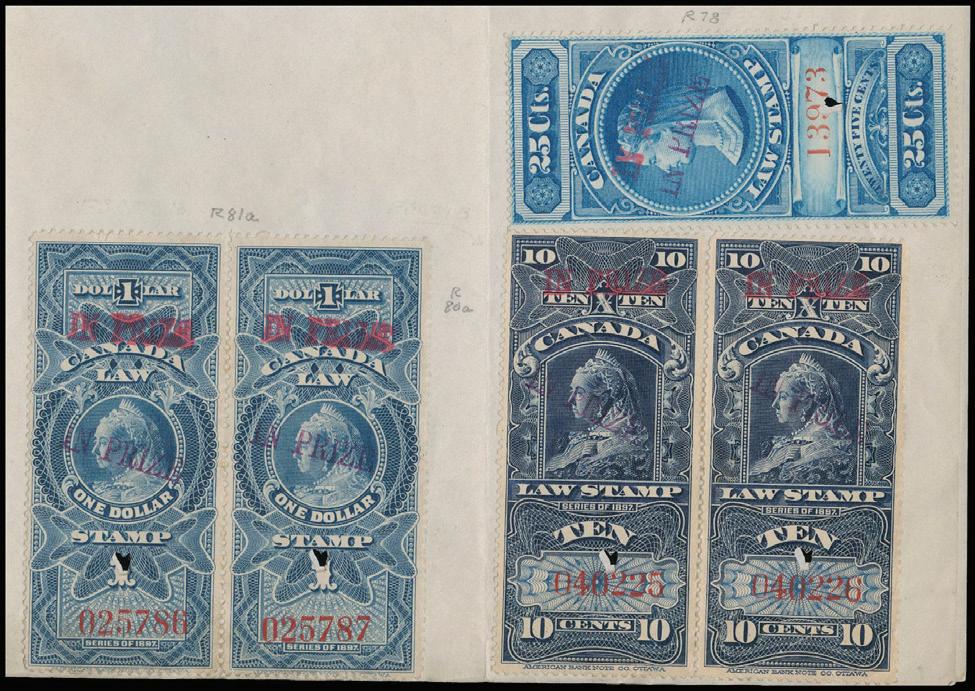
The ONLY known first-day cover for Baden no. 1
€254,100
Heinrich Köhler, Wiesbaden, Germany: The Erivan Collection of German States Part 7, March 26, Lot 3. Further details at heinrich-koehler.de
The German state of Baden issued its first four stamps on May 1, 1851. Only one example, shown at bottom of facing page, of the 1-kreuzer black on dark buff (a.k.a. “chamois”), listed everywhere as No. 1, is known on a first-day cover. This is it. This is also the only Baden first-issue FDC with a multicolor franking. Sent from Mannheim to a small town in the Black Forest, the 9kr black on lilac rose paid the 3rd-zone rate, while the 1kr, which ought to have been placed on the reverse, prepaid a delivery fee. A rare and important item of old German States postal history, ex Boker. (Realization includes 21% buyer’s premium.)
Siam 1 att on 2 atts Overprints on Cover to Germany
€18,570
Christoph Gärtner, Bietigheim-Bissingen, Germany: 52nd auction, March 7-11, Lot 4001. Further details at auktionen-gaertner.de
Thailand’s second issue of 1887-91, depicting King Chulalongkorn, received a multitude of handstamped provisional surcharges that can be a challenge to identify and value correctly. Sometimes, it’s wisest to let the market decide. The unassuming 1890 commercial cover shown above was mailed unsealed at the printed matter rate (the endorsement “Registered” was crossed out) from Bangkok to a druggist in Germany, bearing two vertical pairs of overprinted 1a-on-2a stamps, described as “scarce on cover.” It opened at €400 and was hammered down for €15,000 – must be scarce indeed! (Realization includes 23.8% buyer’s premium.)
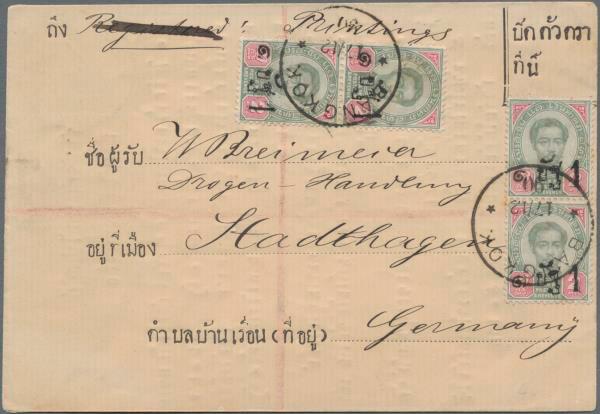
Clio Catches a break: the $6 Newspapers special printing $50,150
Robert A. Siegel Auction Galleries, New York: The Hope Collection of U.S. Newspapers and Periodicals issues, March 1, lot 73. Further details at siegelauctions.com
Only 14 examples were sold of the 1875 Special Printing of the $6 newspapers and periodicals stamp, Scott PR50, and only half of those are accounted for in Siegel’s census. The U.S. newspaper stamps present collectors with a bit of a dilemma, being beautiful and romantic on the one hand and often prohibitively hard-to-get on the other. The $6 design is among the most charming and perplexing: the Greek Muse Clio poses nonchalantly, seeming to dangle a cigarette while she reads something on her tablet. (Realization includes 18% buyer’s premium.)
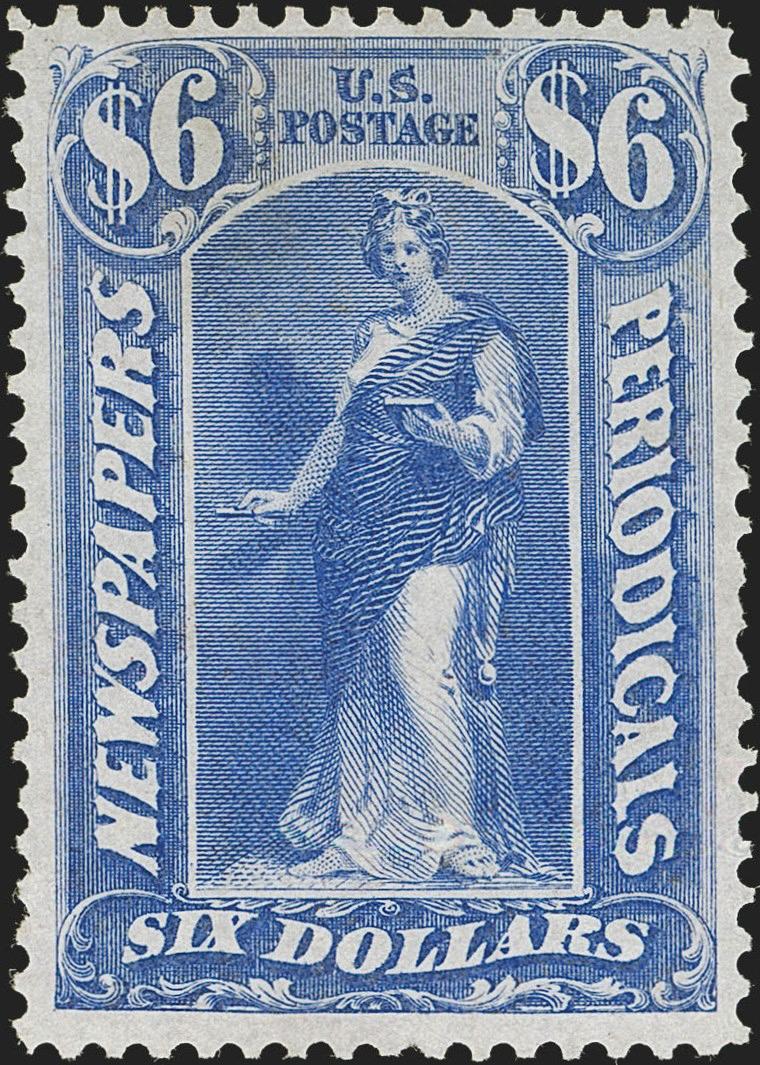
Mint Sheet of 1919 Toronto-New York First Flight Semi-Officials C$9,360
Sparks, Ottawa: The Red Baron Collection of Canada semi-official air mail stamps, Feb. 26, Lot 371. Further details at sparks-auctions.com
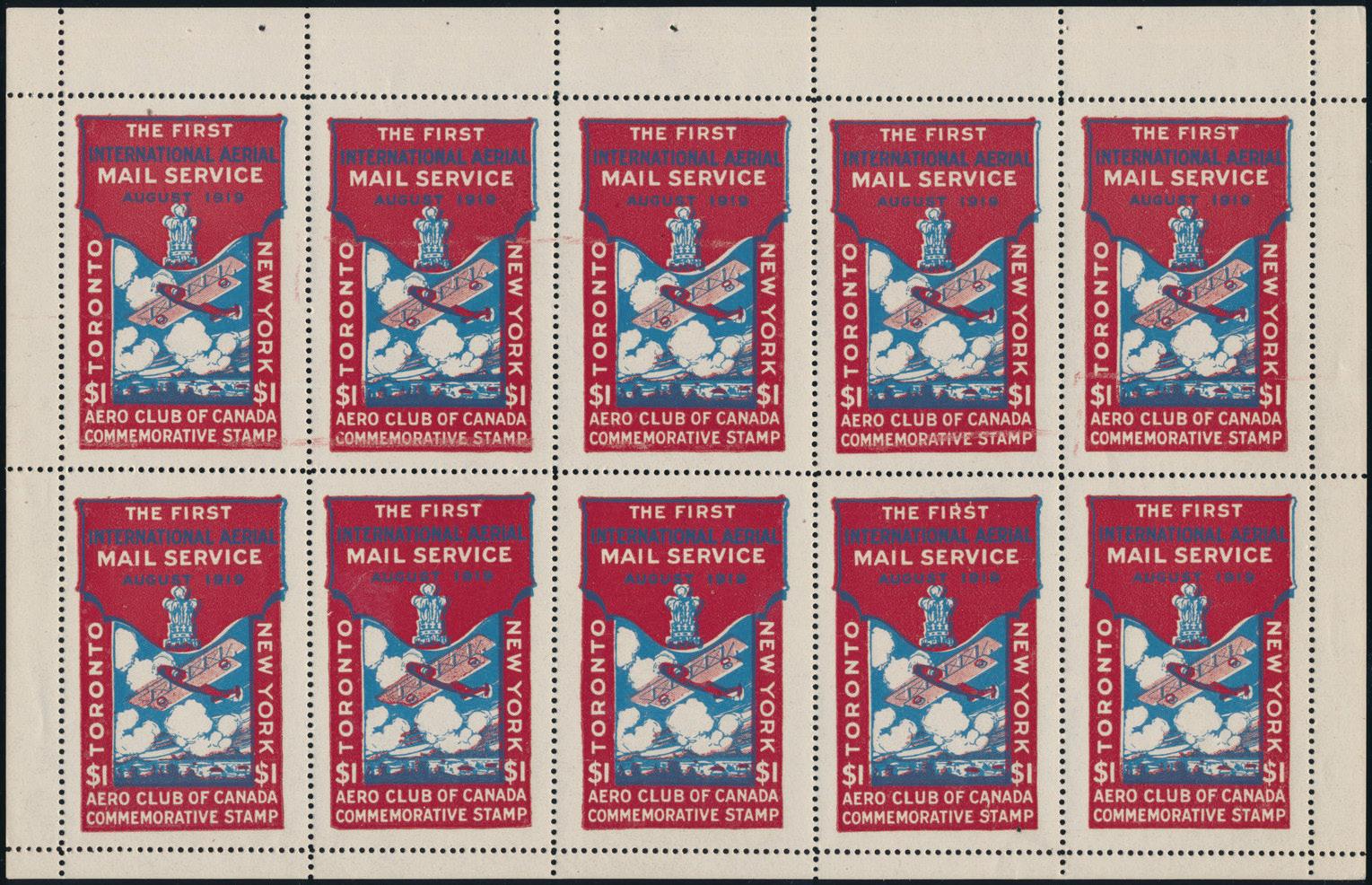
Canada’s vast distances and shortage of good highways made it a logical
180 www.collectorsclub.org May-June 2022
place for airmail pioneers to try and establish services. As early as 1912, air clubs and private start-ups issued officially sanctioned stamps to pay aerial surcharges. The bold red-white-and-blue design of this $1 issue, prepared by the Aero Club of Canada for the start of Toronto-New York air service in 1919, makes it one of the most popular. Only three mint sheets survive; it is not known how many are never-hinged like this one. (Realization includes 17% buyer’s premium.)
When Denver was in Kansas… $11,210
H.R. Harmer/GPN, New York: Boulder Collection of Colorado postal history, Feb. 23-24, Lot 25. Further details at hrharmer.com
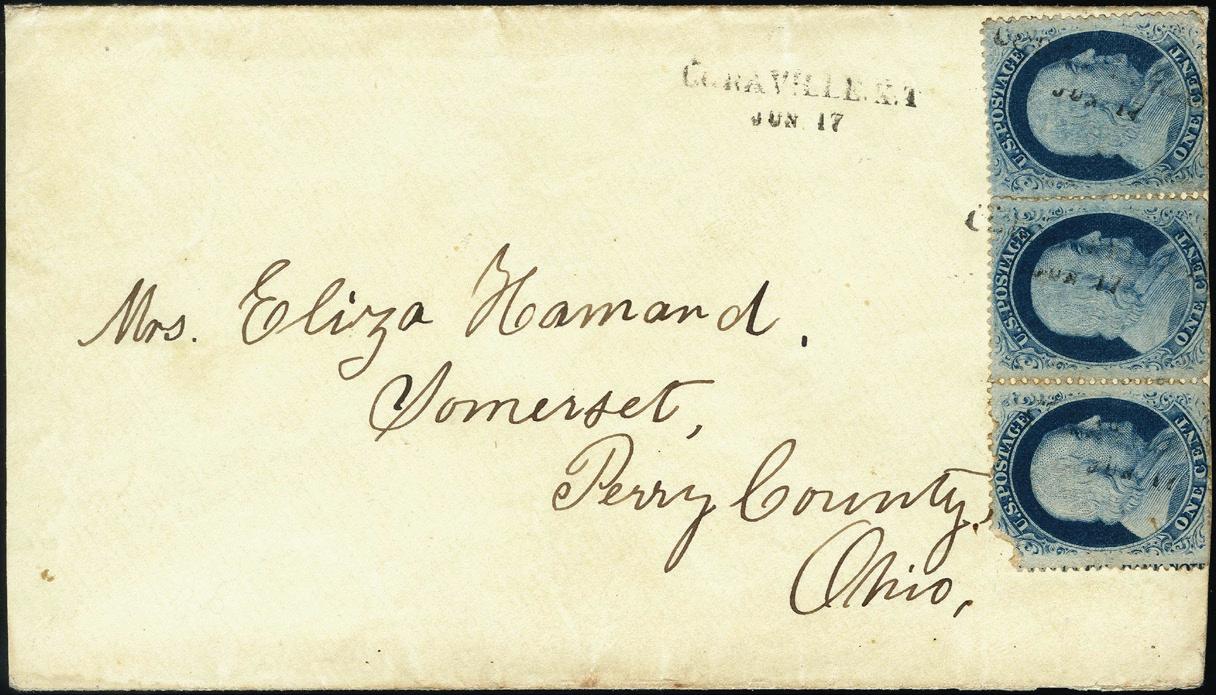
Don’t try to find Coraville on a map, and certainly don’t go looking for it in Kansas. Coraville was never a place name, just the name of a small but important frontier post office in what would grow to become Denver. In the 1850s, that was still part of Kansas Territory, and this cover is one of just a handful to survive from this early gold-prospecting community. Franked with three 1857 1¢ stamps and carried eastbound on the Platte River Road to Ohio, it is considered one of the outstanding covers of Colorado postal history. (Realization includes 18% buyer’s premium.)
The Famous “Bradford” Cover from the U.S. Agency in Shanghai $165,200
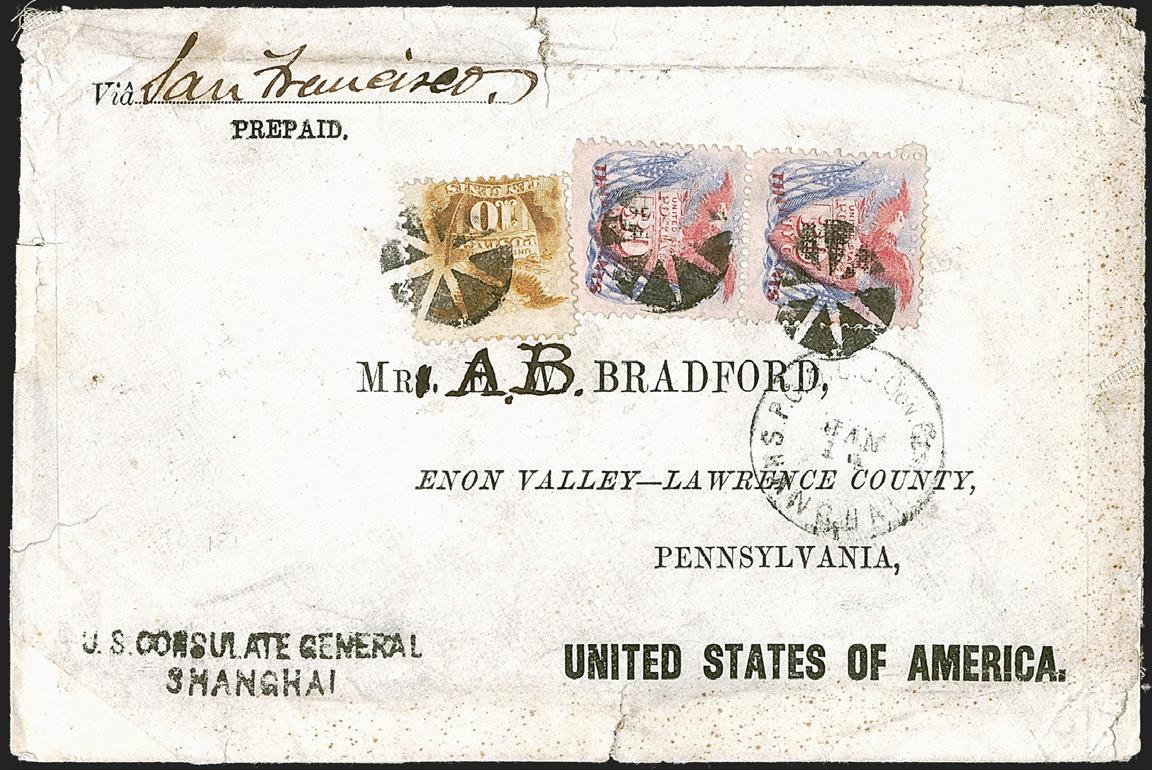
Collectors Club Philatelist
181 Volume 101, Number 3
Robert A. Siegel Auction Galleries, New York: The Magnolia collection of U.S. Mail in China and Japan Part 1, Dec. 16, Lot 2051. Further details at siegelauctions.com
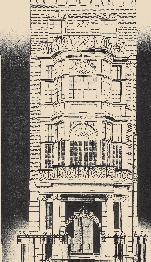
The late doyen of United States postal history, Calvet Hahn, described this cover as “magnificent and unique;” it may be the most important item of 1869 pictorial issue postal history extant. Mailed from China to Pennsylvania in 1871, franked with a pair of 30¢ ultramarine-and-carmine Eagle and Flags stamps and a 10¢ yellow of the same design, it was sent from the U.S. Postal Agency in Shanghai via Yokohama, across the Pacific to San Francisco and then overland on the still-newish transcontinental railroad. It is one of just four known 1869 30¢ covers to originate in China, and the CDS, which reads “P.O.D. U.S. Con. Genl. Shanghai,” is extremely rare. Ex Ishikawa and others. (Realization includes 18% buyer’s premium.)
Mr. Jefferson’s Free Frank $7,670 H.R. Harmer/GPN, New York: United States and worldwide stamps and covers, Dec. 14-15, Lot 3286. Further details at hrharmer.com
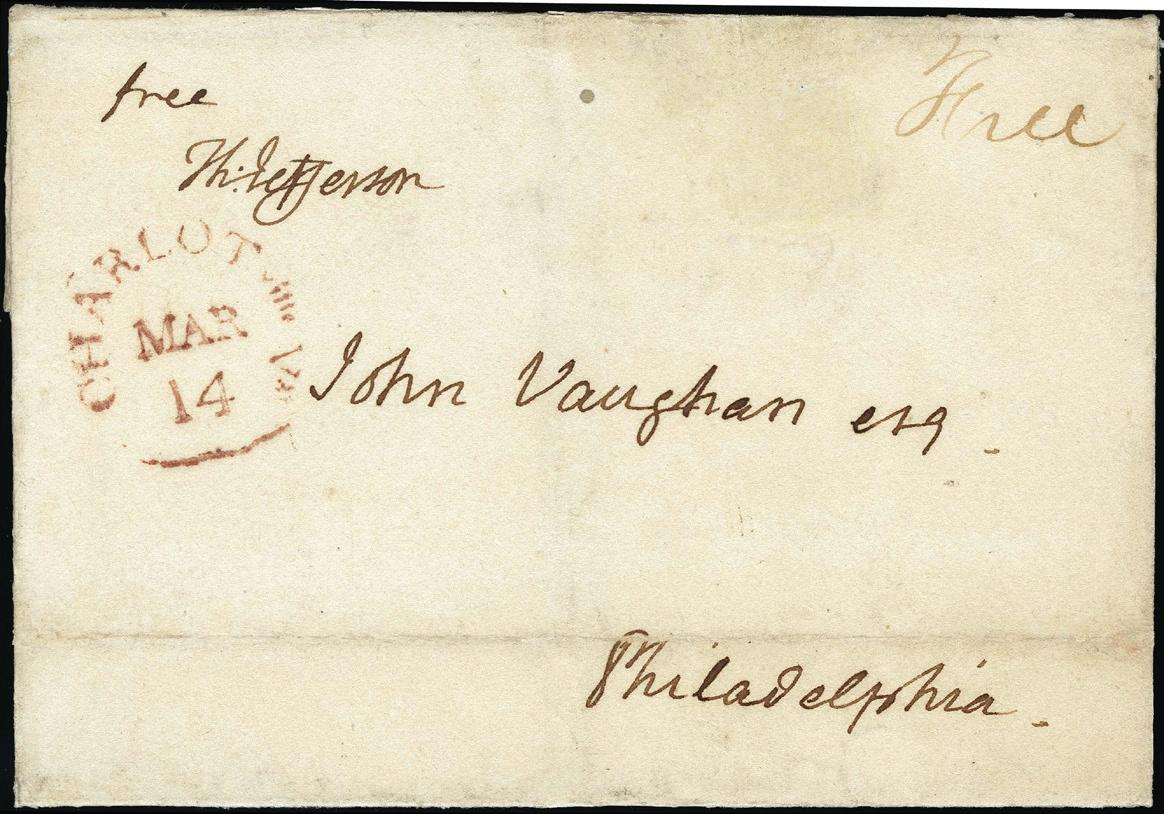
As the former third President of the United States, Mr. Jefferson retained the right to use the postal system free of charge for the rest of his life. This folded lettersheet, sent on Mar. 14, 1820, is datelined at his estate, Monticello, and crisply postmarked in nearby “Charlot’ville Va.,” home of the college he founded (today the University of Virginia). The letter is endorsed in his hand “Free Th. Jefferson” with an additional “Free” in a different hand at upper right, and addressed to John Vaughan, a Philadelphia merchant and patron of the arts. (Realization includes 18% buyer’s premium.)
Keep up to date with what’s happening in your club: www.collectorsclub.org
www.collectorsclub.org
Persian invert/Part Imperforate errors on a unique piece
€20,740
David Feldman International Auctions, Geneva: Autumn Auction Series, Dec. 13-16, Lot 31309. Further details at davidfeldman.com
This 1880 parcel post waybill is franked with an extraordinary couple of singles of the 1879 1-kran brown-and-black issue, with inverted portrait of Shah Nasser ed-Din; in addition, both adhesives are imperforate on three sides. The two errors are tied by a CDS of Rescht (Rasht in modern-day Iran). The item is apparently unique. Although estimated at a modest €1,000, its realization exceeded that figure by more than 20 times. (Realization includes 22% buyer’s premium.)
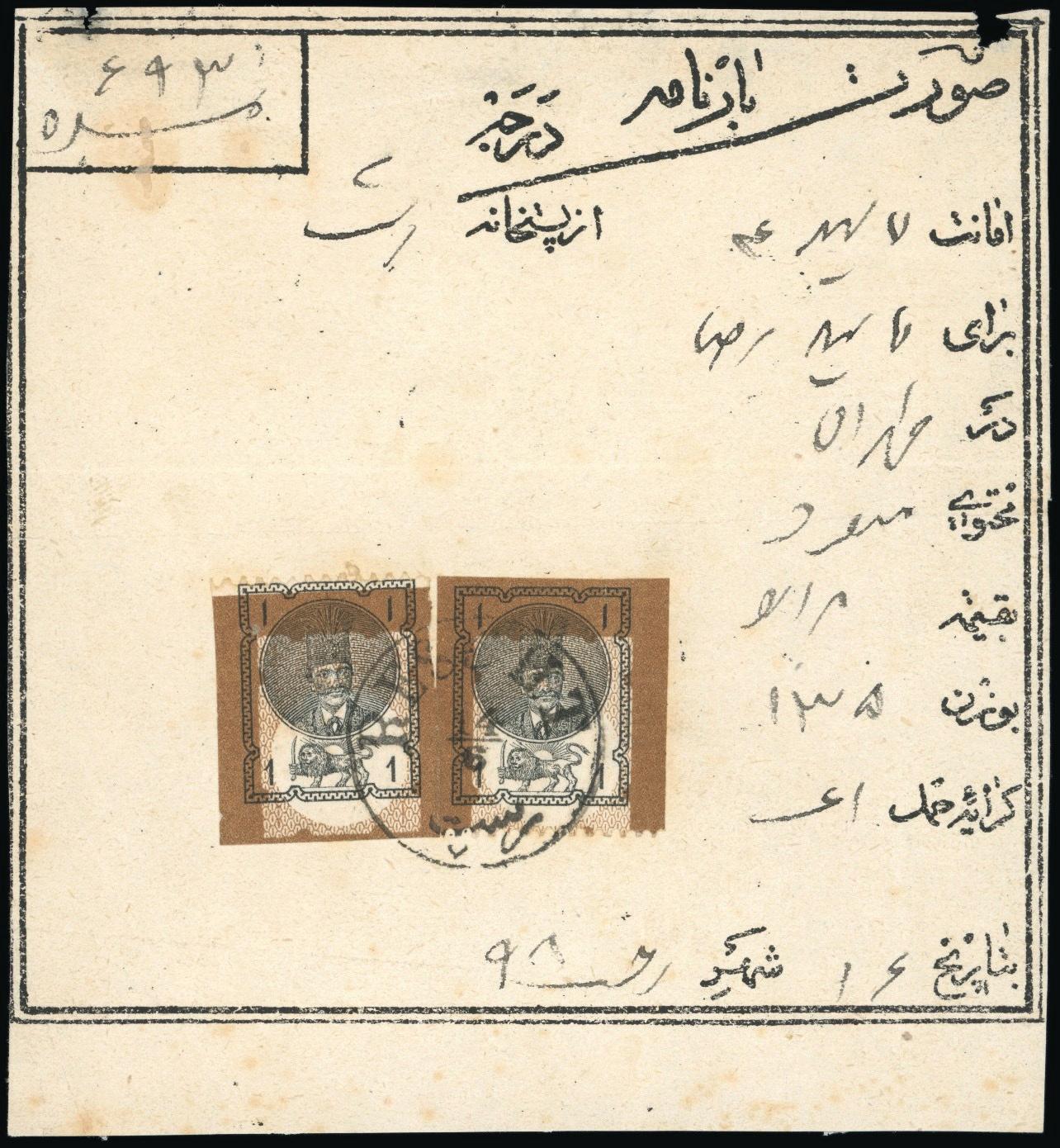
20¢ Washington-Franklin with plate number
$2,040
Golden Oak Online Auctions, Gordon, Tex.: U.S. Gem Series Sale, Dec. 11, Lot 119. Further details at goldenoakonlineauctions.com
In a sale offering numerous gem examples of otherwise readily obtainable 20th century United States stamps, this 20¢ Benjamin Franklin of 1916, unwatermarked, perf 10, stood out for its exceptional quality and stunning beauty. Graded XF-Superb 95, it boasts bright color and mint, never-hinged gum. (Realization includes 20% buyer’s premium.)
183 Volume 101, Number 3 Collectors Club Philatelist
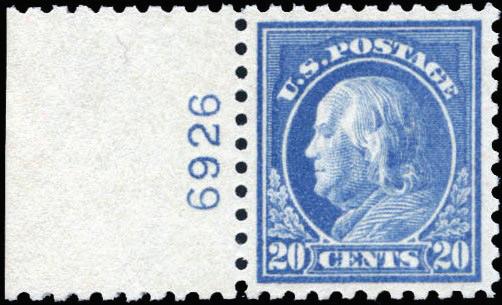
13¢ Hawaiian Missionary $25,300
Schuyler Rumsey Philatelic Auctions, San Francisco: The December Sale, Dec. 8-9, Lot 1043. Further details at rumseyauctions.com
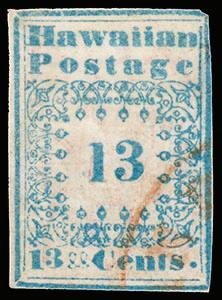
Unusually for one of these delicate and rare Hawaii “missionaries,” this example of the 1851 13¢ inscribed “Hawaiian Postage” is free of the typical restorations of missing portions of the design. Though it has a tiny, sealed tear and did once bear a magenta manuscript cancel that was cleaned in the past, its discreet orange-red CDS across the lower corner makes it a visually appealing and highly desirable example, offered as part of the Munson collection of Hawaii stamps and postal history. Ex Harris, Middendorf, Honolulu Advertiser and others. (Realization includes 15% buyer’s premium.)
Unique Hamburg-Havana Cover €32,400
Sellschopp Auktionen, Hamburg: 2nd Auction, Dec. 1, Lot 79. Further details at sellschopp-auktionen.de
This 1867 cover from the Murtfeld correspondence is franked with a pair of Hamburg 9-schilling yellow stamps and a 2s red of the 1864 perforated issue. The total of 20sch was equivalent to 15¼ silbergroschen, which fully prepaid the 1853 rate by Prussian closed mail via England and New York to Havana. The portion due the United States was noted in Aachen as 28¢, of which 23¢ was for transatlantic passage, while 5¢ was for onward carriage to Cuba, where a charge of 2 reales (blue boxed “NE2”) was raised for local delivery. This is the only known classic-era cover from Hamburg to Havana – all other Caribbean destinations are to Curacao or St. Thomas. Ex Burrus, where it was illustrated in color in the 1964 German States sale catalog. (Realization includes 20% buyer’s premium.)
184 www.collectorsclub.org May-June 2022
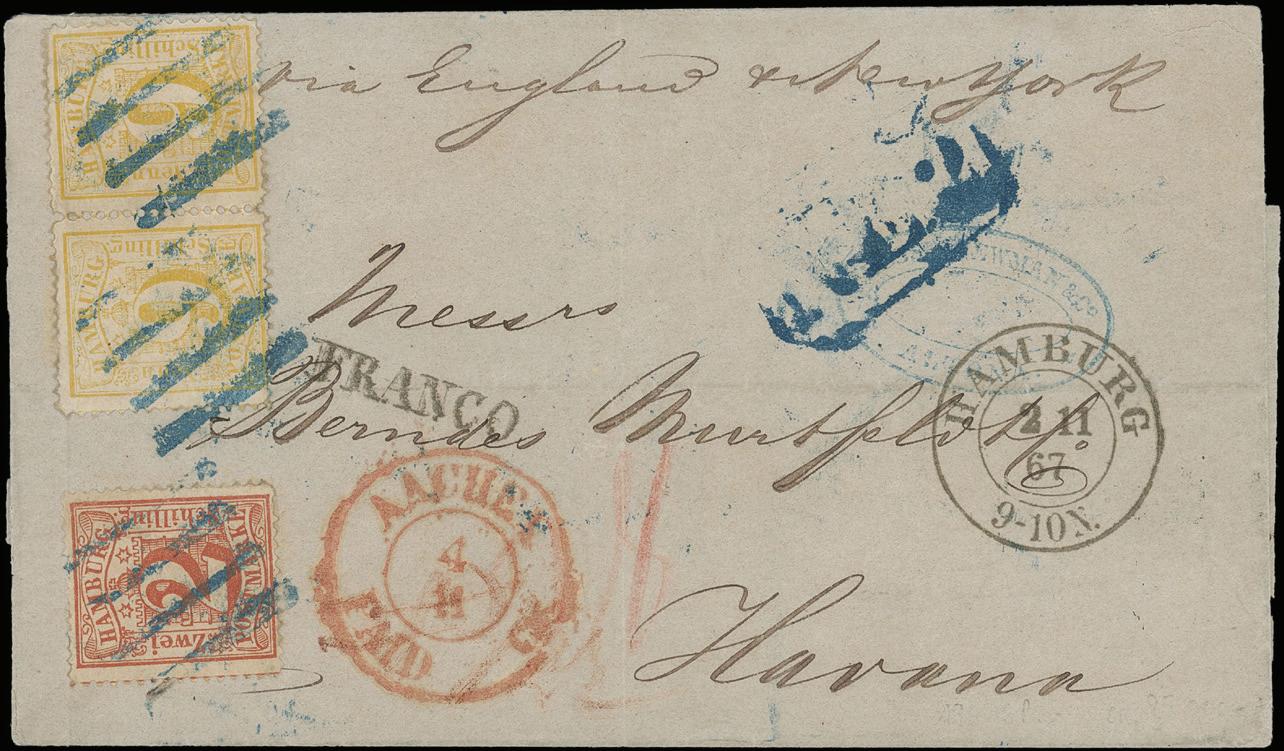
Daniel Cantor collection of Queen Victoria Canadian Leaf and Numeral stamps and postal history plus our important general fall sale with stamps, postal history, lots and collections.

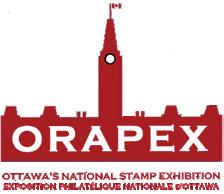

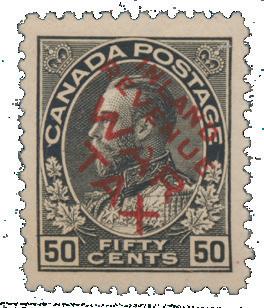
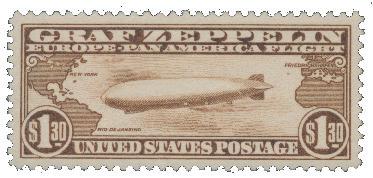
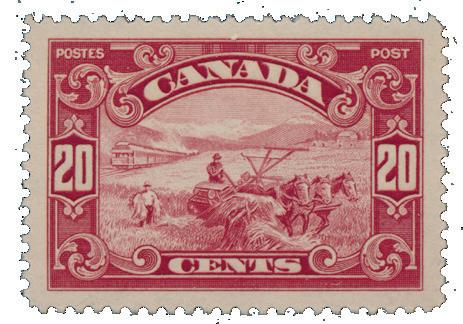
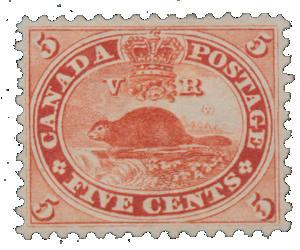
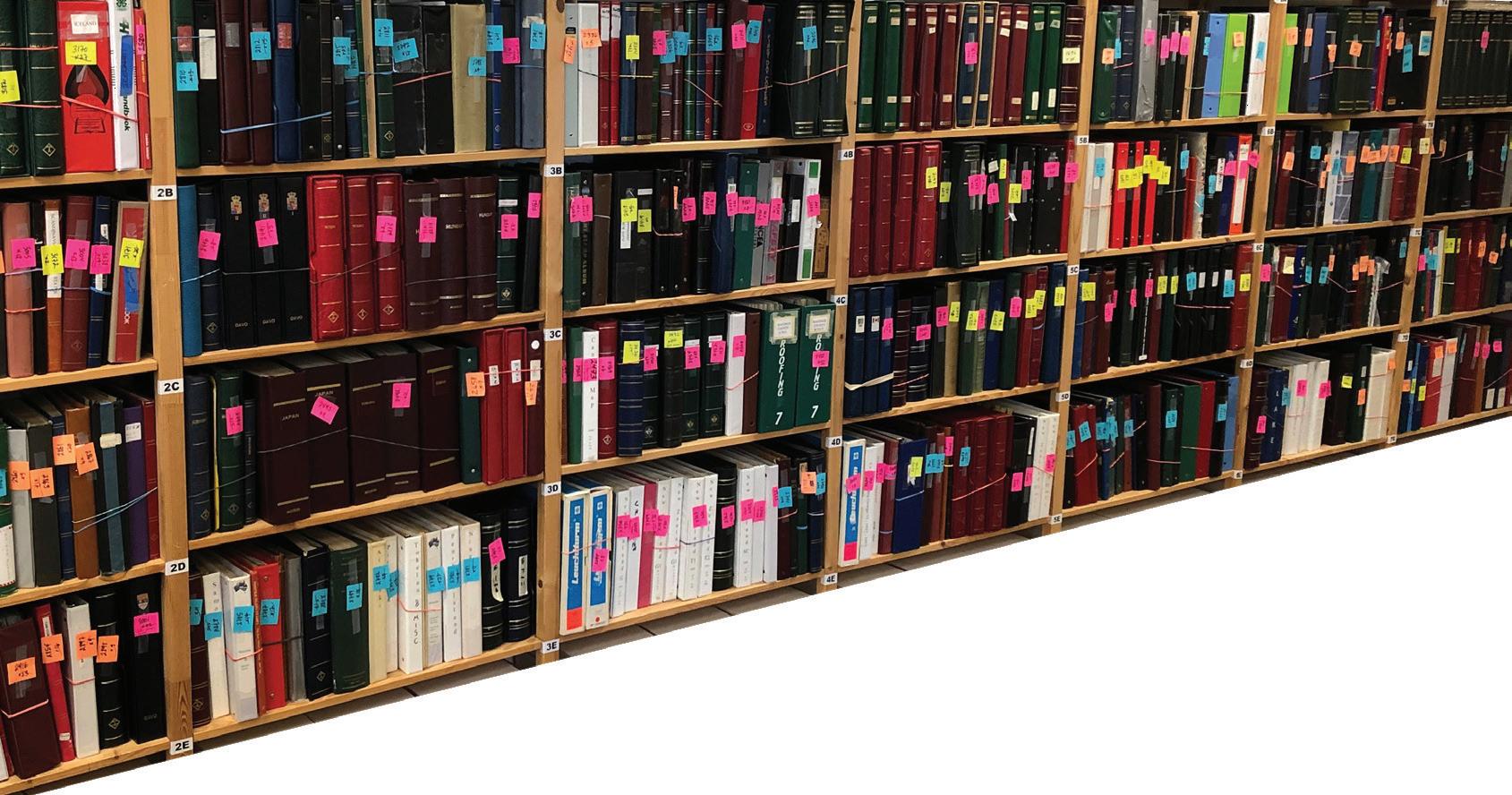

•
•
•
•
•
•
•
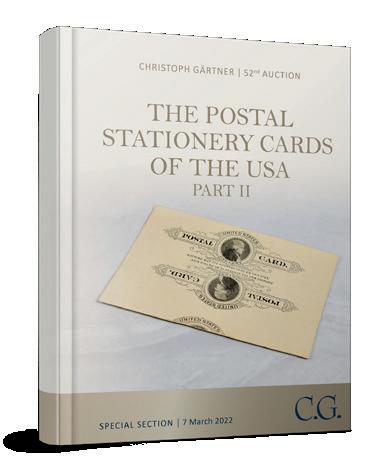
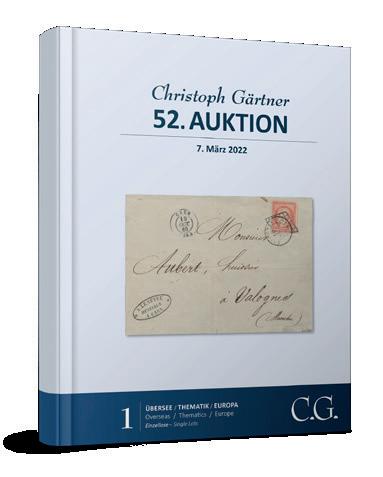
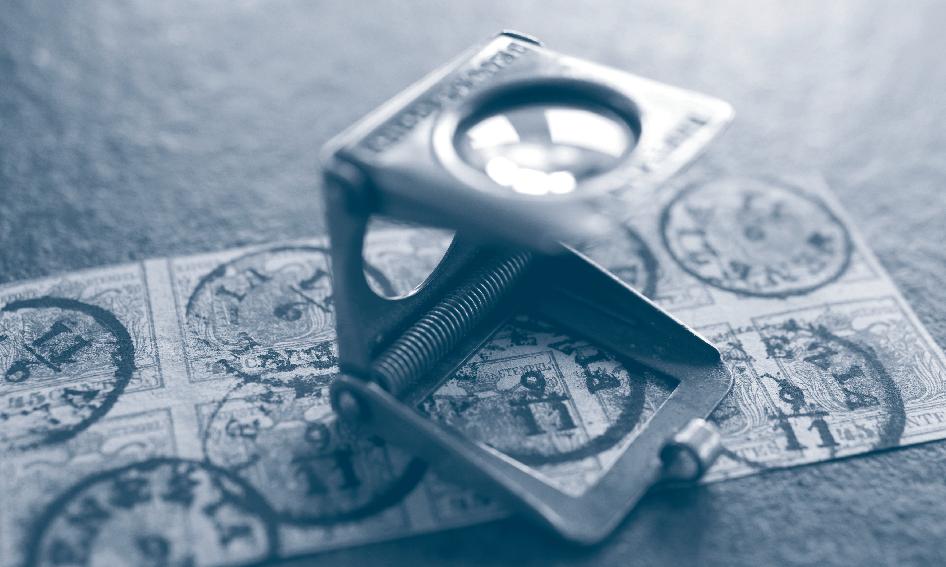
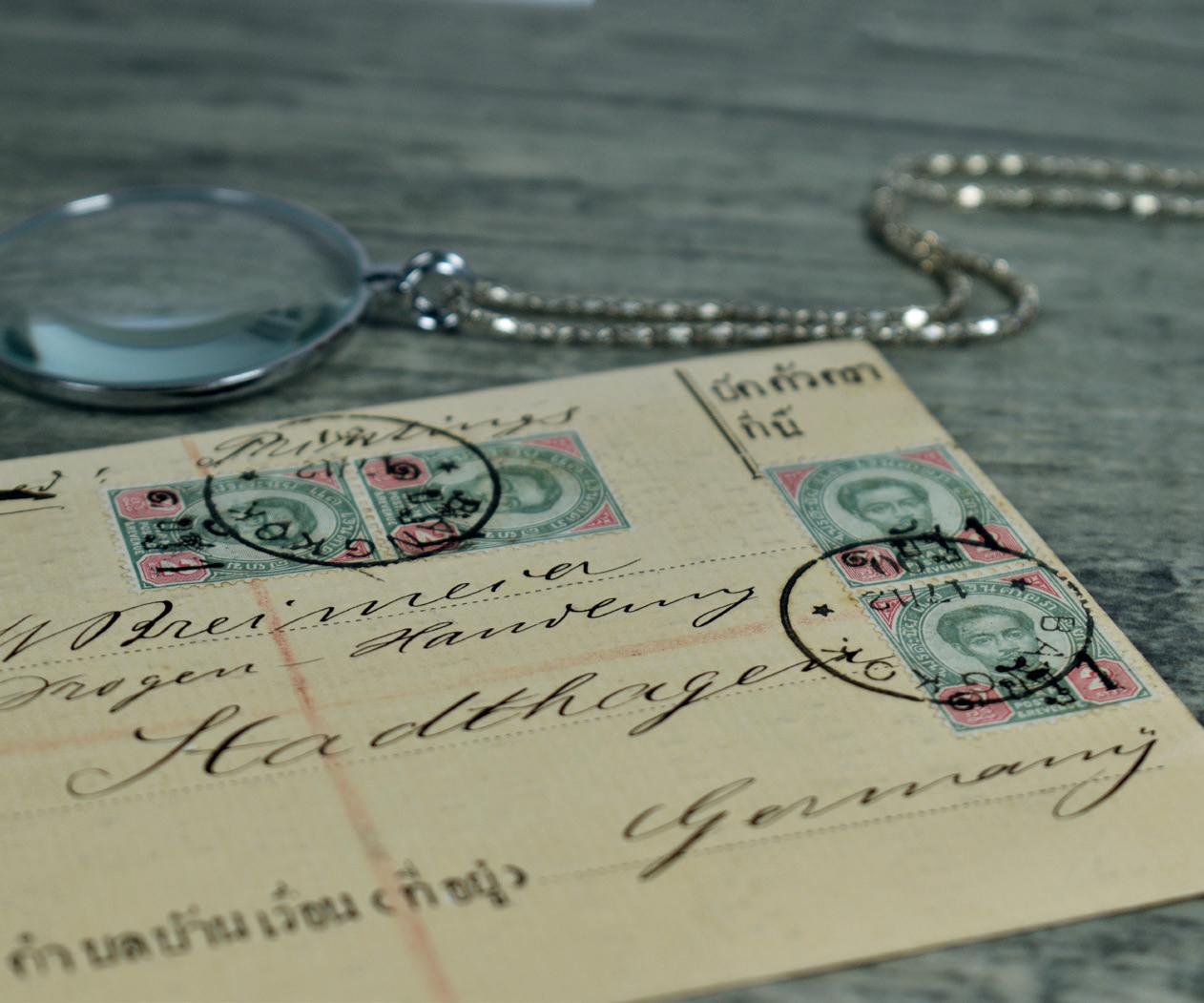
Irene Orysia (Zajac) Bromberg, Ph.D.

Nov. 14, 1948 – March 1, 2022
By Joan Harmer and friendsOfficers and governors of the Collectors Club come and go, but Irene Bromberg was the face and soul of the club for more than 22 years. There is hardly a person involved with the club who did not know Irene. She took care of all aspects of the club’s operations from the payment of dues to checking out a library book. She cared very deeply about club members as people and took a keen interest in their lives, their spouses and even their pets. Hers was the welcoming smile that greeted you when you entered the building, and the voice that you heard when you contacted the club by phone. She knew everyone, and everyone knew her. Irene’s knowledge about the building and the club were second only to that of David Steidley.
Irene loved 22 East 35 th Street, the former residence of Thomas Benedict Clarke. Clarke was one of the most prominent private collectors of Chinese porcelain, American paintings and antiquities. He hired the architectural firm of McKim, Mead & White to transform the brownstone building into the beautiful structure purchased by Alfred F. Lichtenstein and others as a permanent home for The Collector’s Club. Clarke’s project was overseen by the legendary Stanford White, which all but guaranteed the building its status as a New York City landmark. Irene discovered a replica of the Clubhouse building at the New York Botanical Garden’s miniature holiday train display. She sent everyone to the garden to view the little building. Irene could tell visitors about practically every item in the club. Indeed, the building was a second home for this talented and humble woman who brought a deep knowledge of art and antiquities to her work.
Irene took an interest in each member of the club. She learned his or her interests and background and used that knowledge to help them network. When
Irene could not answer a question, she knew someone who could help. She was a philatelic cupid who put like-minded collectors together for their mutual benefit. At parties, she would introduce new or rarely seen members to others. Irene paid particular attention to women and couples, making certain that novice female collectors could meet more experienced women philatelists. She helped others gain the confidence needed to have fun in the hobby.
While Irene knew all about us, few of us knew about her impressive cultural and academic history. She was born in Erlangen, Germany, to a Ukrainian-Polish family. They emigrated to the United States when she was two years old and stayed in the metropolitan New York area all her life. She attended the finest Roman Catholic schools and was the Valedictorian of her class at Cathedral High School. Club visitors would never guess that in addition to Old Slavonic, she was fluent in Ukrainian, Russian, French, German, Italian and, especially, Latin and Greek. When a club newbie would refer to Irene as “just the Secretary,” her friends would reply, “Oh, you mean Doctor Bromberg.” She was an incredibly brilliant woman who earned a doctorate from NYU in Ancient Greek. That is not an easy discipline to master, and there are few people who have read Homer in the original language. Her dissertation, titled A Commentary on Aeschines’ Contra Ctesiphontem sections 177-260, is available at www.proquest.com/openview/0a95cb 83f0789d7e595ea38efb404993/1?pq-origsite=gscholar&cbl=18750&diss=y .
While substituting for a professor in an elementary Greek class as a graduate student at NYU, Irene Zajac met an intelligent Navy veteran named Joel Bromberg. In short, it was love at first sight. Irene could get along with anyone, but she had had very high standards for “the one.” She and Joel would spend a lot of time in Madison Square Park. He proposed marriage, and she accepted. They were together for almost 50 years. Typical of Irene’s style, there was no lavish wedding, but just a simple civil ceremony at the Municipal Building on Aug. 24, 1973, followed by a scrumptious reception at the Gramercy Park Hotel.
Around 1994, Irene volunteered for Bob Mitchell’s Collectors Club Library Committee. She was instrumental in a multi-year project to list the library’s holdings in a computer database. She fell in love with the building and its people, so she applied for the post of executive secretary when Lisa Guggenheim Fahn vacated that position to move west with her husband. In September 1999, Thomas Mazza, the president of the Collector’s Club, made one of the best decisions in the club’s history: he hired Irene Bromberg.

Over the years, Irene made the position her own. She did everything from handling membership chores to writing and proofreading correspondence for many presidents. She organized many of the Lichtenstein Award Dinners and social gatherings, “manned” the club’s booth at the international exhibitions in Washington in 2006, and was justifiably proud of her work during its successor,
188 www.collectorsclub.org May-June 2022
Keep up to date with what’s happening in your club:
New York 2016. If Irene had ever left the club, she could easily have become an events planner or a belles-lettres. She was a masterful writer and editor, and many past presidents relied on her to organize and edit material. She had a natural talent for making words and phases read and sound beautiful. Many members would avail themselves of her skills, which she gave freely.
A highly cultured woman, Irene was extremely well-versed in art, and had a passion for ancient Greek architecture, the Italian Renaissance and French Impressionism. She and Joel enjoyed the opera and would not miss a chance to see Mozart’s The Marriage of Figaro. She could spend hours discussing Bach, Beethoven and other masters with Ed Grabowski and other friends. One of her favorite pianists was her husband, Joel. While she never played an instrument, Irene had a natural ear. Moreover, if you ever wanted to know about a good Italian or French restaurant, all you needed was to ask her.
Irene’s philatelic interests included postal history and the design and layout of stamps. She was a strong supporter of Richard Maisel and the British Empire Study Group. She enjoyed speaking with the gang at the Philatelic Foundation, including Larry Lyons, Alex Gill and David Petruzelli. She was intimately involved with Debbie Friedman and Bart Rosenberg and the youth/ adult collector group. Much of her recent work at the club was with Roger Brody, Larry Hunt, Steve Reinhard and Matthew Healey. The number of people whose lives she touched is too numerous to list.

Irene would disapprove of a piece extolling her many virtues. We only wish that she were around to tell us why this article should not be about her. Irene was humble and private – she did not have a Facebook or LinkedIn account – but she would exchange the funniest pet videos in a heartbeat. She was an animal lover who would rush home each evening to take care of a diabetic cat. The image of her cheerful, smiling face that greeted us when we walked into the foyer at the Club will be forever engrained in our minds.
Many people were profoundly affected when they heard the news of Irene’s untimely demise. Many of us stood in silent disbelief. The club will never be the same. Soon the club will vacate the home that meant so much to her, but the name Irene Bromberg will be forever linked to the glory days of the Collectors Club. A Celebration of Life will be held at a later date. In lieu of flowers donations may be made in her name to the Humane Society of New York City, 306 East 59th St, New York NY 10022 or online at www.humanesocietyny.org/donations.
The Collectors Club
Membership Update: March 1 through April 1, 2022
We are pleased to welcome the following new and reinstated members.
Approved by the Board of Governors:
March 8, 2022 Non-Resident
Lomax, Dr. Richard Sarasota, Fla. Schauss, Alexandrer Oro Valley, Ariz. Congratulations to our new members. A membership certificate will be forwarded to the address on file for each. Please keep us updated as to current physical and email addresses so that we can continue to serve you. Electronic outreach is increasingly important as we continue to expand our offerings. Our website (www.collectorsclub.org) receives ongoing enhancements based on member feedback. Please contact us at info@collectorsclub.org with feedback, comments or questions.
It is with sadness that we note the recent passing of: Walton, Frank L.; RDP Overseas Member; Past President RPSL
In these uncertain times we are not always aware of events or address changes in a timely manner. Please help by keeping us informed at: info@collectorsclub. org. We recognize the many members who have taken advantage of our online facility for applications and dues/donations payments.
Respectfully submitted,
Mark E. Banchik, Membership Co-Chair Lawrence Hunt, Membership Co-Chair
www.collectorsclub.org
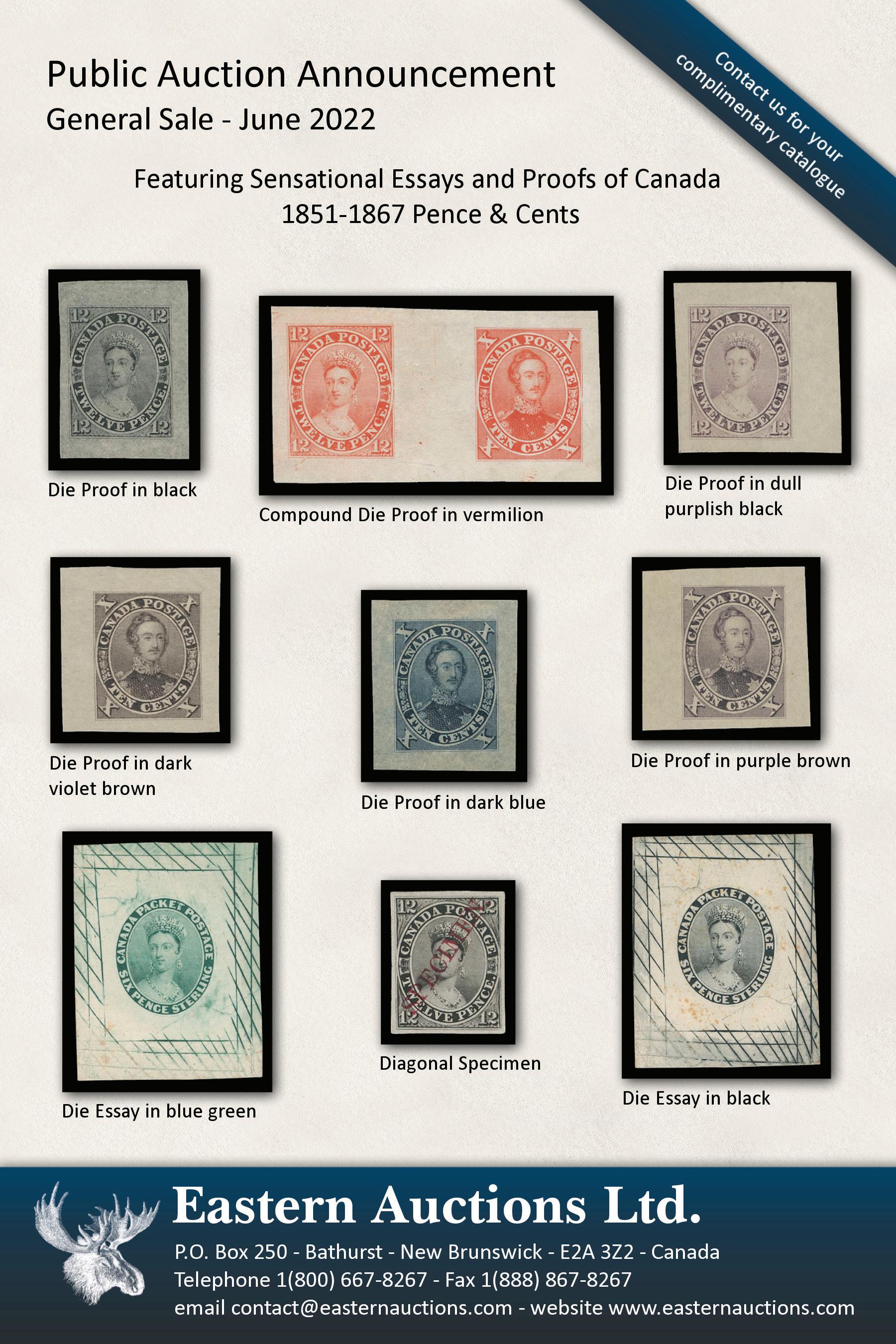
Minuteman Press is a printing company that is dedicated to the philatelic community and the growth of the hobby of philately. To honor this commitment Minuteman Press will donate $100 to the American Philatelic Society for every book quote for a job exceeding a quantity of 250 books. So, if you are in need of a book printer who cares about philately and your philatelic printing contact Minuteman Press.
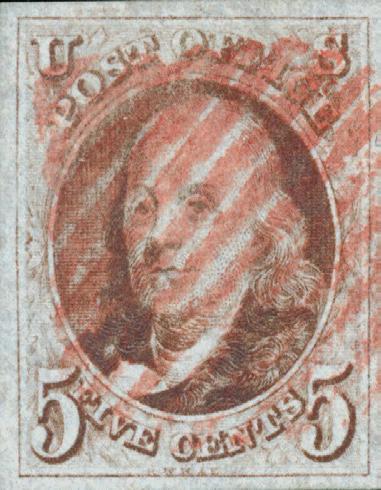
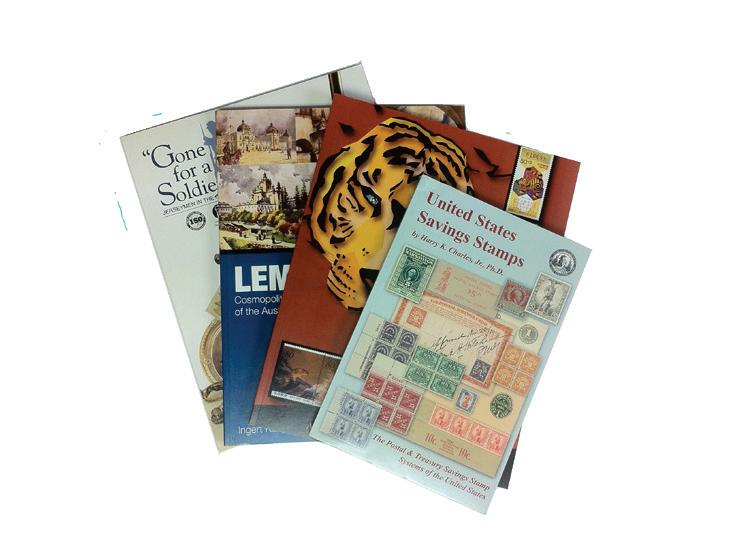
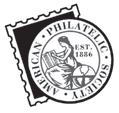
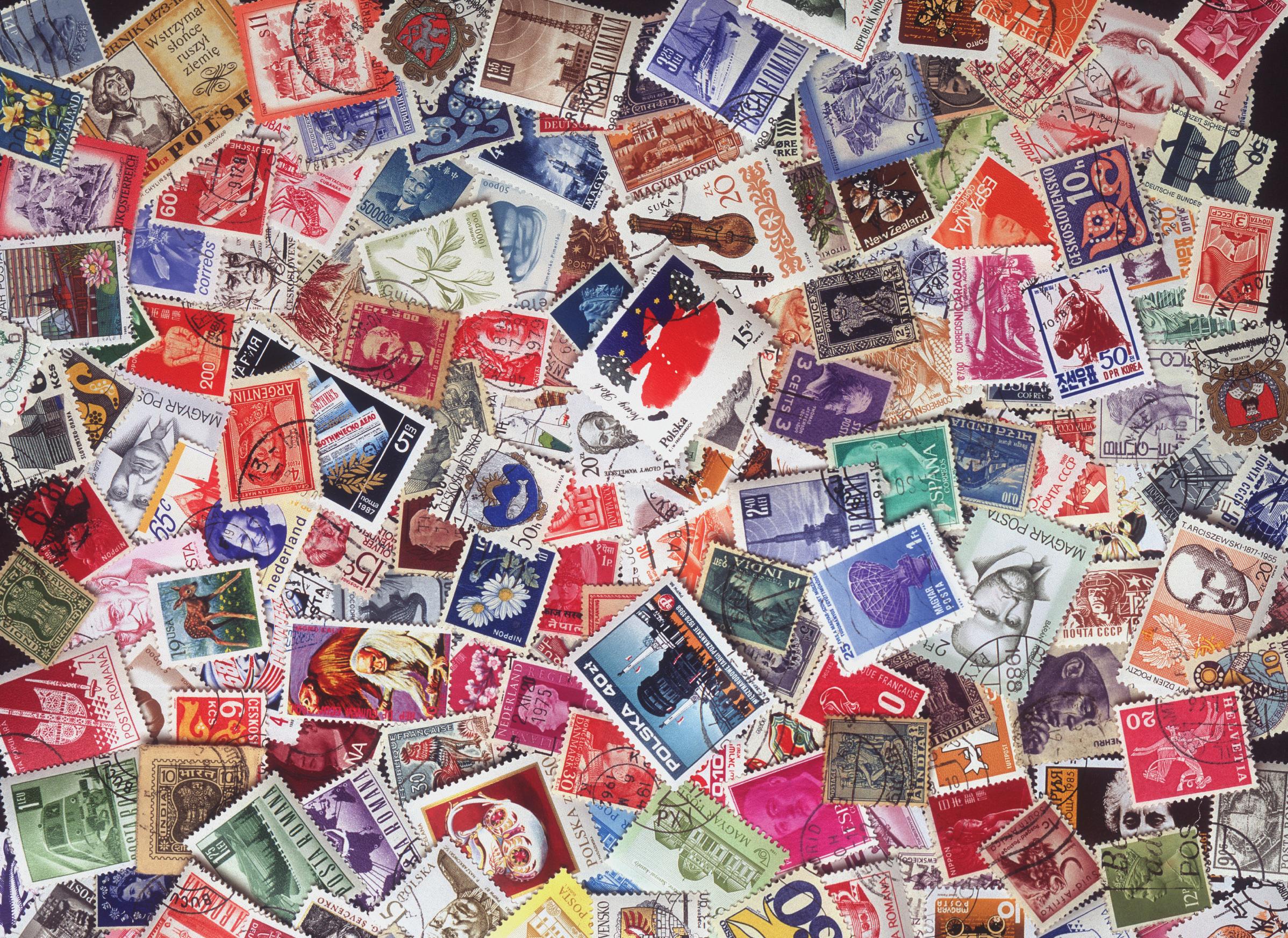

The
